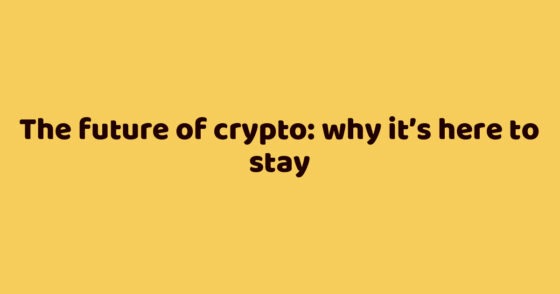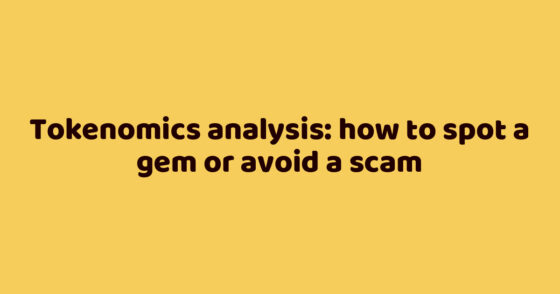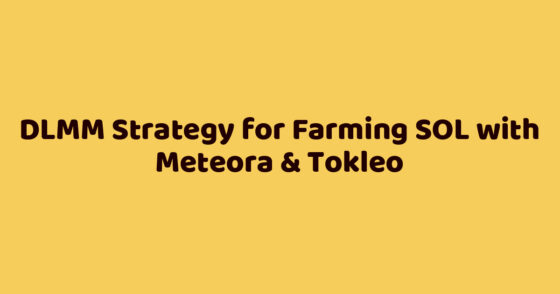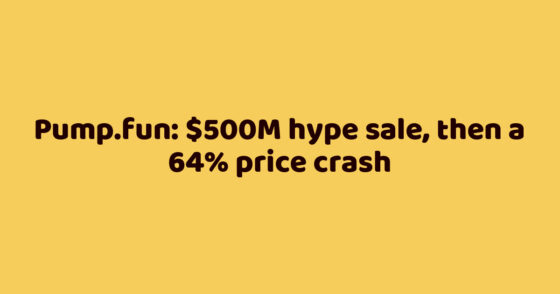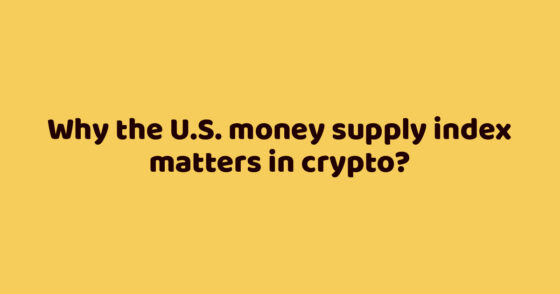Key Takeaways
● In 2024, the crypto industry experienced signicant growth, with market capitalization rising by 96.2% year-on-year (YoY), driven by strong gains in the first and fourth quarters. The launch of spot BTC ETFs in the U.S. in January marked a pivotal moment, boosting market sentiment and attracting new capital. Favorable macro conditions, including the U.S. Federal Reserve’s interest rate cut in September and positive regulatory expectations post-U.S. Presidential election, further propelled the market. Key narratives included the points meta, restaking, memecoins, AI agents, and stablecoins. Looking ahead, we are monitoring global monetary policies, regulatory changes, new ETF approvals, and the emergence of crypto-specic narratives.
● Bitcoin had an eventful 2024, bookmarked by the U.S. spot ETF approvals in January, and the breaking of the long-anticipated US$100K mark in December. The ETFs proved historically successful, attracting around US$35B in net inflows and boasting over US$105B in total assets. Bitcoin dominance exceeded 60%, a level unseen since 2021. Performance versus traditional assets remained extremely impressive, leading almost all traditional investments. On the demand side, the 4th Halving event halved annual Bitcoin issuance, while the Bitcoin ecosystem bloomed, including a 2,000%+ rise in DeFi total value locked. As we look ahead, the growing maturity of the ETFs, the incoming Donald Trump administration (perhaps aided by a Strategic Bitcoin Reserve or further corporate Bitcoin adoption), and a growing Bitcoin ecosystem around Layer 2s (L2s), Decentralized Finance (DeFi), and more, are some factors that excite us.
● In 2024, Ethereum led alt-L1s in metrics like market cap, trading volume, and DeFi TVL, while activity metrics such as daily transactions and active addresses were dominated by Solana, which also offers the lowest average transaction fee. In 2025, the U.S. Ether ETFs, the potential for more dApps in launching their own chain, the Pectra Upgrade, and Ethereum’s prioritization dilemma are key stories to consider. Solana broke fee and DEX volume all-time highs multiple times in 2024 and developer interest grew signicantly, however, stablecoins on the chain remained relatively low. Their new upcoming client, Firedancer, network extensions (i.e., Solana L2s), and SVM stack chains are important stories to follow. BNB chain saw scalability progress with opBNB and data storage development with Greeneld. Sui outgrew Aptos, while Avalanche saw its largest update yet with Avalanche9000. Tron was strong in stablecoin transactions (although saw its position challenged). TON, which slowed in H2 2024, remains important to watch, alongside the launches of Berachain and Monad.
● For L2s, 2024 was earmarked by a plethora of token generation events across both the optimistic and zero knowledge types, with over nine major L2 token launches taking place over the course of the year. It was, however, the Base L2 that stole the limelight in 2024. Despite its lack of a token, Base grew to capture 39% and 67% of the market in terms of total value locked (TVL) and daily active users respectively, Full-Year 2024 & Themes for 2025 4 making it the top L2 in both metrics. With many of the airdrop rewards now behind us, 2025 will tell which L2s can sustain user activity and capital without relying heavily on token incentives.
● 2024 has marked a robust recovery for DeFi, driven by a substantial inux of capital that propelled total value locked up by 119.7% year-to-date (YTD) to US$119.3B. This resurgence has sparked a renaissance across DeFi sub-sectors, with core areas like Money Markets and Decentralized Exchanges (DEXes) reaching new milestones. The year has been dened by the emergence of previously inaccessible on-chain nancial primitives, the narrowing gap between DeFi and Centralized Exchange (CEX)-like experiences, increased adoption by both consumers and institutions, and heightened protocol competition. Together, these developments are paving the way for DeFi to nd product-market and deliver tangible impact in the real-world.
● The stablecoins market experienced remarkable growth in 2024, reaching an all-time high market cap of US$205B and ended the year just slightly lower at US$204B, representing a 56.8% YoY increase. USDT, the leading stablecoin, saw a 50.2% increase in market cap but lost some market share to USDC, which grew by 82.4% and experienced a 3% absolute increase in market share. Ethena’s USDe, launched in December 2023, quickly became the third-largest stablecoin with a market cap of approximately US$5.9B.
● In 2024, the gaming sector experienced modest growth, with the total gaming token market cap increasing by 44%, underperforming the overall crypto market which grew by 96.2% YoY. Despite the relatively slower pace of growth, the Web3 gaming industry saw notable developments. The number of unique active wallets (UAWs) interacting with games increased by 580% throughout the year, reaching over 50 million by year-end. Additionally, hundreds of new titles were announced across major gaming ecosystems and platforms, with standout titles like “Off the Grid” bringing Web3 gaming into mainstream appeal for the rst time.
● Memecoins were the top performing crypto sub-sector in 2024 (+212%) and dominated mindshare. The top memecoins are split between Solana and Ethereum, although Ethereum still hosts the top three, including Dogecoin, which is in its fourth cycle. Solana has become the default memecoin trading chain, driven by a cohesive and unfragmented product suite and consistently cheap fees. The incredible growth of Pump.fun has also been key to the success, with the memecoin launchpad having seen 5.7M+ memecoins and over US$400M in revenue in 2024.
● AI agents, initially sparked by Truth Terminal and $GOAT, have captured the market since October and become a dominant narrative. Infrastructure providers like Virtuals Protocol (G.A.M.E. framework) and ai16z (ElizaOS framework) have been key players. The rst agents have largely focused around market commentary (aixbt) or entertainment (Luna, Eliza), with lots more in development. Swarms (groups of agents), the entry of web2 into AI agents, and the rapid development and anticipated trajectory of AI x crypto, are key areas to watch.
● While speculation-driven SocialFi platforms initially spurred user growth, 2024 became a year of consolidation for Decentralized Social (DeSoc). Daily UAWs fell from Full-Year 2024 & Themes for 2025 5 a peak of 35.0M in July to 11.3M by year-end, underscoring the persistent challenges of user retention for DeSoc products. However, dApps on social networks like Farcaster showed steadier growth, emerging as bright spots in the sector. These platforms shifted toward developer-centric value propositions — focused on front-end composability, distribution, and integration into existing UX through products like Frames and Blinks — which could play a key role in driving adoption in 2025.
● DePIN has demonstrated real-world applications in areas such as compute, telecommunication, and energy, attracting notable interest and investment. Despite a diverse landscape with 249 projects, some DePIN initiatives face challenges in generating meaningful revenue, indicating varying levels of demand.
● Web3 projects attracted a total of 1,432 investments, amassing a collective capital of US$9.2B in 2024. Of this, nearly US$4B was invested in infrastructure projects, accounting for around 44% of total funds raised in 2024. This was followed by DeFi with US$1.5B (16% of funds raised) and Games with US$0.8B (9% of funds raised).
● In 2025, eight key themes are particularly exciting to us, and we anticipate signicant progress in these areas throughout the year. These themes span various narratives and sectors, such as those related to the macro environment, Bitcoin ecosystem, articial intelligence (AI), yield-bearing stablecoins, and more.
Overview
2024 marked the second consecutive year of strength for the crypto industry, with total crypto market capitalization rising by 96.2% year-on-year, following a 108.6% rise in 2023. Notably, the crypto market surpassed its all-time high, reaching a peak of US$3.9T, before closing off the year at US$3.4T. The growth was driven by advances recorded in the rst and fourth quarters of the year, which posted gains of 59.5% and 40.7% respectively.
Figure 1: Total crypto market capitalization rose by 96.2% in 2024

The successful launch of spot BTC exchange-traded funds (ETFs) in the U.S. in January marked a pivotal moment for the industry and ushered in a period of bullish sentiment and positive ows. While the initial price reaction was muted, the following months saw strong gains as the market digested the impact of the ETFs on attracting new capital, increasing accessibility to a greater pool of investors, and reinforcing the growing acceptance of crypto as a mainstream investment.
Favourable macro conditions, spurred by the U.S. Federal Reserve’s rst interest rate cut since 2020 in September reignited investor sentiment in the latter part of 2024, driving risk assets such as equities and crypto to new highs. Sentiment was further lifted in November following the U.S. Presidential election with investors anticipating favorable regulatory shifts for digital assets, propelling total crypto market capitalization past US$3T for the rst time since 2021.
In the rst half of the year, various narratives gained momentum, including the points meta, restaking hype, memecoin frenzy, and airdrops. However, the second half was Full-Year 2024 & Themes for 2025 predominantly characterized by increased activity and attention around memecoins, AI developments, and stablecoins. These narratives are explored in greater detail in the subsequent sections of this report.
Figure 2: Timeline of notable events in 2024

Looking ahead, we are keeping a close eye on global monetary policies, post-election regulatory changes in the U.S., institutional involvement in crypto, the growing intersection of crypto and AI, and the emergence or resurgence of crypto-specic narratives. We are cognizant of the structural overhang of a large amount of upcoming unlocks in the foreseeable future, and we urge investors to do their own research. On the bright side, it is clear that market participants are increasingly aware of this trend and project teams have also experimented with novel ways to raise funds in a more equitable manner.
Layer 1s
Bitcoin
Figure 3: Bitcoin metric performance year-on-year
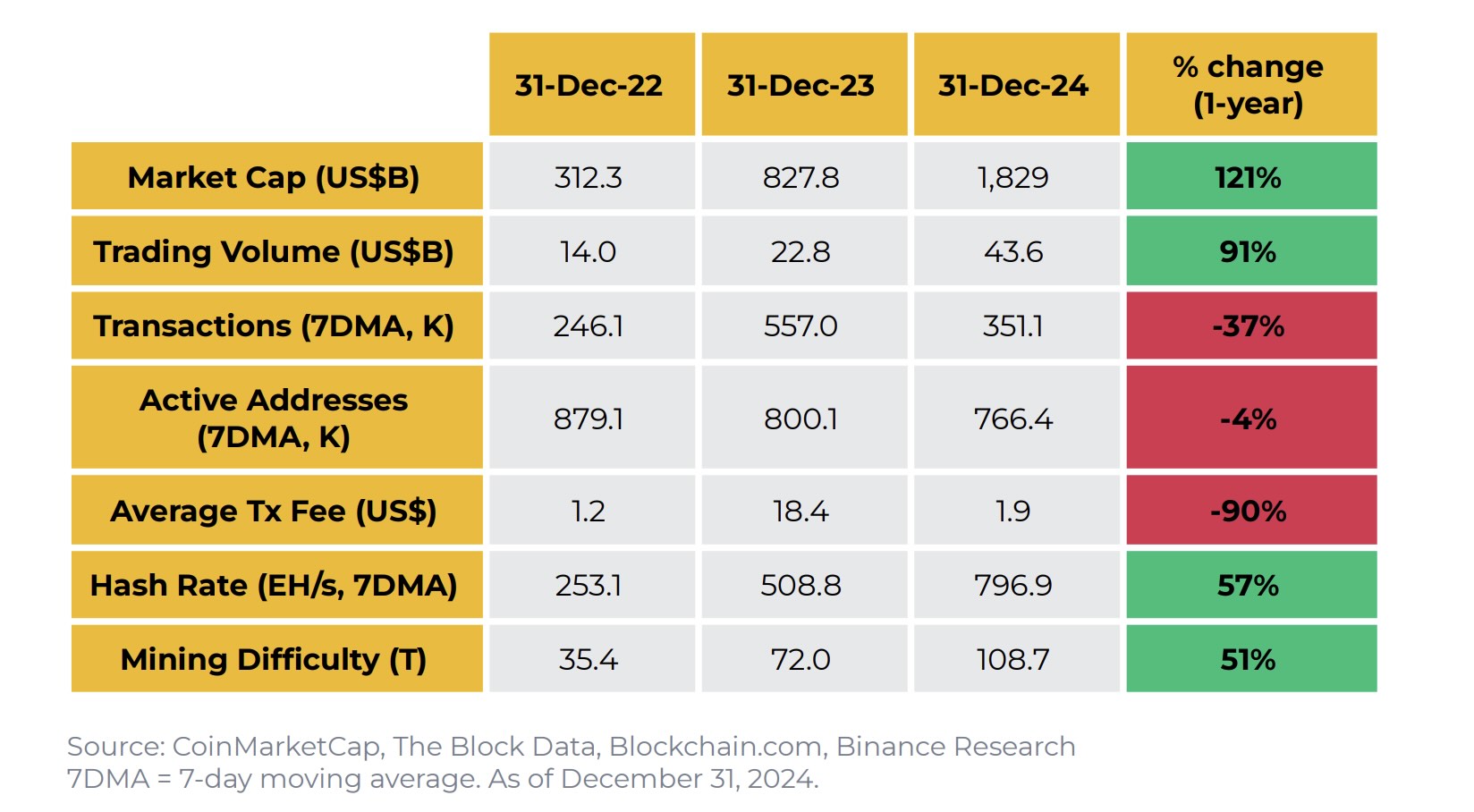
Bitcoin Dominance and Sentiment
The general sentiment around Bitcoin has continued to improve across the year, with the approval of the U.S. spot ETFs in January spreading this feeling to a wider institutional audience. This positive sentiment has been reflected in Bitcoin’s steadily increasing market dominance, which reached nearly 60% this year, a level unseen since early 2021.
As a reminder, Bitcoin dominance measures the relative market share of Bitcoin compared to the rest of the market. This is calculated using Bitcoin’s total market capitalization (market cap) over the total market cap of all cryptocurrencies combined.
Figure 4: Bitcoin market dominance reached ~60% this year, a level unseen since March 2021
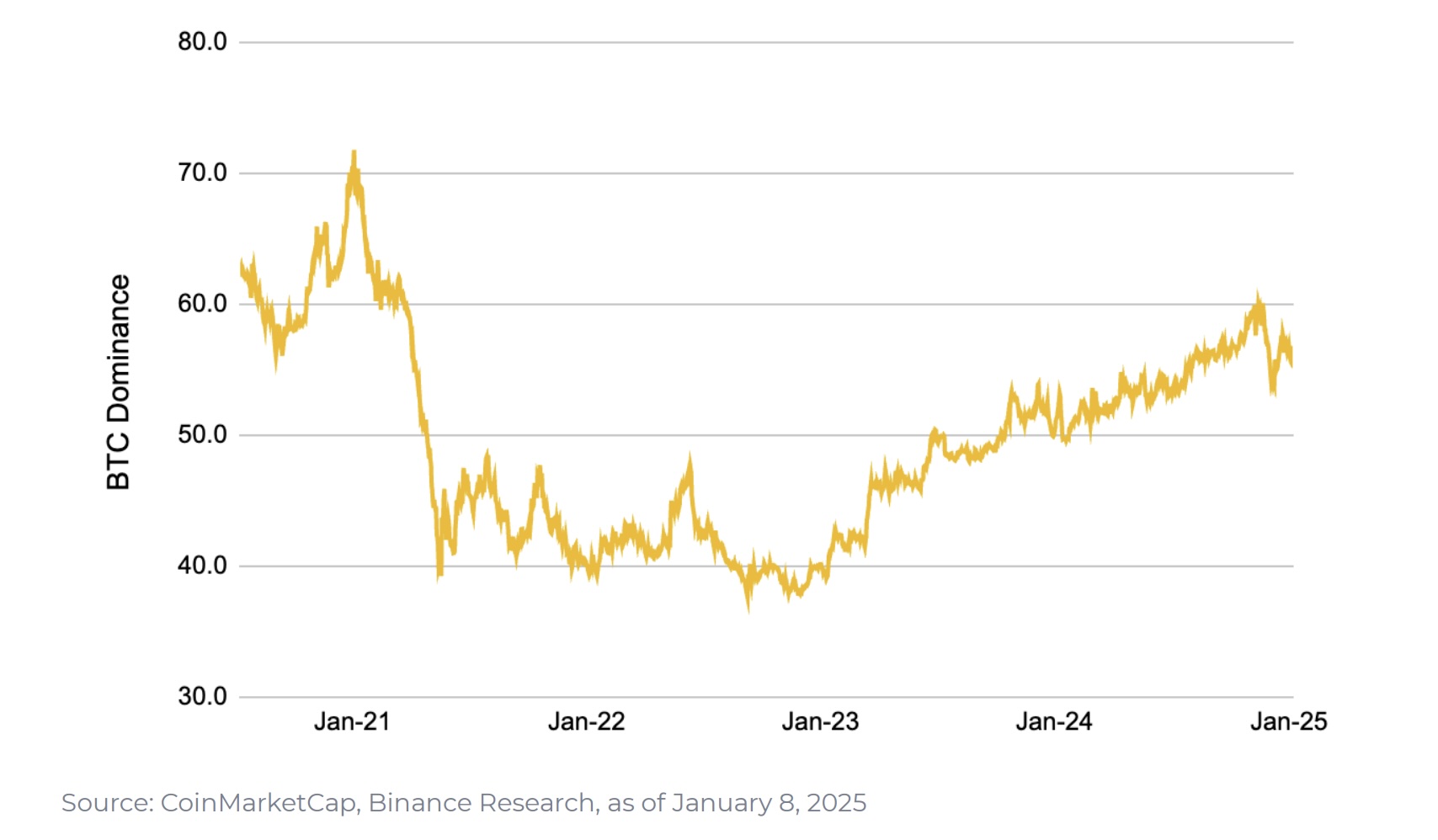
Performance Versus Traditional Assets
Comparing Bitcoin’s performance to other major investments, Bitcoin (+121% ) ranks second only to Nvidia (+173%) in 2024 returns. Solana is close behind at 86%, while Ethereum ranks among the top five at 41%. Amazon, Alphabet, and Amazon’s equities were the only other investments in our comparison group that were up over 30% in 2024.
The major stock market indexes were further behind, with some displaying single-digit returns. Gold, the commonly touted Bitcoin alternative, rose only 27% , while crude oil had a flat year. This chart highlights how incorporating Bitcoin into a portfolio can enhance diversification and improve overall performance when compared to a solely traditional asset mix.
Figure 5: Bitcoin and Nvidia led 2024 returns among a basket of major assets
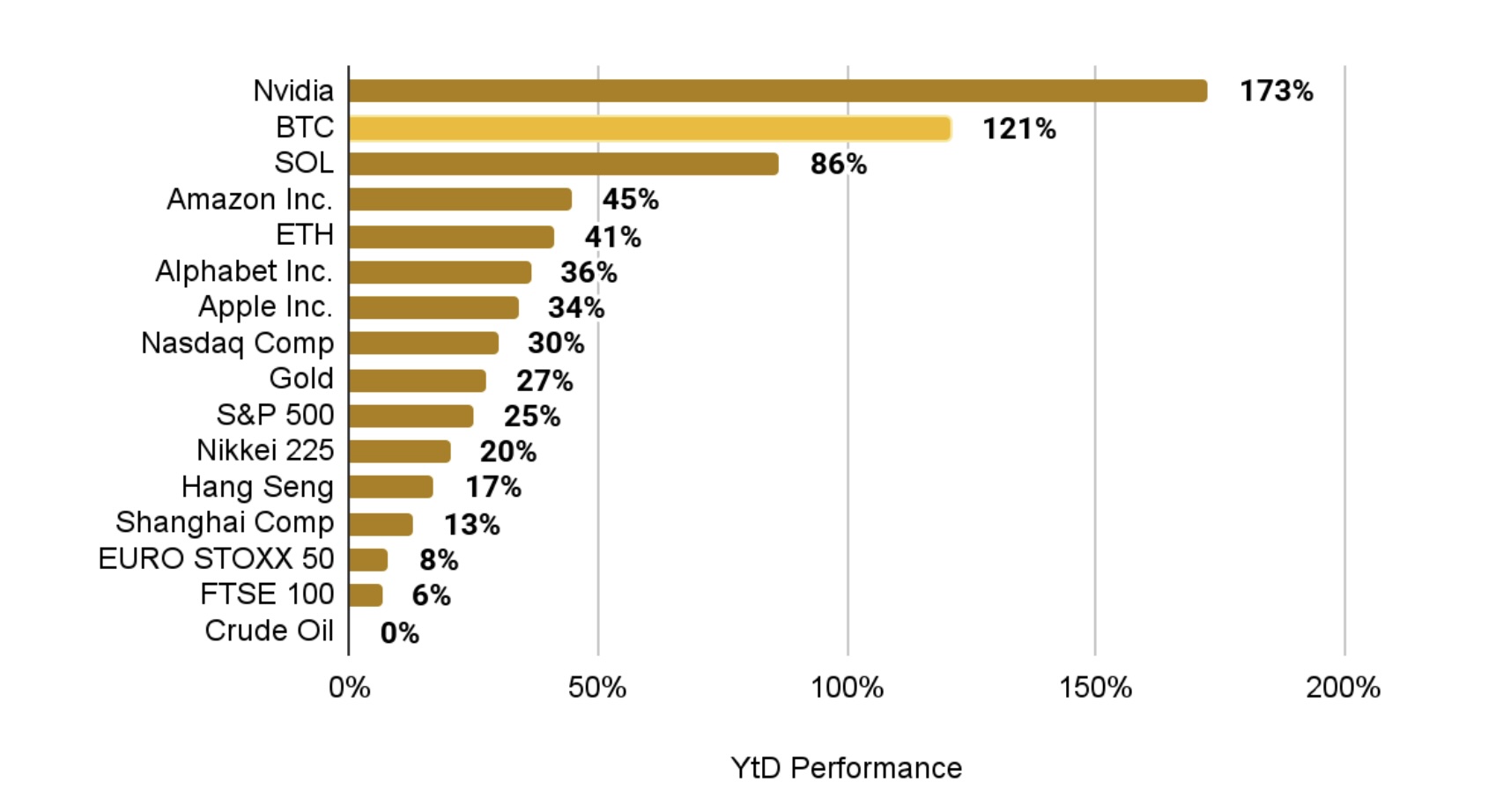
Spot ETF
One of the defining narratives of 2024 was the approval of spot BTC ETFs in the U.S. in January. These helped to add a new source of institutional demand to the Bitcoin market, a factor that has enhanced the diversity and depth of investment interest compared to previous cycles. U.S.-based institutional investors, from hedge funds to pension funds, now have a simpler, more direct, and straightforward way to access crypto markets. Since the ETF structure is familiar and comfortable for institutional investors, it is thus an ideal way to introduce conservative investors to crypto markets.
Overall, the Bitcoin ETFs have recorded US$35B+ of net inflows since the January 2024 launch, with volumes having surpassed US$650B, while total assets under management is over US$105B. November was a particularly strong month, seeing approximately US$6.5B of net inflows, including a record-breaking week from November 18–22, which brought in US$3.3B.
Figure 6: The spot Bitcoin ETFs ended the year on a high, seeing over US$11B of net inflows in November and December
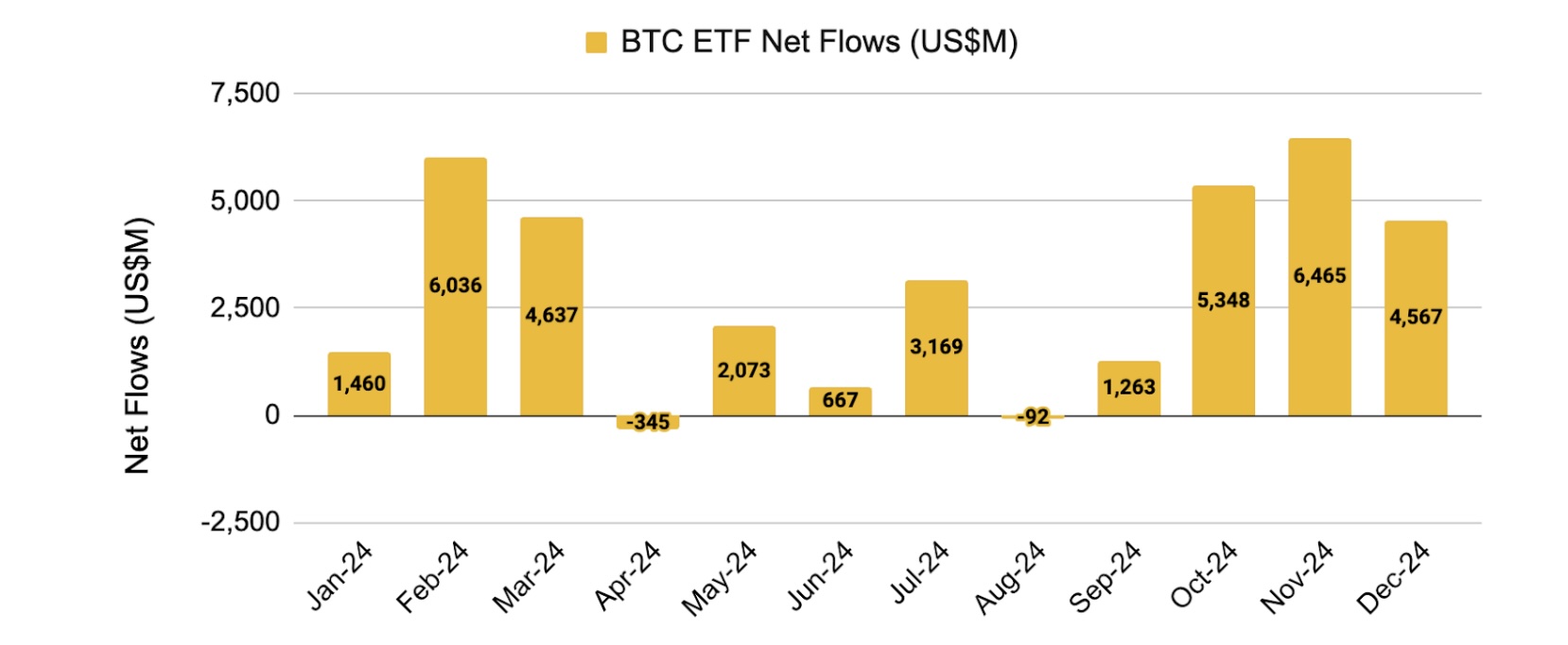
This surge in adoption is led by BlackRock’s iShares Bitcoin Trust (IBIT), which boasts over US$37B in cumulative inflows and ~US$50B in assets, commanding nearly 50% of the market. Fidelity’s offering follows as the second largest, managing US$24B in assets from US$12B in net inflows. Together, these two giants dominate the Bitcoin ETF space, reflecting growing institutional confidence and interest in crypto investment products
Figure 7: BlackRock, Fidelity, and Grayscale command the majority of the U.S. spot BTC ETF market by AUM
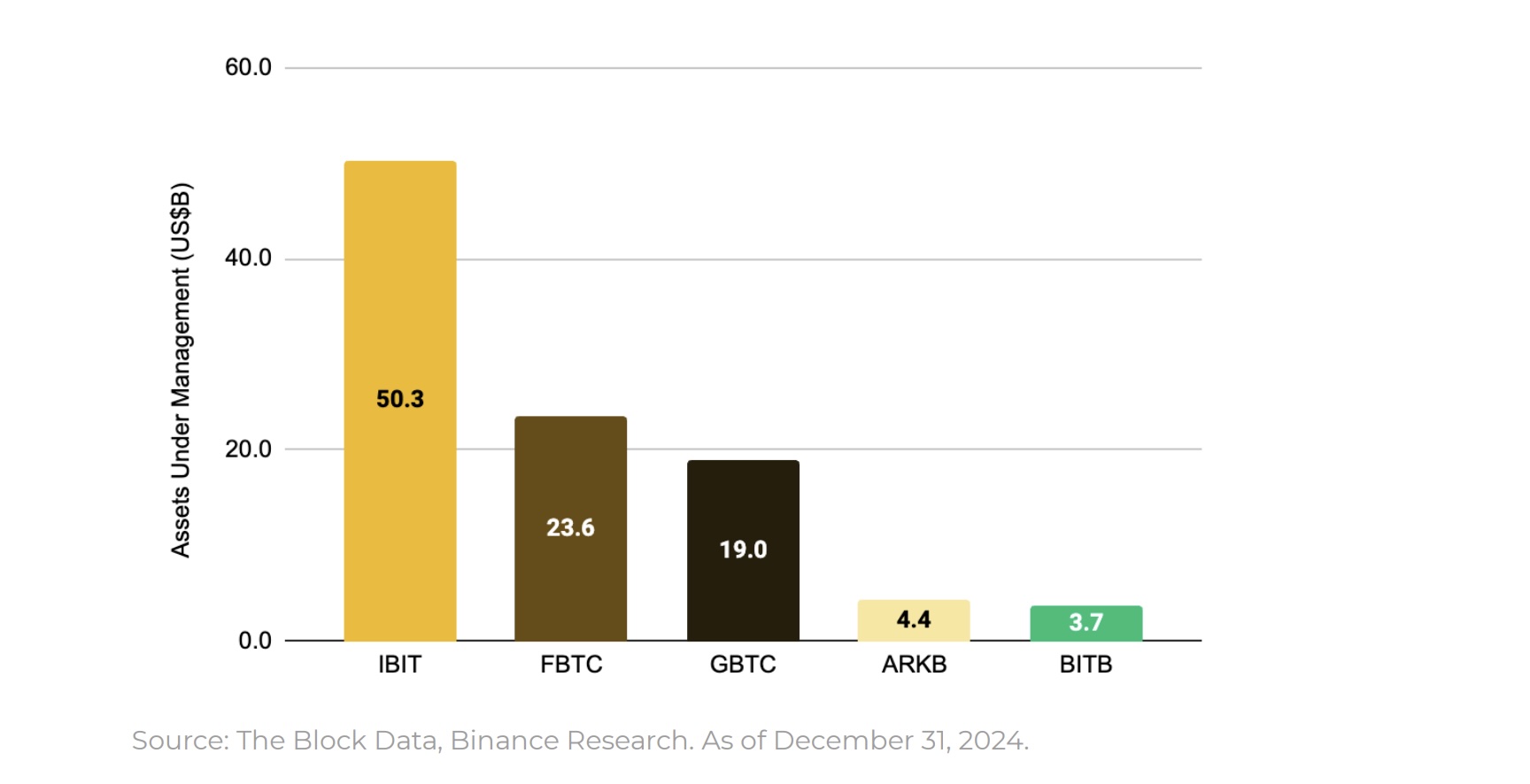
Interest has also spread internationally. Hong Kong approved spot Bitcoin and Ether ETFs in April 2024, marking progress despite relatively limited volumes compared to the U.S.. Meanwhile, European crypto ETPs — roughly equivalent to U.S. spot ETFs and available since 2015 — are experiencing significant growth, with total AUM rising ~97% from ~US$9B in 2023 to over US$17B in 2024.
Two key factors could drive bullish momentum for Bitcoin ETFs in 2025. First, the one-year anniversary of U.S. spot ETFs marks a potential turning point. While traditional investors were initially cautious when onboarding crypto, the performance in 2024 has likely built confidence. This could prompt more investors to diversify into Bitcoin ETFs in the coming months.
In addition, the recent presidential victory of pro-crypto Donald Trump has heightened bullishness across the U.S. (especially with regards to Bitcoin). Following this sentiment, Bitcoin broke the US$100K mark, with ETF flows reaching yearly highs after the election victory. We may see more of this sentiment come through in the coming months which may result in further traditional investor involvement. With a relatively low barrier to entry, Bitcoin ETFs offer traditional investors a simple way to dip their toes into crypto. As a result, we expect ETF flows to continue growing .
The Halving
Bitcoin operates on a fixed issuance schedule, a key feature of its appeal. A set amount of Bitcoin is rewarded to miners for validating each block, known as the block reward. Every 210,000 blocks — approximately every four years — this reward is halved, reducing the rate of new Bitcoin issuance by 50%.
This event, called the “Bitcoin Halving,” is a pivotal moment in the crypto world. As Bitcoin has a capped supply of 21 million, the halving plays a critical role in its monetary policy, with significant implications for miners, investors, and the broader market. For a deeper dive, check out The Future of Bitcoin #1: The Halving & What’s Next .
Figure 8: Bitcoin’s block reward has decreased from 50 BTC per block to 3.125 BTC per block across its first four Halving events
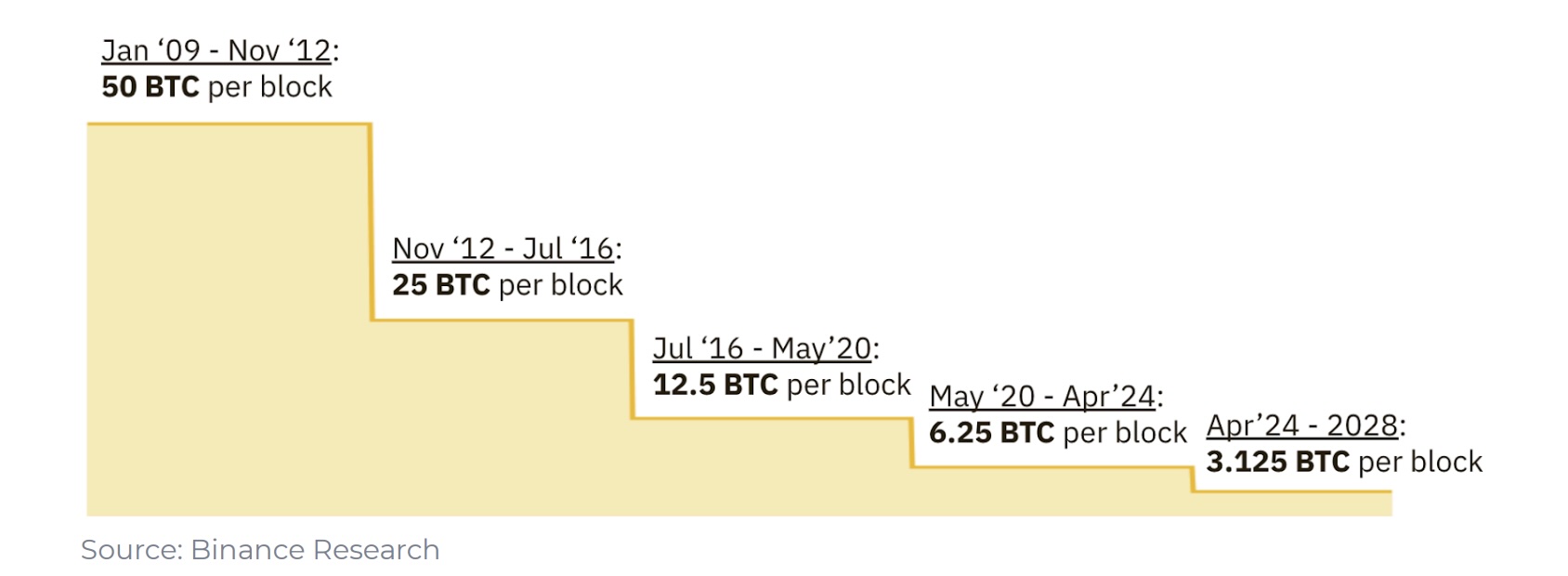
Given that Bitcoin miners derive the majority of their income from the block reward, the Halving represents a direct ~50% reduction in their income. This has major revenue implications for miners and has historically led to some level of revenue diversification and industry consolidation. Since the April 2024 Halving, we have observed an increasing trend of miners diversifying into providing AI and high performance computing (HPC) infrastructure, as well as, larger miners attempting to acquire or merge with smaller competitors. We will likely see a continuation of this in 2025, especially with regards to providing AI-related computational power and services.
The Halving likely doubles as a global campaign emphasizing Bitcoin’s inflation-resistant, self-enforced monetary policy. It highlights Bitcoin’s fixed supply and growing demand, drawing attention to its scarcity. At a time when Bitcoin is more accessible to investors than ever, the Halving reinforces its unique value proposition.
Figure 9: Each Halving event has been followed by strong BTC performance in the 6-12 months following the event

Bitcoin Ecosystem
While Bitcoin’s traditional utility has largely revolved around it functioning as a form of digital gold due to its immutable monetary policy and fixed supply in a world of ever-inflating fiat currencies, things are changing. Developers have long aimed to expand Bitcoin’s utility, with significant progress seen in 2023 and 2024.
Ordinals & Runes: Casey Rodarmor’s “Ordinal Theory” enabled the tracking of individual Satoshis (the smallest unit of Bitcoin), and ascribed a unique identifier to every single one. These individual Satoshis were then able to be “inscribed” with arbitrary content such as text, images, and videos. This created an “Inscription” or what soon became known as a Bitcoin NFT. Initially launched in late 2022, these saw significant attention across 2023.
In late 2023, the BRC-20 standard was introduced, enabling the deployment, minting, transfer of Ordinal-linked fungible tokens on Bitcoin. Building on this development, the Runes Protocol launched in April 2024, coinciding with the Bitcoin Halving. Created by Casey Rodarmor, Runes offer another approach to creating fungible tokens on the Bitcoin network.

Since the initial launch in December 2022, over 75M Inscriptions have been minted on the Bitcoin blockchain, generating over 6,970 Bitcoin (~US$692M) in fees.
Figure 11: Monthly Bitcoin Inscriptions have declined significantly since the highs of 2023

Since their launch, Runes and BRC-20 transactions have accounted for over 49% of Bitcoin’s transaction activity on average. While standard Bitcoin transactions still dominate, new Bitcoin markets have contributed to increased activity and fee revenue.
Figure 12: Runes have represented 49% of all Bitcoin transactions, on average, since their launch in April
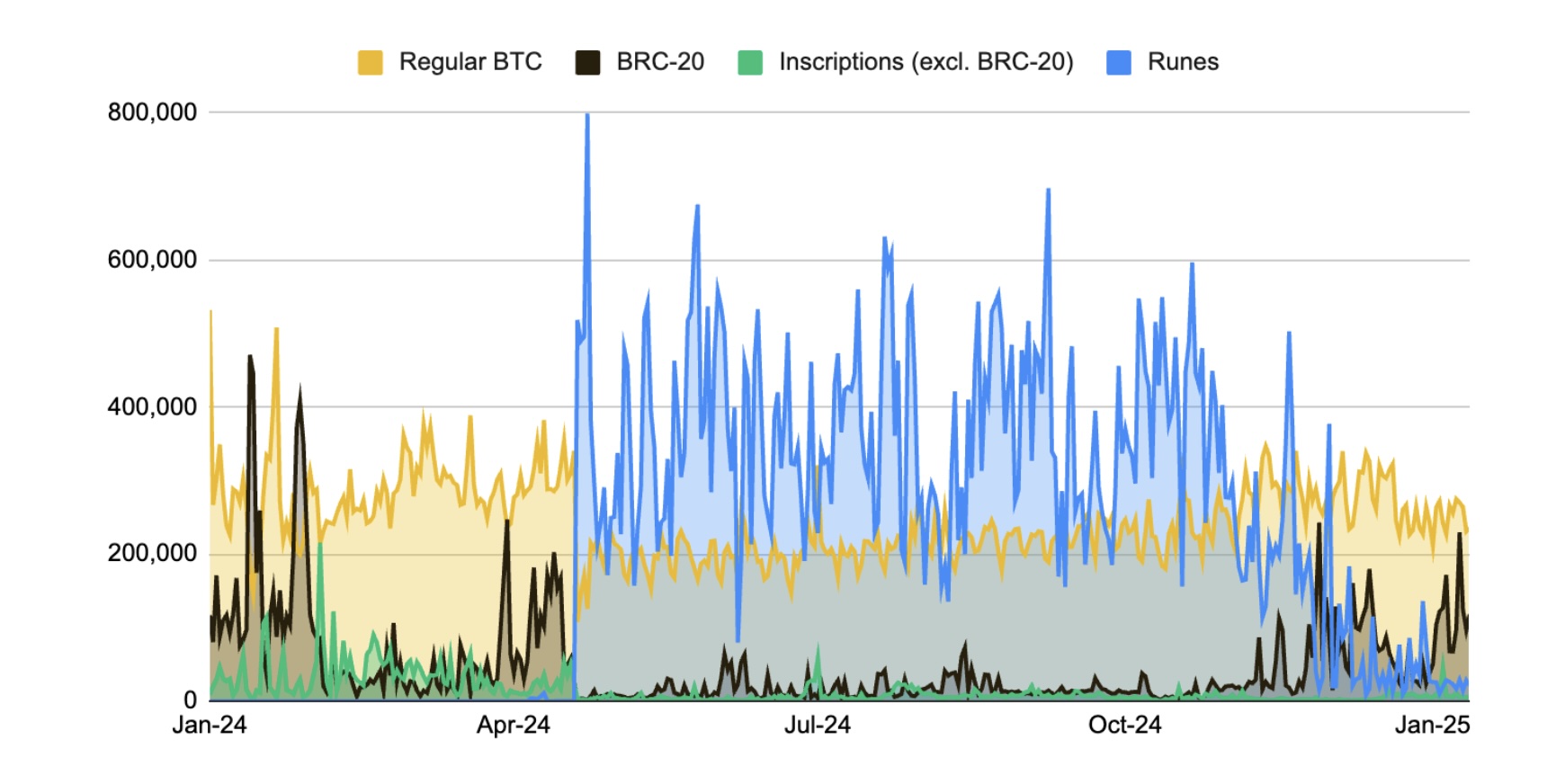
While not a game changer, the additional hundreds in millions in fees that Inscriptions, BRC-20s, and Runes have generated are surely welcome. This is especially important in light of the recent Bitcoin halving. As a reminder, Bitcoin miners are compensated in two different ways: block rewards and transaction fees, with the block rewards halving every four years. The April 2024 halving reduced this from 6.25 BTC to 3.125 BTC. Thus, an increase in transaction fees is required in order to sustain the miners, given the block reward will eventually reduce to zero.
Layer 2s (L2s): One of the indirect effects of Ordinals, BRC-20s, and Runes has been the ushering in of a new renaissance for Bitcoin expressivity. However, an issue arises due to the inherent technical limitations of Bitcoin, which does not support smart contracts in the same way as alt-L1s like Ethereum, Solana, and BNB Chain does. What this means is that a lot of work is being done on creating alternative layers for Bitcoin expressivity, i.e., Bitcoin L2s.
Various teams are working on solutions, including long-standing teams such as Lightning Network, Stacks, and RGB. Newer teams are also emerging with innovative solutions, including Citrea and Merlin’s Bitcoin zk-rollups.
While some teams have launched testnets, many are still in the development phase. We expect to see further launches and traction in 2025.
Also worth mentioning is the introduction of BitVM and BitVM 2. BitVM’s goal is to scale the Bitcoin network through introducing smart contract capabilities, without requiring significant changes to Bitcoin’s existing infrastructure. BitVM operates somewhat similarly to how we understand optimistic rollups on other L1 chains. Development around this protocol may help expand Bitcoin’s capabilities far ahead of where they are now, and also help create a more secure way to bridge BTC to secondary layers. Although it is relatively early in BitVM’s history to see where it will go, this is an important area to keep up with through 2025.
DeFi: The Bitcoin DeFi or BTCFi space is another to keep a close eye on. 2024 was a breakout year for the sector, with TVL growing by over 2,000% from US$0.3B to over US$6.5B, cementing Bitcoin’s place among the top five DeFi chains.
Figure 13: Bitcoin DeFi total value locked (TVL) grew by over 2,000% in 2024
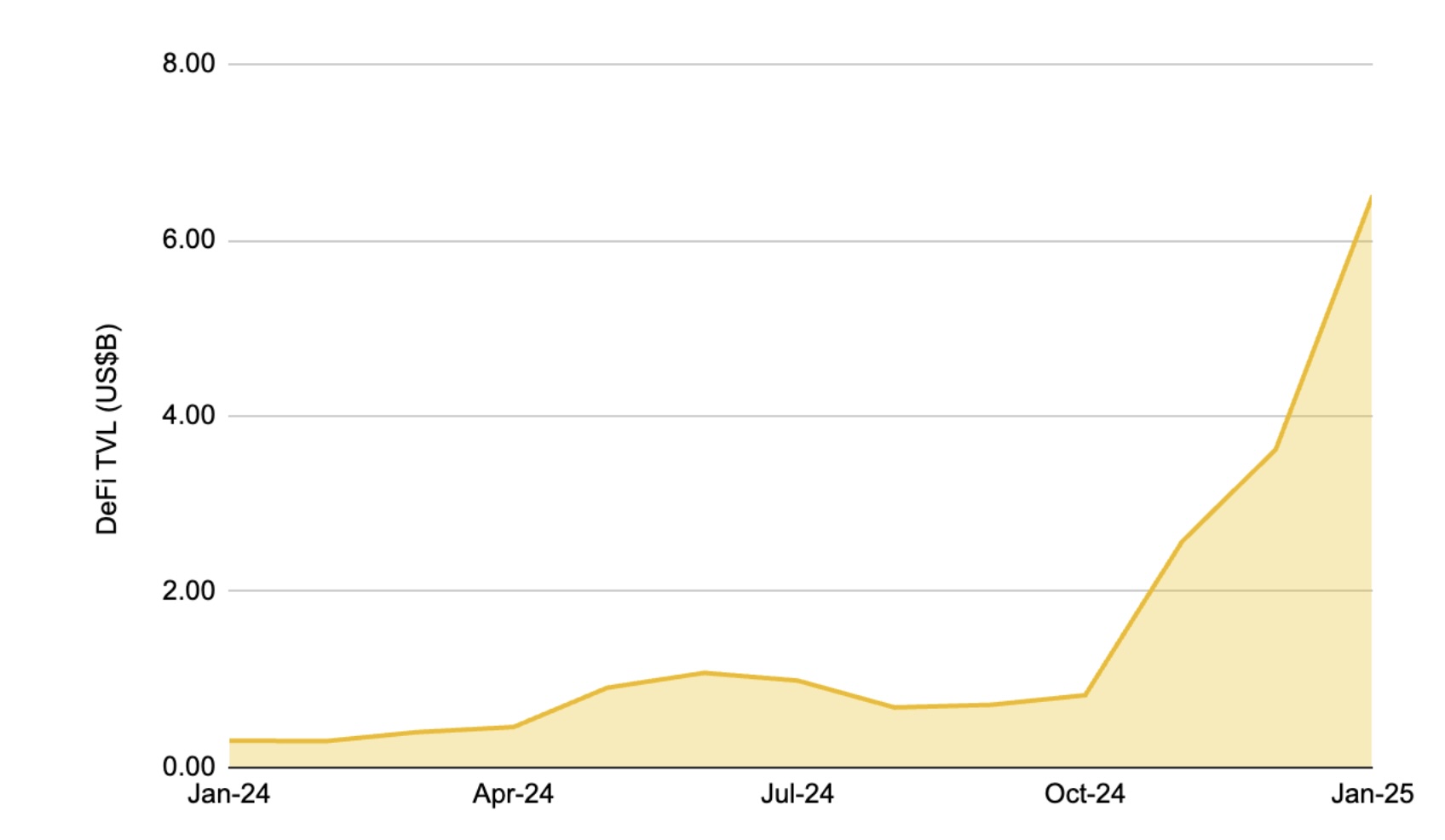
Numerous new BTCFi projects have either launched in the last year, or are currently being funded and developed. A significant amount of TVL is associated with the Bitcoin restaking platform, Babylon, which commands ~82% of the BTCFi market. Babylon utilizes a timestamping protocol in order to leverage the immense crypto-economic security of Bitcoin to secure other proof-of-stake (PoS) chains.
Various other projects, from Bitcoin money markets, to Bitcoin DEXes & AMMs are also in different stages of development. We are likely to see this activity continue to bump up across 2025, with many more product launches expected.
What may 2025 bring?
There are a number of catalysts for Bitcoin (and the broader crypto ecosystem) as we head into 2025. A key driver here is the U.S. and what is expected from the incoming Donald Trump government.
Given Donald Trump has multiple NFT collections and a DeFi project, and a record number of pro-crypto have been elected officials across the House of Representatives and Senate, U.S. crypto regulation developments are expected in 2025. Enacting clear regulation of digital assets is expected to bring more clarity to TradFi institutions and benefit existing crypto ETFs and potentially allow for more to be created.
Taking into account the U.S.’ major position across global financial markets and improved sentiment towards crypto, similar developments in many other countries across the world are expected to follow. Focusing specifically on Bitcoin:
Strategic Bitcoin Reserve: This was a product of Senator Cynthia Lummis’ bill to create such a reserve in the U.S. and has been mentioned numerous times by Donald Trump during his Presidential campaign trail.
Interestingly, a number of different U.S. states are working on their own legislation to create Bitcoin reserves on a state-level. This includes Pennsylvania, Florida, Ohio, and Texas.
Perhaps even more importantly, the issue is being discussed in various nations globally. There has been discussion and bills proposed in Brazil, the Czech Republic, Poland, Russia, with speculation in other countries including China.
There has been a rise in corporate Bitcoin adoption, with many firms joining MicroStrategy in adding Bitcoin to their treasuries. This includes the likes of Semler Scientific, Metaplanet, Genius Group, etc. Many Bitcoin miners, including Riot and Marathon, have also been purchasing more Bitcoin for their treasuries, while others like streaming company Rumble are also considering implementing the strategy.
More Ecosystem Development: As we mentioned previously, there is significant traction across Bitcoin L2s, Bitcoin DeFi, and other parts of the ecosystem. With increasing global attention on the largest cryptocurrency, as well as increasing flows from traditional investors (owing to the ETFs), we expect to see further development across the broader Bitcoin ecosystem in 2025.
Bitcoin Improvement Proposals (BIPs): BIPs are formal proposals sent to the Bitcoin community describing potential new features that could be added to Bitcoin. For example, Bitcoin’s last two major upgrades, SegWit (2017) and Taproot (2021) implemented a number of BIPs into Bitcoin. These upgrades were essential to the creation of Ordinals, BRC-20s, and Runes.
An important BIP to track is BIP-347, which seeks to implement OP_CAT to Bitcoin. To put it very simply, OP_CAT can allow Bitcoin to combine two pieces of data during a transaction, potentially unlocking smart contract capabilities across the network. OP_CAT is one of many “covenant” proposals, which create additional conditions and rules around how Bitcoin can be spent, thereby creating the possibilities for more advanced logic within the network.
Although Bitcoin traditionally moves very slowly and carefully, covenants have been discussed for over ten years and have received renewed attention over the last couple of years following the Ordinals-led boom. It will be interesting to watch if one or more new BIPs can be introduced or at least gain further traction across 2025
The Other L1s
Figure 14: A summary of where things stand for the major L1s at the end of 2024
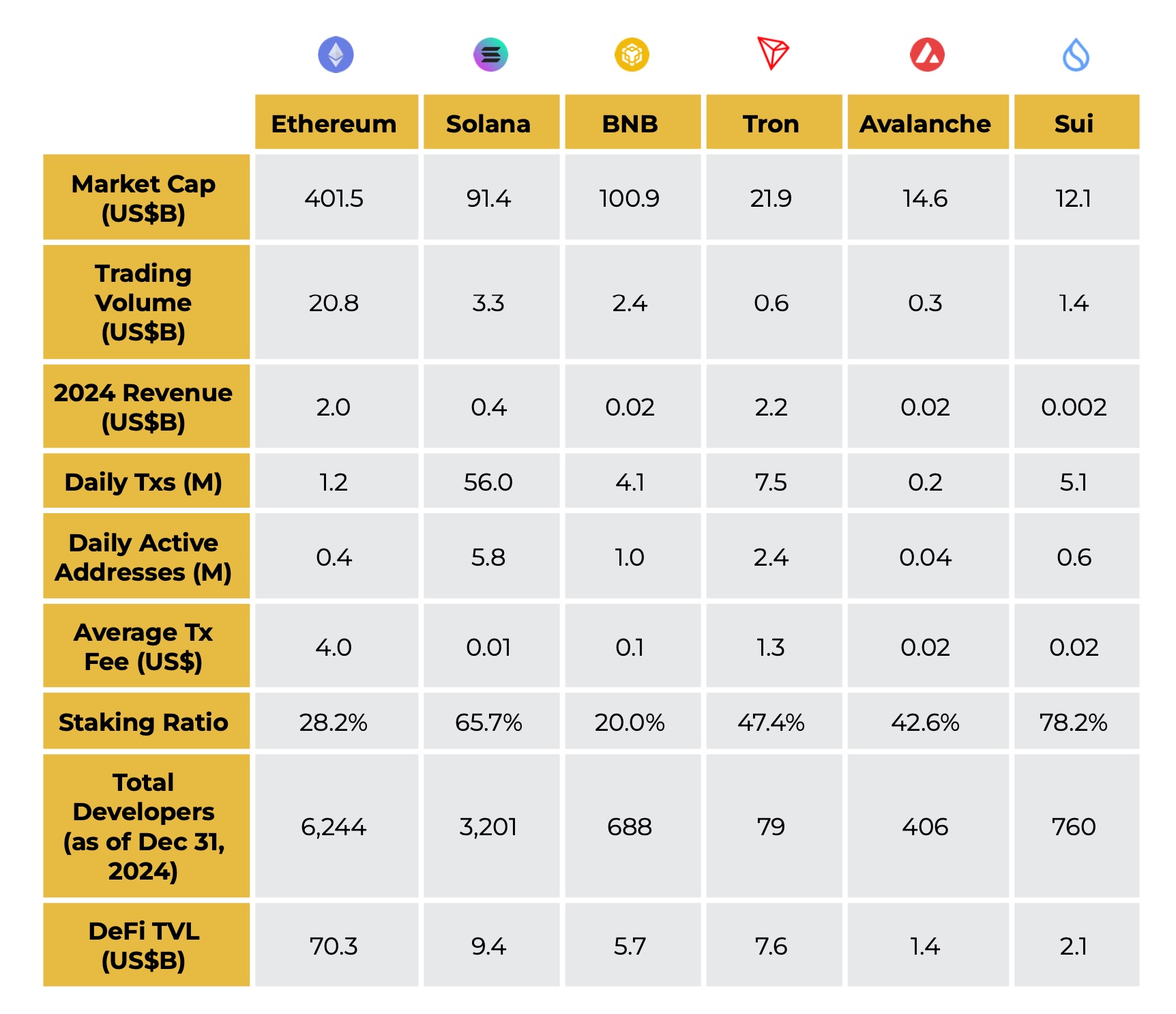
When looking at the high-level metrics, it is clear that Ethereum remains in a position of strength and leads on numerous fronts including market cap, trading volume, DeFi TVL, and total developers. On the other hand, activity metrics such as daily transactions and active addresses are dominated by Solana, which also offers the lowest average transaction fee. Developer numbers are interesting to note, with Ethereum leading by a large margin, followed by Solana with roughly half of Ethereum. BNB Chain, Sui, and Avalanche show comparable numbers, while Tron’s developer community remains smaller. Tron led on 2024 revenue, no doubt helped along by its dominance in stablecoin transactions.
Ethereum
Ethereum had an interesting 2024. There were some interesting developments with regards to restaking, its growing rollup universe, and the U.S. spot Ether ETFs. At the same time, Ether as an asset significantly underperformed against other major bluechips like Bitcoin and Solana, and the majority of the top 30 tokens by market cap.
Figure 15: Current ETH Performance Lags Behind Previous Market Cycles
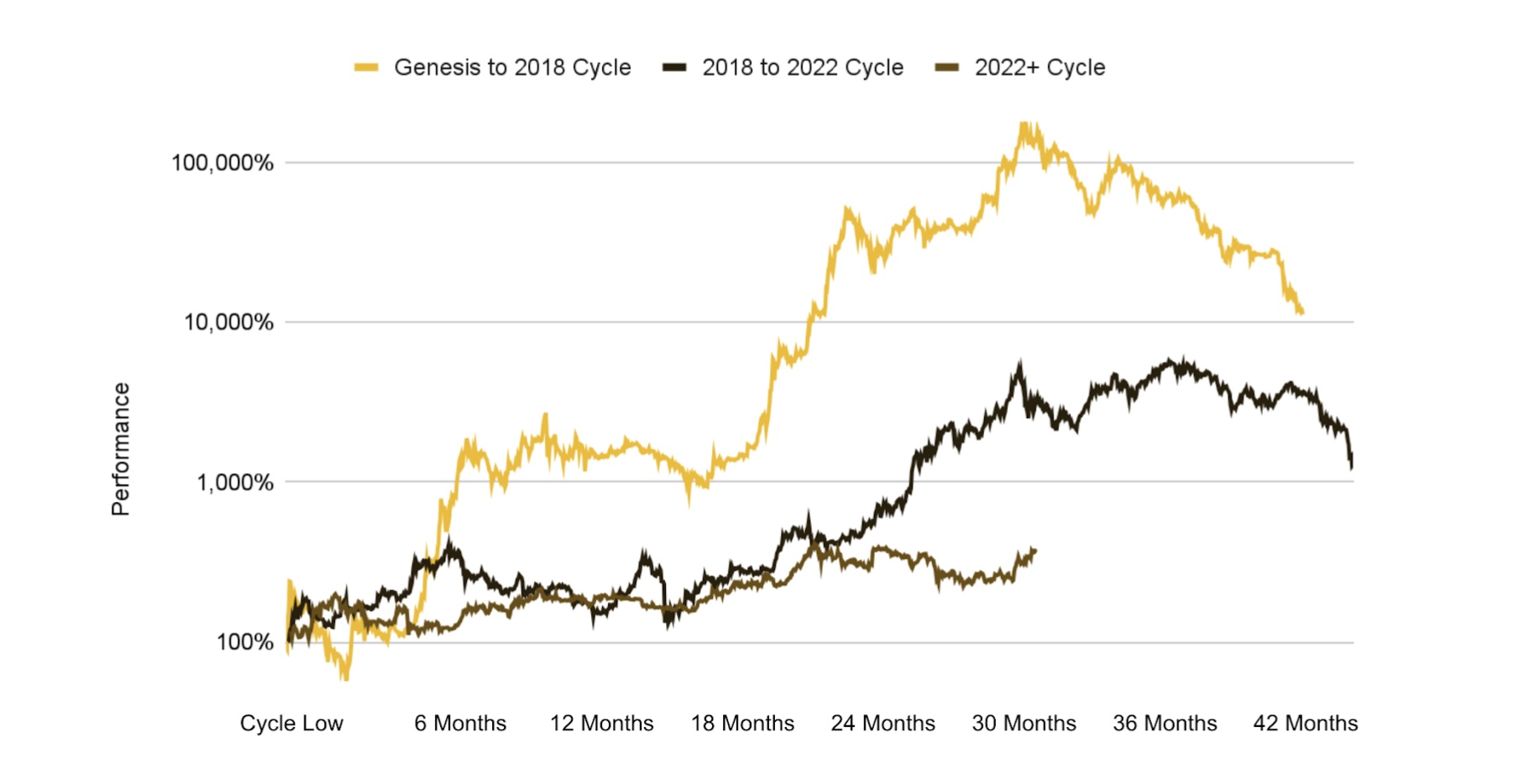
The Impact of Dencun
Ethereum’s Dencun hard fork went live in March 2024, introducing various changes to the network. The most anticipated was EIP-4844 (a.k.a. proto-danksharding), allowing users to benefit from lower gas fees on L2 transactions. This was a major milestone for Ethereum’s road to scalability and lays the groundwork for full danksharding in the future.
Specifically, EIP-4844 introduced “blobs,” which provide L2s with a more gas-efficient way to post transaction data. Blobs drastically reduced fees for posting data to Ethereum’s L1, enabling L2s to support higher transactions per second (TPS) and attract increased user activity. Blobs achieve this by storing the bulk of data off-chain and employing a pricing mechanism called “blob gas” that operates independently from Ethereum’s gas market. Additionally, data is stored temporarily for around two weeks rather than permanently.
Figure 16: L2s are capturing a growing share of transaction activity
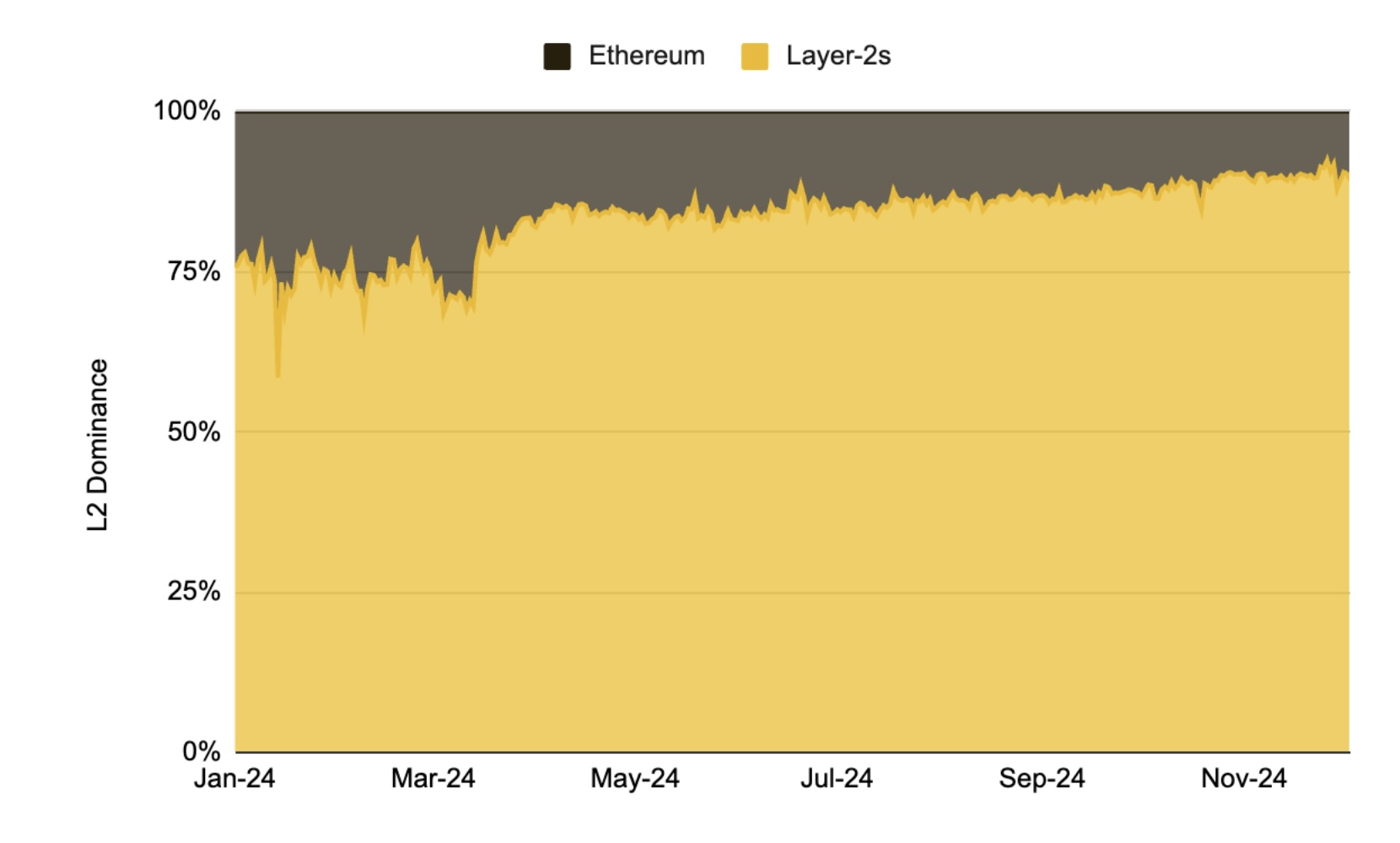
While the growing adoption of L2s demonstrates the success of Ethereum’s rollup-centric roadmap, it also had a reverse effect. Critics argue that as L2s capture a larger share of transaction and user activity, economic value is being redistributed, shifting away from Ethereum’s L1.
The evidence for this criticism is clear when we consider Ethereum’s transaction fee revenue, which has taken a notable hit. In fact, Ethereum’s fee collections have reached their lowest levels in years, despite the ongoing bull market and increased activity.
Figure 17: Following Dencun, Ethereum network fees have trended generally downward
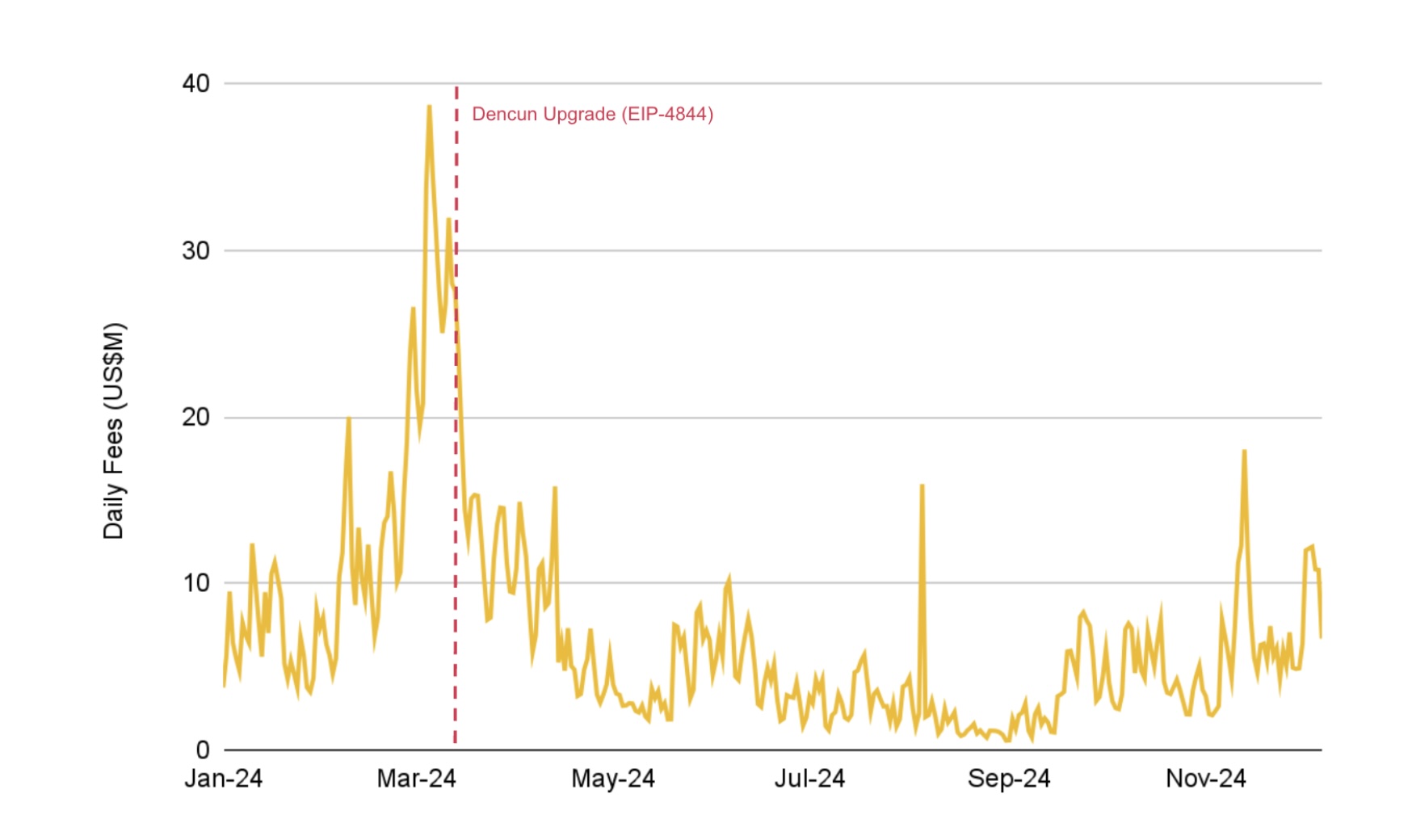
There is also the matter of increasingly fragmented liquidity driven by the plethora of Ethereum L2s. Due to general interoperability challenges across crypto, this has contributed to somewhat complex user experiences. For example, how does one explain the difference between Arbitrum USDT, Base USDT, zkSync USDT, and the fact that these are all a form of Ethereum USDT to crypto newbies?
Other than newbies, some seasoned crypto users even expressed fatigue with the sprawling Ethereum L2 ecosystem. In contrast, monolithic and fully integrated alt-L1s, where dApps operate in shared environments and offer Web2-like experiences, have gained traction i.e., Solana. It remains to be seen whether L2s will continue their momentum in 2025 or if attention will shift back to Ethereum L1.
The End of Ultrasound Money?
Lower transaction fees have also impacted ETH’s inflation dynamics. Ethereum’s supply is governed by issuance, staking rewards, and the fee burn mechanism (EIP-1559). “Ultrasound Money” has been a long-standing narrative of many in the Ethereum and EVM communities, whereby the burn effect of EIP-1559 will outweigh the issuance of ETH, making it a deflationary asset. The “ultrasound” is a play on what is often referred to as
Bitcoin’s “sound” monetary policy, which ensures consistent supply. The idea is that Ethereum will be ultrasound as it will be deflationary.
This was initially observed through many parts of 2023, following The Merge in 2022, when Ethereum transitioned to proof-of-stake. However, with reduced fees following the Dencun Upgrade, the ETH burn rate has declined, reversing many of the deflationary trends observed 2023. In fact, ETH issuance reached ~0.74% annually in September, a high not seen in two years, dampening the ultrasound money narrative that many in the Ethereum community pushed in 2022 and 2023.
Figure 18: After Dencun, daily issuance consistently outpaced burns, causing ETH’s 30-day annualized inflation to turn positive
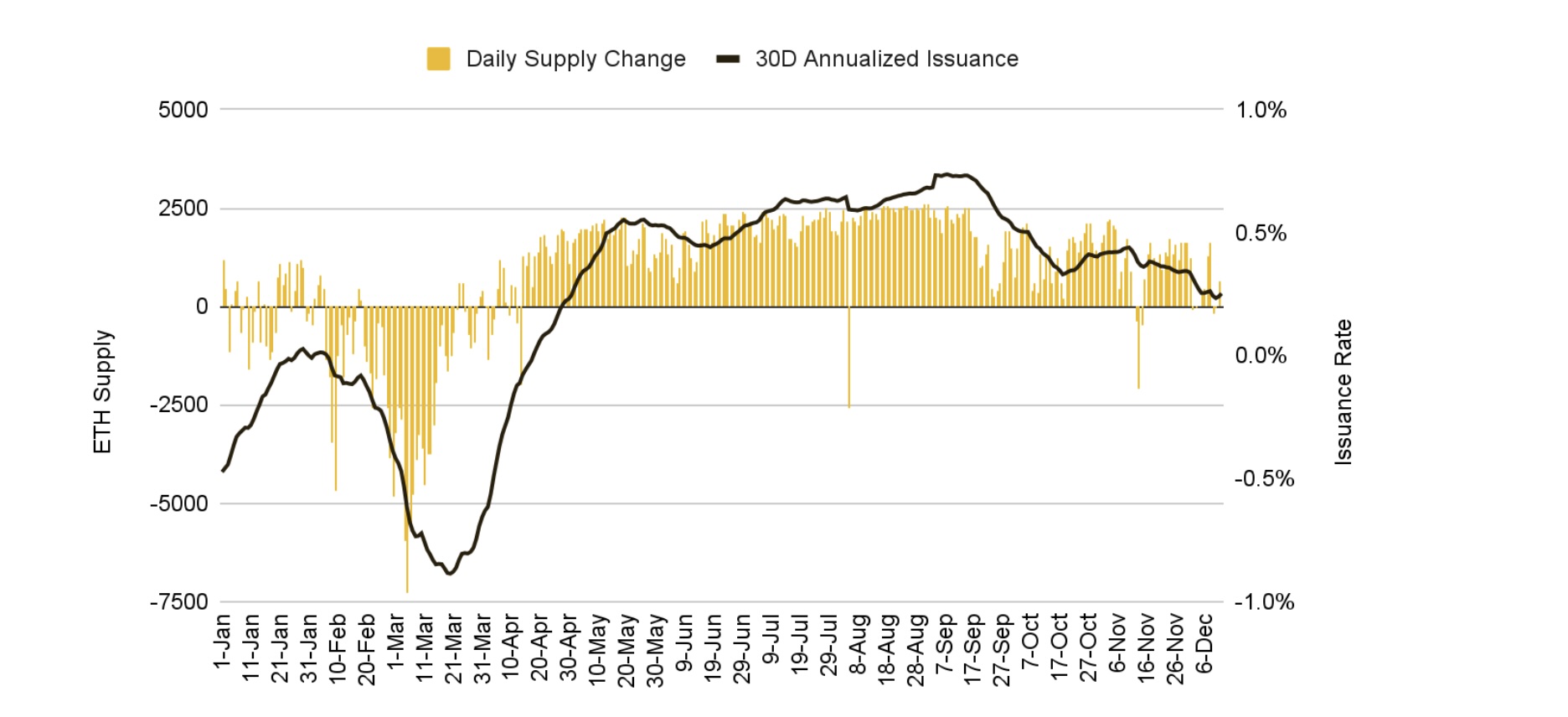
Nonetheless, while recent changes have impacted ETH inflation, such trends should be expected during scaling transitions that increase blockspace supply faster than demand. Ethereum’s issuance rate remains below 1%, far lower than most alt-L1s. Furthermore, cyclical market activity should naturally restore the burn mechanism as demand picks up – something we have started to see in recent weeks. The key risk, however, lies in Ethereum’s ability to maintain consistent blockspace demand across cycles, particularly amid rising competition from alt-L1s and the increasing reliance on L2 activity.
ETF Discussion
The approval of the U.S. spot BTC ETFs in January 2024 was followed by the approval of the ETH ETFs in July. Much of the analysis we conducted for the BTC ETFs is also applicable here. Specifically, creating a new source of institutional demand for ETH.
However, it is important to note that ETH ETF flows remained relatively subdued for much of 2024, recording net outflows until November, after which post-election optimism improved sentiment.
Figure 19: Ether ETFs picked up in November and December, after a slow start
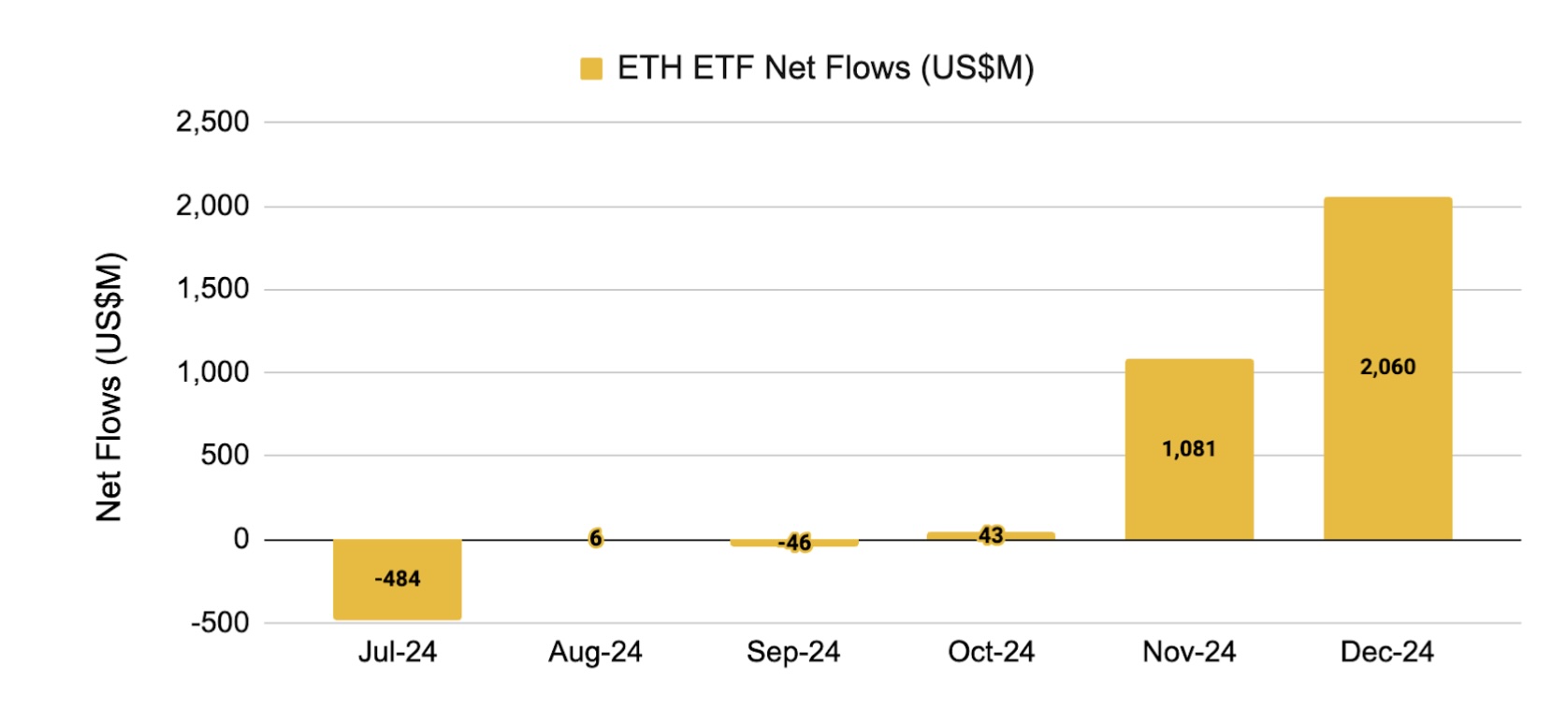
Overall, US spot ETH ETFs received a cumulative US$2.7B in net inflows since their July 2024 launch, an overall success among the broad ETF universe. Total volumes surpassed US$43B, with total AUM upwards of US$11B. November and December were particularly strong months, bringing in over US$1.1B and US$2.1B in net inflows, respectively. While numbers improved significantly by the end of the year, we should note that spot BTC ETFs attracted ~13-14x higher net inflows than the ETH ETFs.
Similar to the BTC ETFs, ETH ETFs stand to benefit from growing institutional interest as traditional finance becomes more comfortable with onboarding new asset classes, bolstered by the recent pro-crypto sentiment due to Trump’s recent victory.
Additionally, there is also an additional catalyst in the form of staking. A key difference between Bitcoin and Ethereum is their respective consensus mechanisms, i.e., Bitcoin uses proof-of-work (PoW), whereas Ethereum uses proof-of-stake (PoS). This means that ETH holders who choose to stake their ETH are able to benefit from a native staking yield (something not available to BTC holders). However, as things stand, those who hold ETH ETFs in the U.S. are unable to stake and earn yield on their holdings. But, given that many in the market expect a more constructive and accommodative crypto environment in the U.S. with the new government, taking yield on ETFs is something that many are expecting to be approved in the coming year. If this occurs, the ETH ETFs will have a unique feature in comparison to their BTC counterparts, and we might expect to see an increase in inflows towards them.
What’s Next?
Pectra Upgrade: Scheduled for early 2025, Pectra consolidates two previously planned upgrades: Prague (focused on the execution layer) and Electra (focused on the consensus layer). Together, Pectra introduces a set of updates designed to achieve three key objectives:
Address critical shortcomings in Ethereum’s PoS protocol. Enhance user experiences for interacting with smart contract dApps. Further advance L2 scalability by increasing Ethereum’s data availability capacity.
While the first two objectives aim to improve Ethereum’s overall functionality, the third reinforces its commitment to the rollup-centric roadmap. Two notable proposals included in Pectra specifically target scaling resources for L2s:
EIP-7742: This proposal allows the Beacon Chain to dynamically adjust the network’s target and maximum blob gas limit without requiring major hard forks.
EIP-7691: This increases the maximum blob count (currently capped at 6 blobs per block with a target of 3), further scaling Ethereum’s DA layer. With a higher blob count, the base blob fee would increase in a more controlled manner during periods of peak demand, enabling smoother price adjustments.
While Pectra’s scope is streamlined (inc. continuation of prior blobspace upgrades), it is not expected to have an outsized impact on ETH value in the short-term. However, beyond Pectra, several forthcoming initiatives may have more direct implications. These include efforts to reduce issuance through stake ratio targeting, improve censorship resistance, and advancing scaling capabilities via Peer Data Availability Sampling (PeerDAS).
More app-chains? Some dApps have turned to application-specific chains (app-chains) to meet higher performance requirements or vertically integrate their ecosystems, allowing them to capture a larger share of user and order flow. By leaving — or not opting for — Ethereum’s L1, these dApps forgo fee value accrual to the Ethereum ecosystem.
Notable examples include dYdX and Hyperliquid, but the most significant upcoming move is Uniswap’s shift to Unichain. As one of Ethereum’s largest gas consumers, Uniswap has historically made a substantial contribution to its fee pool. To put it in perspective, across November / December, Uniswap consumed approximately nine times more gas than blob transactions.
Figure 20: Uniswap consumed approximately nine times more gas than blob transactions over a 30-day period in November / December
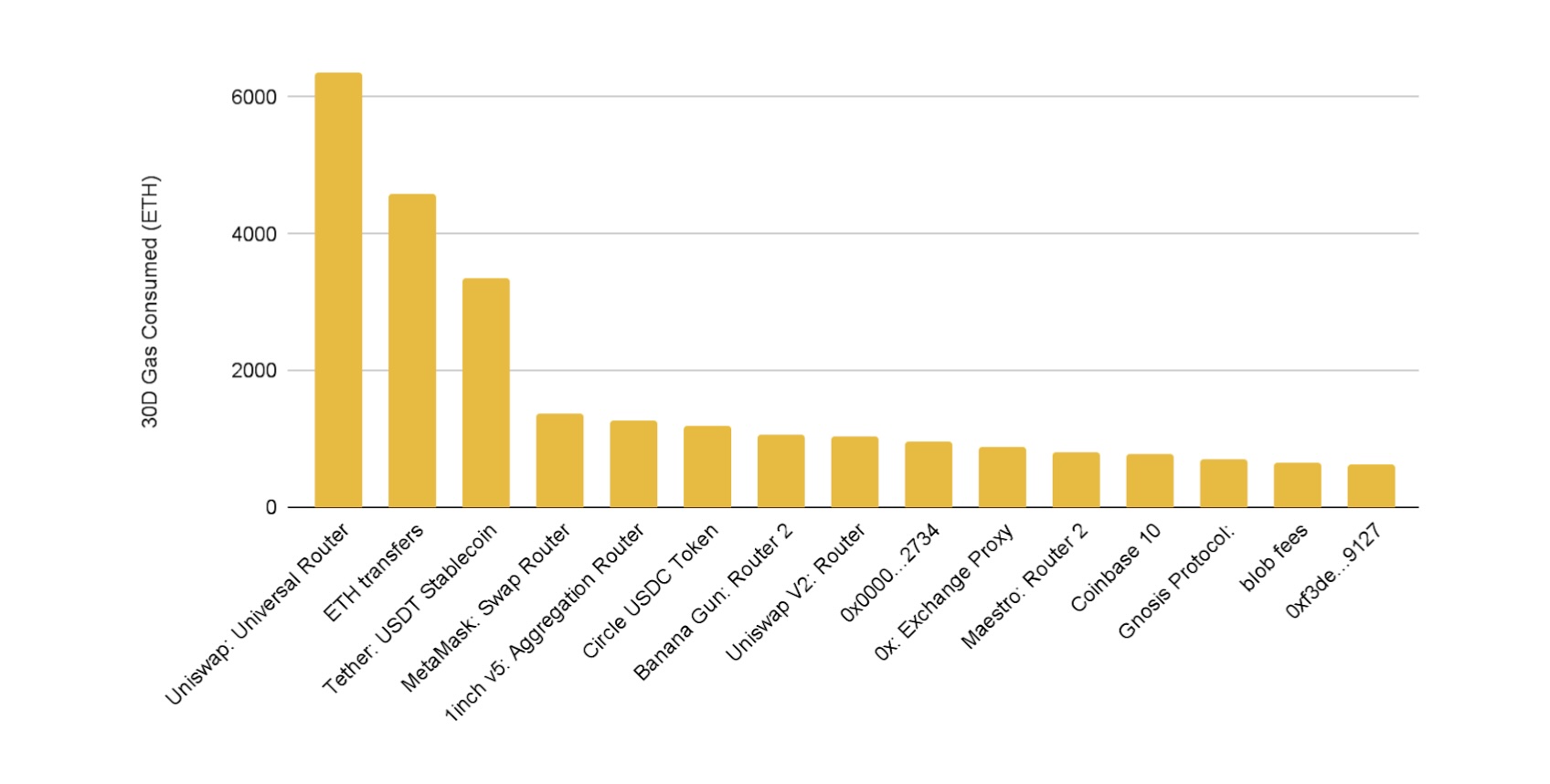
A fair question to ask is whether more leading applications will choose to leave the Ethereum L1, or perhaps forgo it altogether, in order to capture more value via their own app-chain. Something to keep an eye on.
The Prioritization Dilemma: Ethereum’s broad ambitions pose another challenge, as it simultaneously pursues multiple market spaces. This challenge arises from the prioritization dilemma: should Ethereum focus on L2s to enhance blobspace and compete with alt-DA layers, or prioritize L1 improvements to strengthen the execution layer and contend with alt-L1s? This strategic ambiguity has a direct bearing on ETH’s value accrual.
This divergence of focus between multiple key areas introduces uncertainty, which can weigh on market confidence. While pursuing many areas concurrently is theoretically possible, following multiple paths risks diluting focus and slowing progress, particularly when competing protocols excel in specialized niches.
Without clear directional alignment, there are risks of overextending efforts and spreading value too thin, reducing the likelihood of achieving any single vision effectively.
Figure 21: Does Ethereum have a single, unified vision?
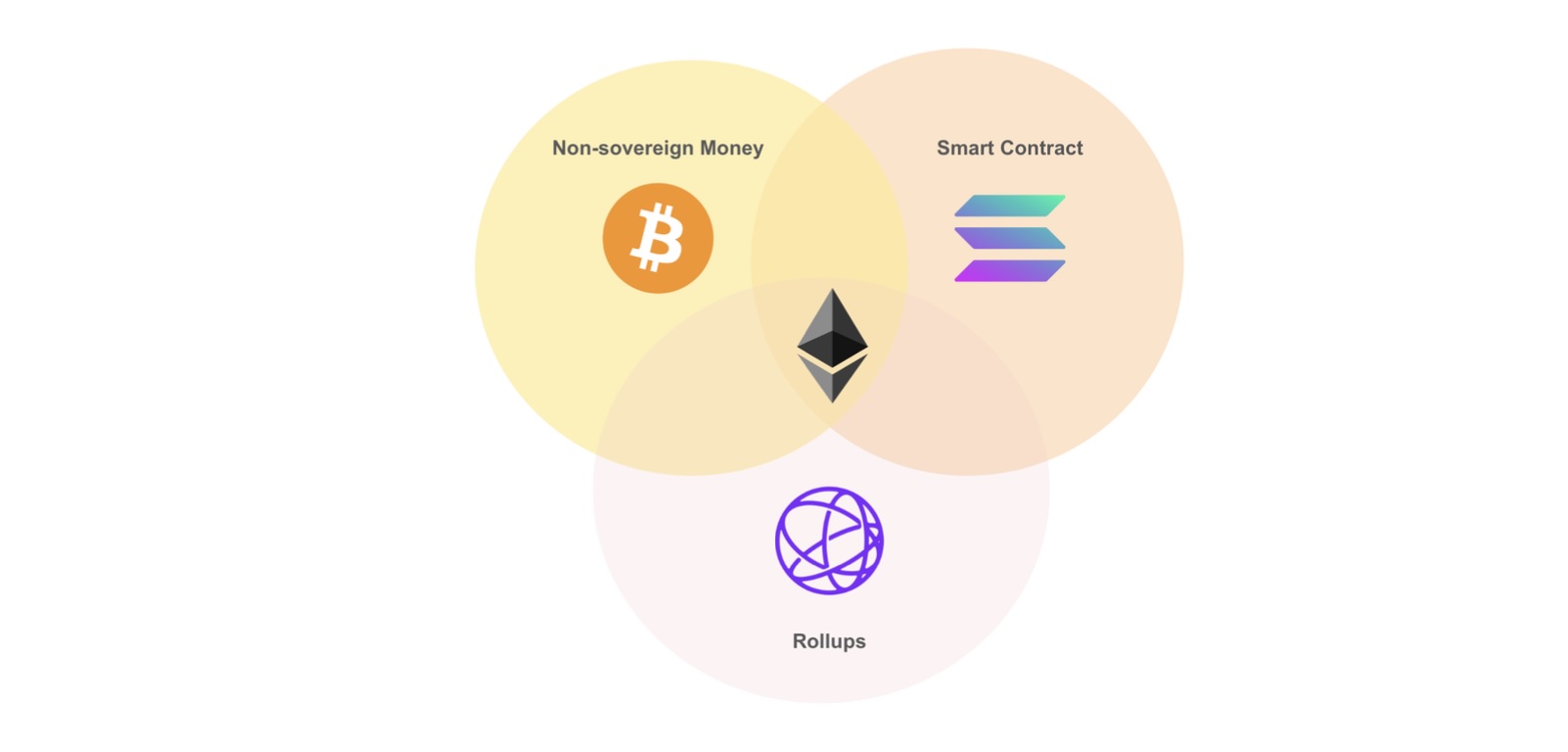
Solana
Solana had a very strong year, performing extremely well from both a fundamental and narrative point-of-view. On the fundamental side, network growth reached new all-time highs and surpassed Ethereum in many key categories, from DEX volumes to fees. From a narrative perspective, Solana remained at the forefront of some of the largest drivers of 2024, the most notable of which was memecoins.
Figure 22: Solana’s new and active addresses demonstrated significant growth in 2024
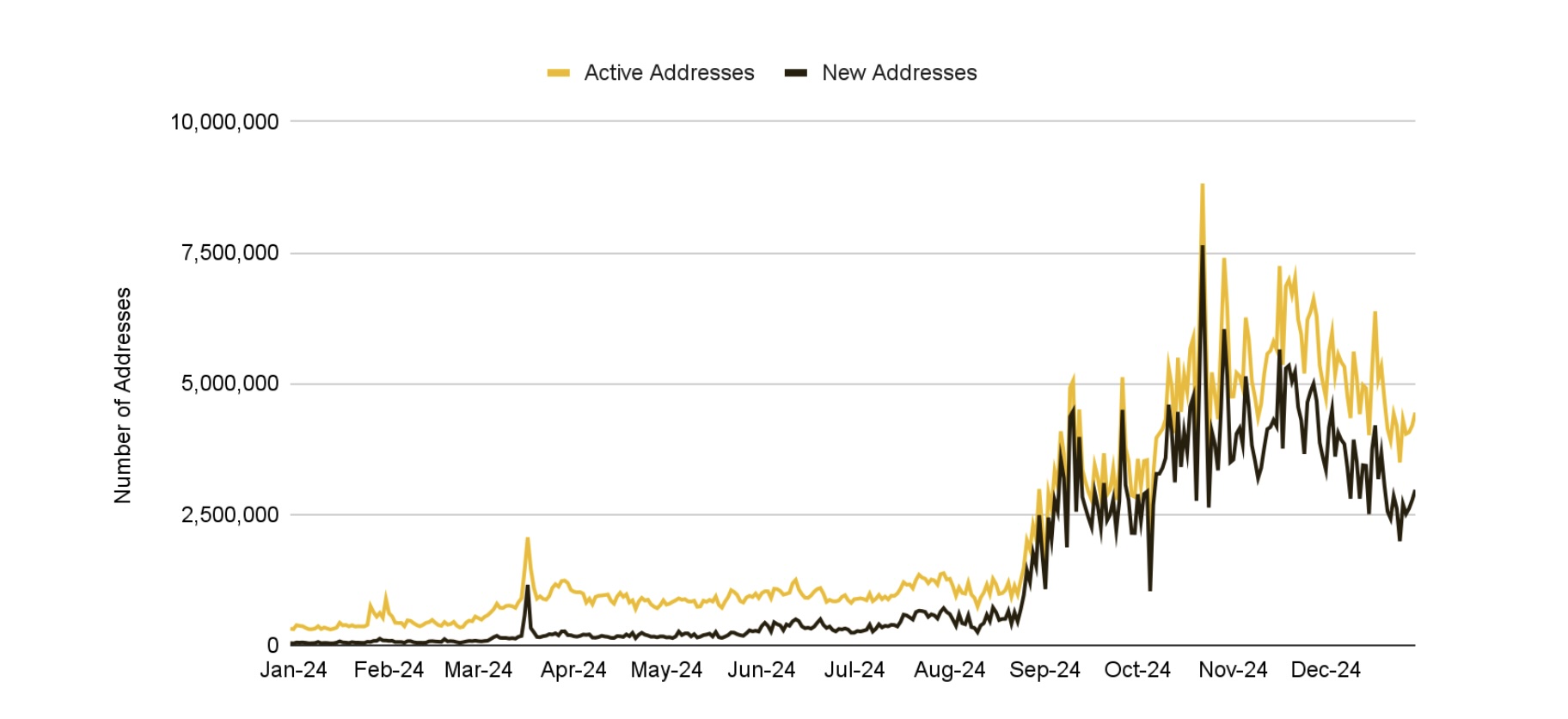
DEX Volumes and Revenues
Driven by memecoins, and a growing DeFi ecosystem, among other factors, Solana has performed with strength in terms of volume and fees.
DEX Volume: Solana’s DEX volumes broke their all-time high levels multiple times in 2024 and are now higher than those of Ethereum. In fact, Solana’s November 2024 DEX volumes were comparable to those of Ethereum and all L2s combined.
Figure 23: Solana’s DEX volumes have surpassed Ethereum and are significantly ahead of other major chains

As we can see in Figure 24, the weekly DEX traders figures for Solana have seen significant growth relative to the rest of the market. While not completely attributable to memecoin trading, this has undoubtedly been a key growth driver.
Figure 24: Weekly DEX traders have surged for Solana
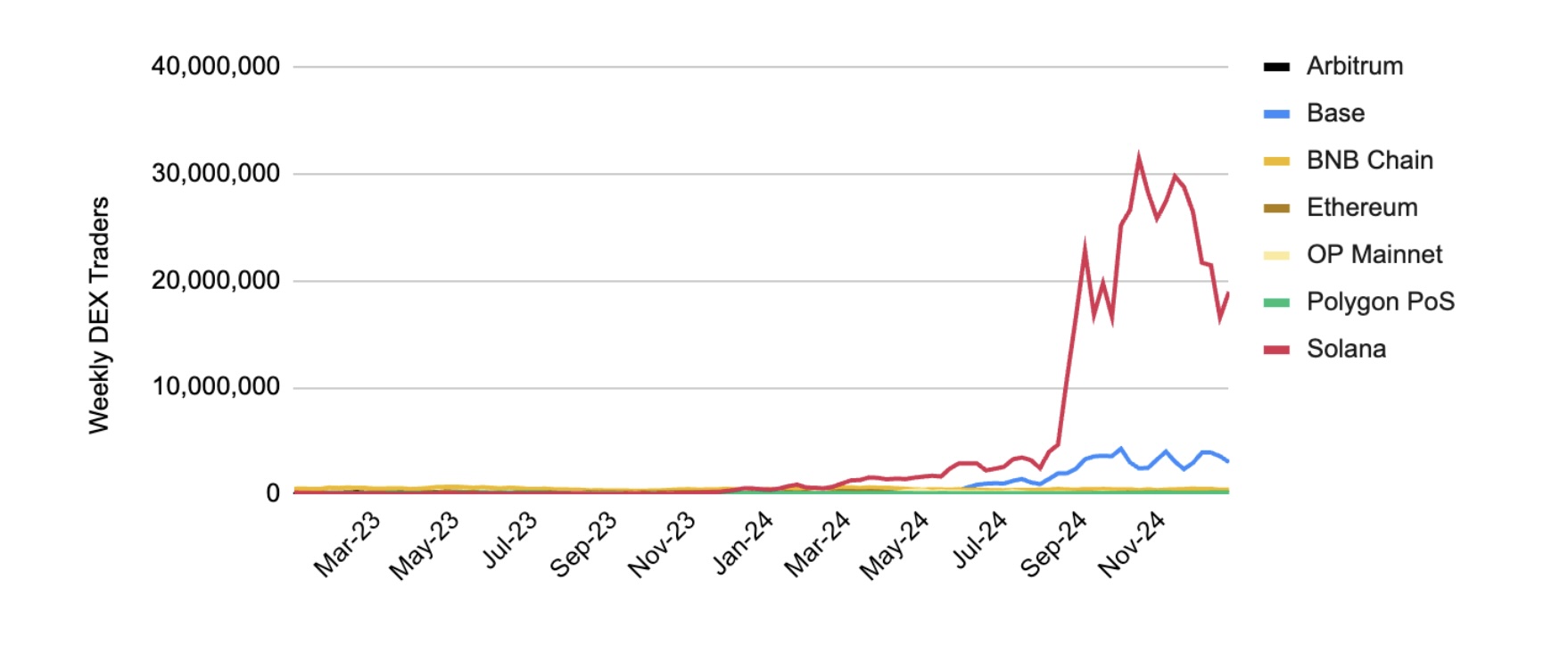
Profitability: Solana’s real economic value (REV), which represents the network’s total income from its various fee sources, consistently saw new highs through 2024. November was a particularly large month, seeing over US$410M in REV to set Solana’s new all-time high.
Figure 25: Solana’s monthly real economic value (transaction fees + MEV tips) grew significantly 2024
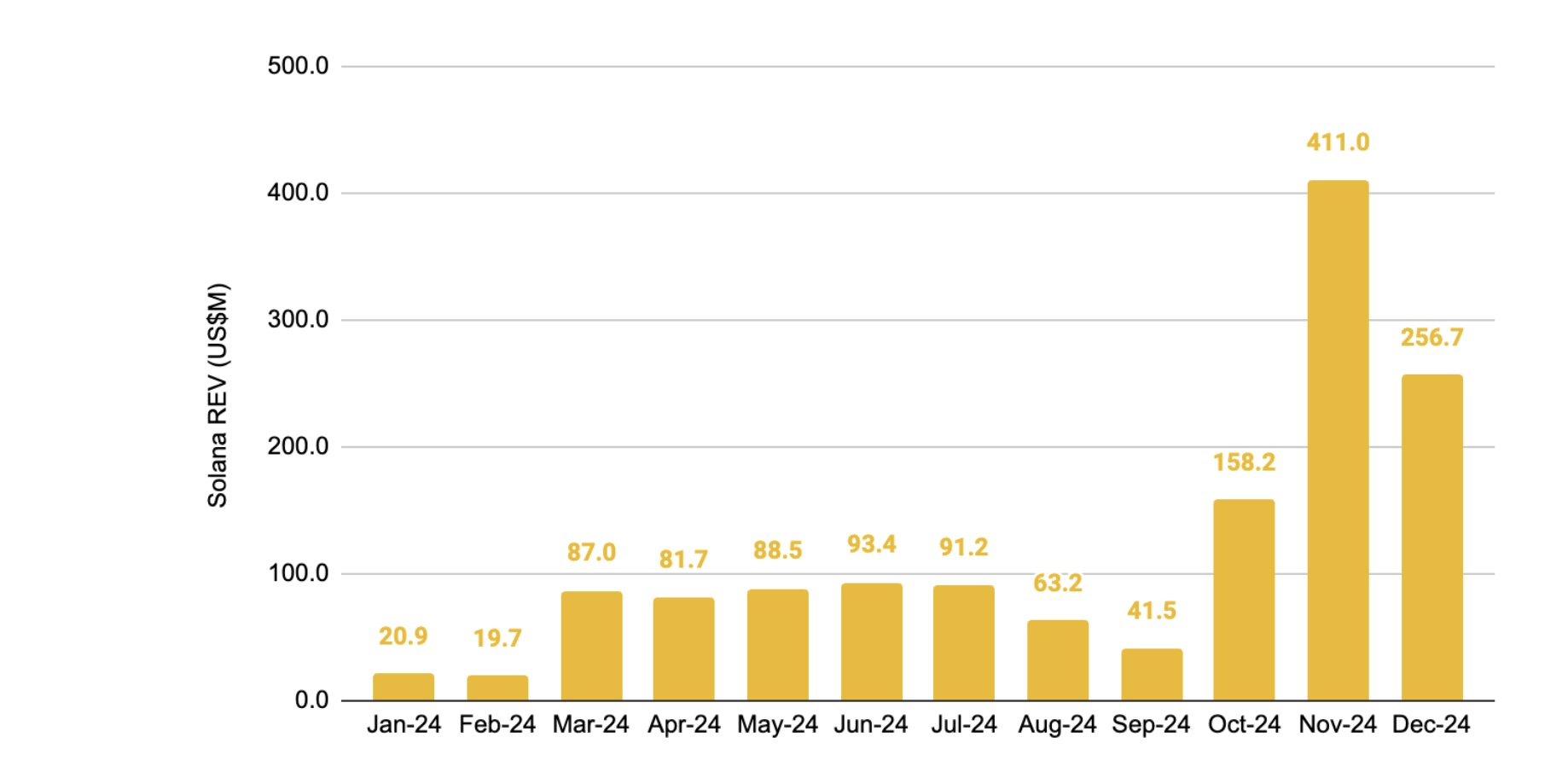
Memecoins
Memecoins have been one of the leading narratives of this cycle and saw an explosion across 2024. As we will see later in this report, memecoins were the top performing sub-sector in 2024, with a year-to-date return of over 200%.
Solana has been central to the growth of the memecoin markets, with many traders choosing it as their blockchain of choice when trading memes. There are multiple factors at play here, with the relatively cheap transaction fees and the cohesive and unfragmented product suite, being key highlights. Solana’s leading non-custodial wallet, Phantom, has also been important, with its simple user experience being a key factor. Having expanded from Solana to also supporting Ethereum, Polygon, Base, and Bitcoin, Phantom has further announced upcoming support for Sui and Monad this year.
Pump.fun: Solana’s native memecoin launchpad, Pump.fun, has been integral to the story, providing users a cheap and near-instant way to launch memecoins. Traders also benef it from each token being a fair launch without any pre-sale nor team allocation. Pump.fun’s success has meant that Solana has emerged as the leading chain for new token launches. In fact, over 5.7M new memecoins have been deployed via pump.fun, while the platform has generated over 2M SOL in revenue (~US$410M). This has made pump.fun among the most profitable apps across the entire crypto market.
Figure 26: Pump.fun has generated over US$410M in revenue since their launch
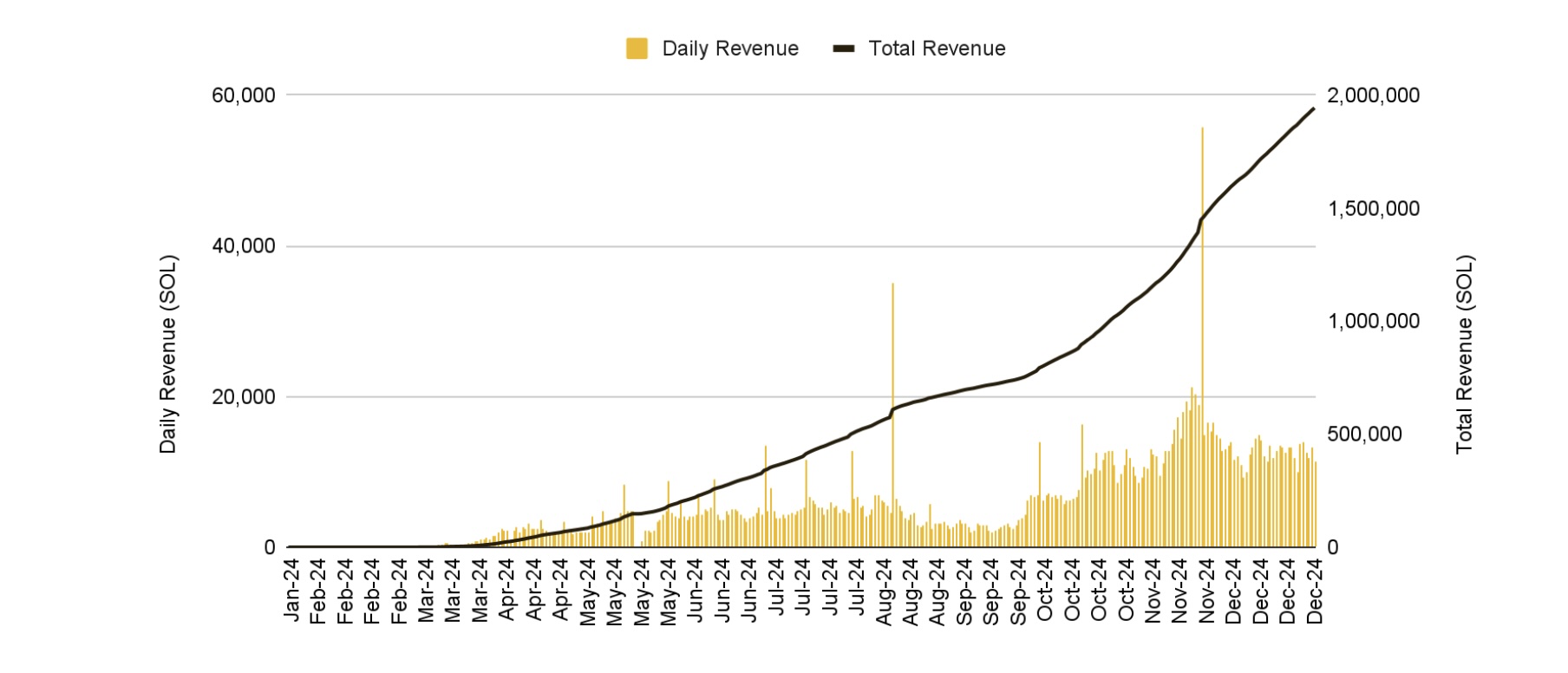
Meme sustainability?: Critics argue that Solana’s performance is not necessarily sustainable due to the prevalence of memecoin trading and the uncertainty around whether memes can last.
However, this might not be all too relevant. Ultimately, as we saw above in the DEX metrics, Solana has shown that it is a premier avenue for trading and users have chosen it as such. While it may be dominated by memecoins as things stand, other assets can take their place as the narrative evolves.
Memecoins, while currently prominent, represent just one category of tradable assets. Solana’s infrastructure and scalability suggest it is well-positioned to excel with other asset classes as market dynamics shift. In fact, the frenzy around memes has further meant that their trading has served as somewhat of a stress test for the network. Commendably, Solana has maintained near 100% uptime for nearly two years, with only one incident in 2024. This is very different to 2022, when such incidents were significantly more common.
Areas of Interest
DePIN: Decentralized Physical Infrastructure Networks (DePIN) remains one of the most interesting innovations in the crypto world and something to keep a close eye on. DePIN projects are typically infrastructure projects that use blockchain technology and crypto-economics to incentivize individuals to allocate capital or rent out their resources to create a transparent, decentralized, and verifiable infrastructure network .
Solana hosts various DePIN projects, including Hivemapper, a community-powered decentralized mapping service, and Helium, a crypto-powered 5G cellular network. Pipe, Dawn, and Teleport are others to keep an eye on.
Solana is also leading the AI agent narrative, as well as, hosting AI infrastructure projects such as Grass. Progress on this particular sub-sector will be important to track this year.
Network Extensions: Solana’s take on L2s are called “network extensions” i.e., networks that extend Solana’s capabilities for a focused set of operations.
While it may sound quite similar to traditional L2s, they are different insofar as app-specific networks, rather than general extensions of blockspace. This means that they do not necessarily contribute to liquidity fragmentation, which Ethereum L2s have been criticized for. Additionally, their existence is not due to Solana’s scaling limitations (like it is for Ethereum), but rather to add custom functionality that differs from the L1.
An early example is the perps DEX, Zeta Markets, which is building the Bullet rollup to better support low-latency trading. This is expected to have a mainnet launch in Q1. Solana also has Magicblock, which allows developers to create Solana Virtual Machine (SVM) ephemeral rollups with a focus on use cases like gaming.
SVM Stack: Solana Virtual Machine (SVM), a competitor to the widely used Ethereum Virtual Machine (EVM) is also growing in relevance and popularity. There are a number of chains building on the SVM, which might potentially increase the SVM’s network effects. This is important as one of the key drivers of Ethereum’s growth and relevance has been the widespread popularity of the EVM.
Examples include Eclipse , which recently launched its mainnet offering. Eclipse uses a combination of the SVM, Ethereum, and Celestia.
Others like Soon, Atlas and Sonic are also building on the SVM stack and are expected to see progress this year.
What’s Coming Up?
Firedancer: Solana’s hotly anticipated, new, independent validator client is set to be released this year. Solana currently has two clients, both of which are forks of the original Solana Labs client. Agave, maintained by the Anza team, and another by Jito Labs. However, as both are forked from the original Solana Labs client, if a bug takes down one of these clients, it is likely that it is present in both. Firedancer, on the other hand, is completely independent, and even written in a different language (C++ vs Rust for the original client).
The key benefit of Firedancer is increased network reliability and resiliency, i.e. if a bug takes down the other clients, the network can remain running on Firedancer. Additionally, Firedancer aims to significantly bolster Solana’s scalability, with Firedancer having processed 1M+ TPS in tests — significantly higher than Solana’s current average of ~3-5K. Firedancer will also help reduce latency times, which should help give Solana dApps a performance boost.
At Solana’s Breakpoint conference in September 2024, an interim non-voting version of the full Firedancer client called Frankendancer went live on mainnet, while the Firedancer client went live on testnet. The full version is expected sometime later this year.
Limited stablecoins?: Although stablecoin volume and availability on Solana has been growing, it still lacks the likes of Ethereum and is an area that should be paid attention to. Stablecoins are the lifeblood of L1s, especially DeFi, and it is easy to argue that the significant stablecoin concentration on Ethereum is at least a partial contributor to its continued dominance in DeFi.
Figure 27: Solana stablecoin market cap is significantly lower than that of Ethereum

2024 saw the launch of Paypal’s PYUSD on Solana, which initially saw strong growth, driven by incentives and partnership. However, after peaking at over US$1B circulating, supply (i.e., market cap, as supply = market cap for stablecoins if they maintain their US$1 peg) has slowly dwindled down towards US$500M. It remains to be seen if PYUSD will regain growth in the coming year.
More recently, we also saw the launch of USDS (Sky Dollar, the new stablecoin from the MakerDAO team) on Solana. Although supply is still limited at around US$110M, it is a step in the right direction.
Growing Developer Interest: A critical factor to note in the growth trajectory of any crypto project is the level of developer interest it gets. In this metric, Solana excels.
Solana’s full-time developers rank second only to Ethereum. While Ethereum saw a drop off in developer interest in 2024, Solana saw a double-digit increase.
An important fact to note is that Ethereum has a ~6 year headstart on Solana given that it launched in 2014, versus 2020 for Solana. As we have seen above, Solana’s volumes are already exceeding those of Ethereum, while other metrics like fees are also starting to compete. Given developer interest is typically a leading metric for growth, as things stand, the future for Solana looks bright.
Figure 28: Solana saw a largest jump in developer interest in 2024 among the major chains and ranks second only to Ethereum
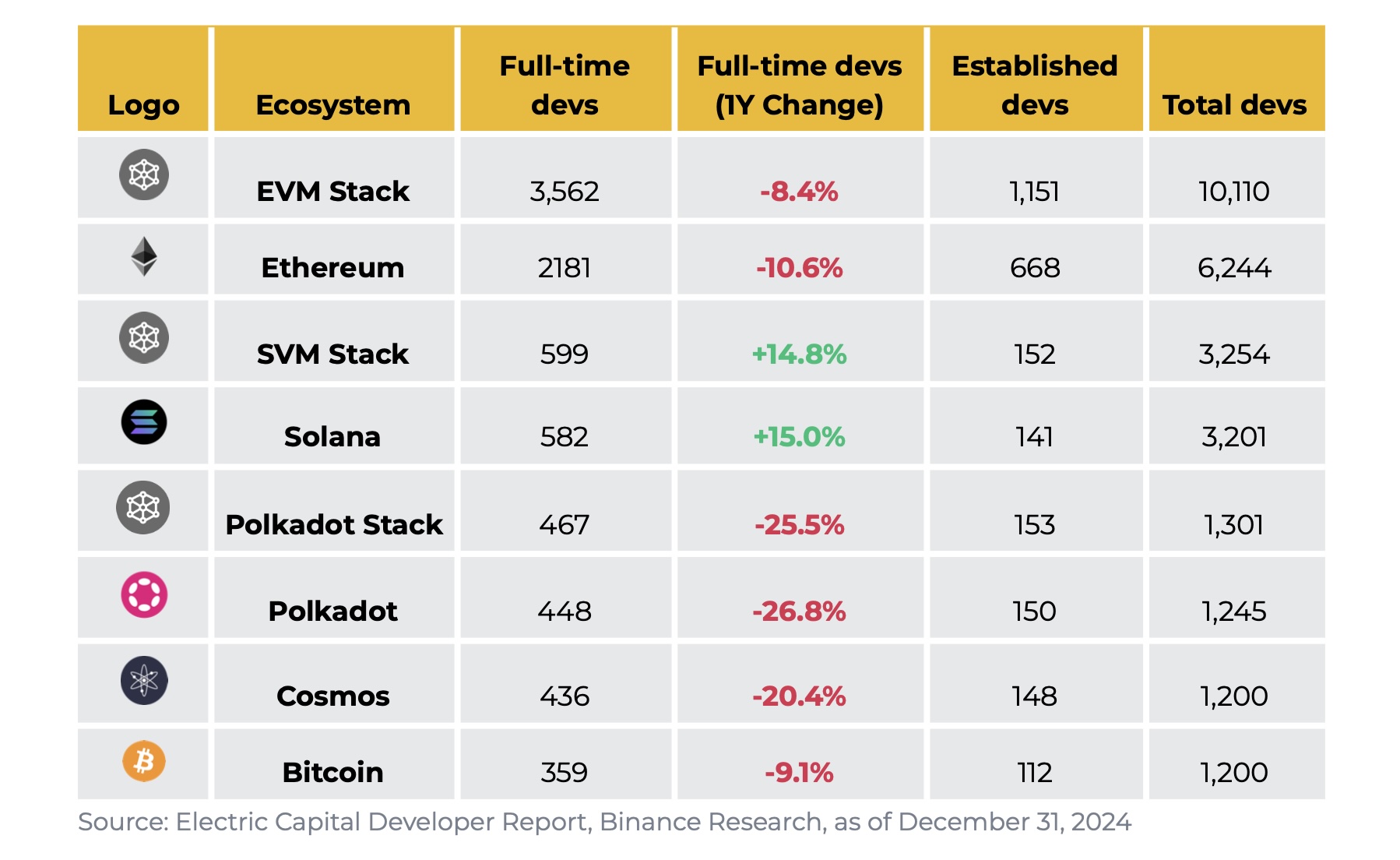
BNB Chain
BNB Chain ended 2024 in a position of strength as a leading L1 progressing in a number of different directions. Notable achievements include the network consolidation under the ‘One BNB’ multichain strategy, scalability progress led by opBNB and data storage growth under BNB Greenfield. BNB Chain was also positioned as an AI-first chain with the implementation of noteworthy initiatives like the Gas-Free Carnival and stablecoin incentives.
Ecosystem Growth
BNB Chain saw a significant 58.2% increase in total value locked, from US$3.5B in January to US$5.5B by the end of 2024. Also, it saw a 17.7% rise in unique addresses, growing to over 486M.
The average transaction fee on BNB Chain during 2024 remained at US$0.03 per transaction. BSC’s fees continued to be competitive compared to blockchains like Ethereum, Arbitrum, and Avalanche. Transaction activity was also robust, with an average of ~4M daily transactions during 2024, highlighting capacity for high throughput.
2024 also saw BNB Chain embark on a number of initiatives to drive both developer and user growth. Specifically:
To promote affordable stablecoin transfers, BNB Chain launched the Gas-Free Carnival in September 2024. This initiative eliminated gas fees for transferring or withdrawing stablecoins like USDT, FDUSD, and USDC on BNB Chain and opBNB. BNB Chain also launched the TVL Incentive Program to encourage DeFi projects to grow their TVL, accelerating stablecoin adoption.
BNB Chain also committed US$1M through the Meme Innovation Battle to accelerate memecoin innovation within the ecosystem.
BNB Chain also held numerous hackathons, distributing over US$2 million in prizes to over 20 projects.
BNB Chain also executed Seasons 7 and 8 of its Most Valuable Builder (MVB) Program, and launched the BNB Chain Incubation Alliance (BIA) to improve Web3 project development. The MVB program saw 48 projects selected out of over 1,200 applicants, while 12 winners were awarded across five BIA events. Winners received direct admission to the MVB Program and extended support, including access to BNB Chain’s launch-as-a-service (LaaS) and the Kickstart programs.
opBNB
opBNB is a BNB Chain optimistic rollup L2 solution based on the OP Stack. opBNB is EVM-compatible, capable of up to 4.6K transactions per second (TPS), and has an average gas fee (37) of ~0.001 gwei (which is
In 2024, opBNB achieved an average DAU of 4.7M, with an average of 7.1M transactions being processed per day. Leading dApps include derivatives platform, KiloEx as well as DeFi platforms, PancakeSwap and Goose Finance.
As we look ahead, opBNB is targeting 10,000 TPS and a 10x cost reduction, with notable updates such as support for new wallets, a customized gas token, and bug fixes in the Optimism SDK.
BNB Greenfield
BNB Greenfield provides decentralized data storage infrastructure within the broader BNB Chain ecosystem. It is a storage-oriented blockchain where users can create, store, and exchange data that they fully own. With the use of a native cross-chain bridge, all of the data stored in BNB Greenfield can easily be transferred to BNB Smart Chain, where it can be used by BNB Chain dApps and any new BNB Greenfield dApps. Use cases include website hosting, cloud storage, blockchain data storage, publishing, personal data markets, etc. More details can be found on the official website here .
Since launching their mainnet in Q4 2023, BNB Greenfield has seen ~18.6 TB of storage, 17.6M transactions across ~106K total addresses. Notable players include AI studio, Limewire, infrastructure players CodexField, Aggregata, and Rido, alongside Binance Web3 Wallet.
Figure 30: BNB Greenfield’s network usage has been rising
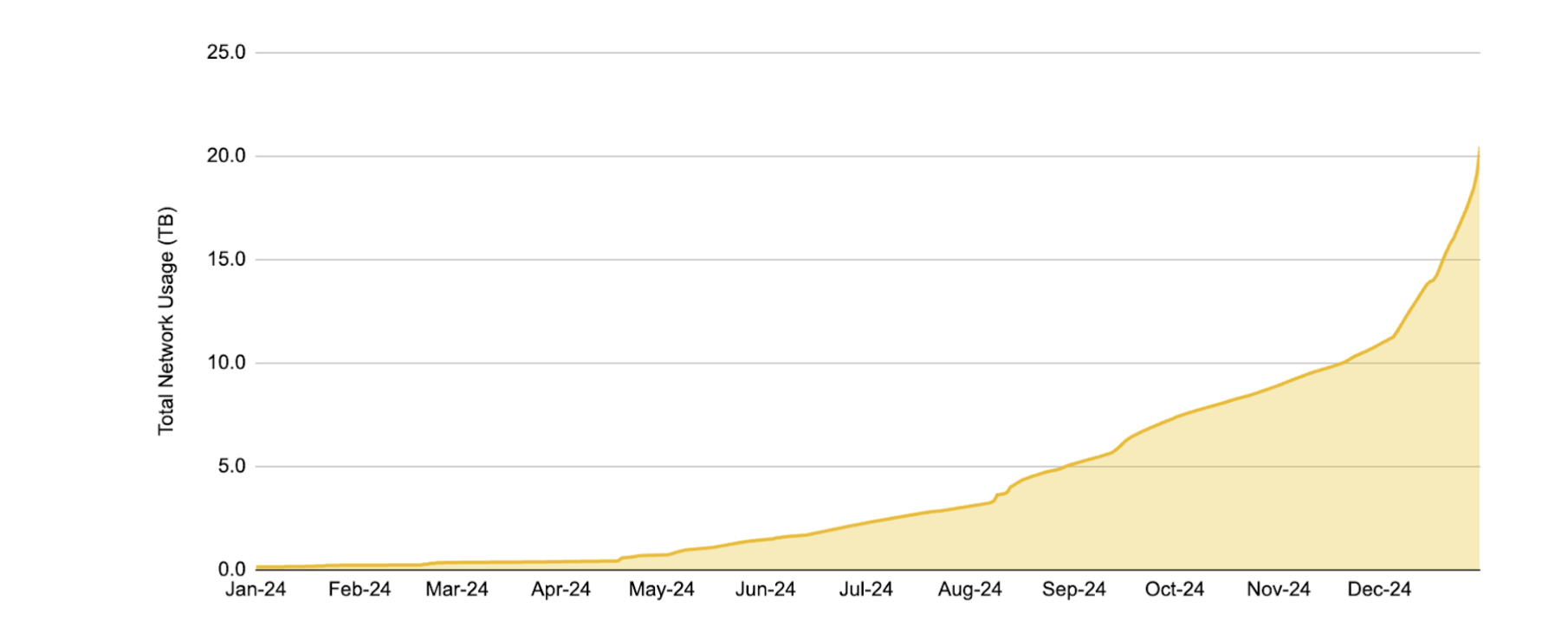
2024 was the completion of three forks in order to enhance functionality and user experience. The alpha version of Greendrive was also launched, supporting over 30 public datasets and featuring an updated user interface. Greendrive offers a secure, permission-based environment for storing and sharing AI data and models. The BNB Archive Layer was also introduced, built on BNB Greenfield, to provide permanent storage for historical block and blob data, ensuring long-term availability and decentralization.
For further detail on BNB Chain’s progress in 2024, please check out their 2024 Annual Report. As we look ahead, BNB Chain will focus on its positioning as an AI-first chain, driven by its high throughput and low transaction costs, opBNB’s rapid processing for real-time responsiveness, and BNB Greenfield’s secure, decentralized data storage. BNB Chain will also continue to empower startups via its various flagships programs.
Others
Avalanche
Avalanche remains among the few alt-L1s that has managed to maintain a degree of relevance in a market largely dominated by the big players. Their flagship L1, the C-Chain, sits in the top 10 DeFi and stablecoins chains, with a DeFi TVL of ~US$1.3B, and over US$2.2B in stablecoins.
They recently rebranded “Subnets” as “Avalanche Layer-1s”, of which there are 34 live on mainnet. The most notable among these are DeFi Kingdoms (Gaming) and Dexalot (DEX). In March, Avalanche released Teleporter, which is a communication protocol designed to improve interconnectivity between the Avalanche L1s. Teleporter facilitates tokens, NFT, and message transfers across subnets, and continues to see daily activity.
Most recently, Avalanche saw its largest ever update with Avalanche9000. The update reduced the minimum gas fee on the C-chain by up to 96%, lowered the cost of deploying Avalanche L1s by ~99%, and improved L1 interchain messaging. This was accompanied by a US$250M locked-token sale. It will be interesting to see if this leads to more L1s being deployed and greater growth on the C-chain.
Move-based Chains: Aptos, Sui
Born from the ashes of Meta’s Libra project and launched in late 2022, Aptos and Sui have been steadily growing over the last couple of years. Both utilize the Move programming language and class themselves as high-throughput L1s. Aptos has focused on bringing institutional interest to crypto and RWAs, with recent partnerships including Franklin Templeton, and Microsoft. On the other hand, Sui has been more involved in the gaming and consumer space, recently announcing their own handheld gaming device, the SuiPlay0X1.
While still relatively early in their lifecycles as L1s, it appears that the market has been more responsive towards Sui, which has a fully-diluted value (FDV) ~4x higher than that of Aptos. It will be interesting to see how things evolve in the coming year.
TON
TON saw a surge in popularity and narrative mindshare in 2024, particularly around the middle of the year. Key to this growth has been their close links to the Telegram messaging app, which has over 950M monthly active users which is a key part of crypto circles. TON’s viral tap-to-earn minigames, including Notcoin and Hamster Kombat commanded significant mindshare in the summer of 2024 and gained millions of users and token holders (following highly publicised airdrops). While there have been some criticisms of the simplicity of the games, the mass appeal and virality has been undeniable. As we look ahead to 2025, it will be important to see if TON can leverage the vast reach of Telegram in order to onboard new users and build larger crypto communities across its various different markets. How apps evolve from tap-to-earn to more sustainable plays will also be interesting to monitor.
Tron
Tron remains a leading stablecoin settlement chain and host to nearly ~US$60B (41%) of USDT. However, for the first time since June 2022, Ethereum has overtaken Tron as the leading network for USDT, with ~US$67B (46%) of USDT supply. It will be important to monitor how and if Tron responds to this change.
In terms of DeFi TVL, Tron sits as the third-largest chain. However, this is only composed of ~34 protocols, compared to over 1.2K for Ethereum and over 180 for Solana. JustLend is responsible for ~US$6B out of US$7.3B of total Tron DeFi TVL.
Upcoming
Monad
One of the more widely anticipated upcoming chains, Monad is building a “high-performance Ethereum-compatible L1” that can offer up to 10,000 transactions per second (tps) with 1 second block times and 1 second block finality. As a reference, Ethereum block times average around 12 seconds, while finality is typically achieved in 12-18 minutes.
Monad implements four key aspects to achieve this performance:
MonadBFT: A high-performance consensus mechanism derived from the widely used HotStuff.
Deferred Execution: One of Monad’s novel features is that execution is decoupled from consensus. To recap, consensus is the process where nodes agree upon the official ordering of transactions, while execution is when transactions are actually processed and the state of the blockchain is updated.
Deferred execution is a key driver of high levels of transaction throughput for Monad.
Parallel Execution: Transactions are executed in parallel on Monad, rather than sequentially, again contributing to higher throughput.
MonadDb: This is Monad’s custom database for storing the state of the chain. This is purpose-built to support Monad’s parallel execution and is a key feature of the chain.
Monad has conducted “Monad Madness” hackathons in order to help ecosystem growth and now has teams building (46) in various different sectors.
Monad has raised ~US$263M across four funding rounds and recently announced the Monad Foundation . Monad launched their devnet in March, their testnet in November, and is expected to launch mainnet in 2025 .
Berachain
Another very-well funded EVM L1 expected to launch over the next few months, Berachain uses a novel proof-of-liquidity consensus mechanism that focuses on building systemic liquidity within the Berachain ecosystem of dApps and aligning all stakeholders via a three-token model. The idea is that native applications can create reward vaults and encourage validators to direct emissions into them. Users can stake their assets into the reward vaults to receive these emissions, while validators benefit from the staked assets. This is meant to create a flywheel of liquidity and rewards and allow for close partnerships between all parties within the Berachain ecosystem.
Berachain has gone through various stages of testnets across 2024, and is expected to launch mainnet in 2025. This comes after raising ~US$142M in funding.
Layer 2s
Ethereum Layer 2 (L2) solutions have played a crucial role in retaining users and activity within the Ethereum ecosystem, even as cheaper and faster Layer 1 (L1) blockchains have successfully established their own user bases and market share.
Figure 32: In terms of daily active addresses, L2s have allowed the Ethereum ecosystem (currently at 18% market share) to keep pace with other widely used L1 ecosystems
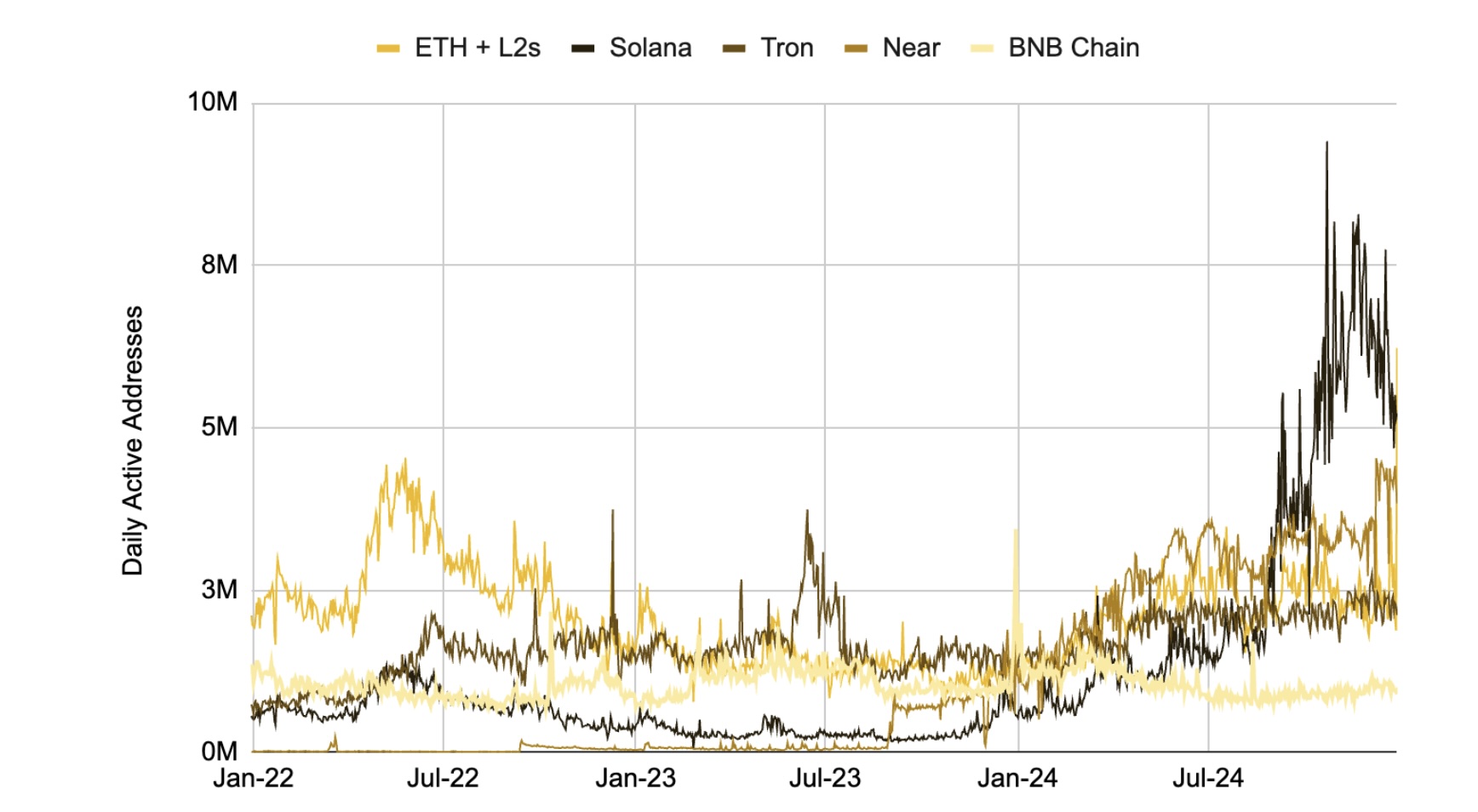
Much of the Ethereum ecosystem’s continued competitiveness with the new chains in terms of user count can be attributed to the L2s, which have played a pivotal role in attracting and retaining users within the Ethereum ecosystem. Of the total daily active addresses within the Ethereum ecosystem, the vast majority of them were found on the L2s throughout 2024.
Figure 33: L2s have been responsible for the majority of daily active addresses, averaging 80% across the year

Source: Artemis, Binance Research as of December 31, 2024
While other L1 ecosystems have reduced Ethereum’s dominance in terms of active users, the Ethereum ecosystem continues to lead significantly in terms of Total Value Locked (TVL), capturing approximately 64% of the total market share across both the Ethereum mainnet and its L2 solutions combined. This substantial dominance in TVL may be a soft indication of the market’s current perception of Ethereum as a more decentralized and secure ecosystem for long term capital storage.
Figure 34: Ethereum and its L2s collectively represent ~64% of the total TVL across all chains, with Ethereum accounting for ~US$66B and L2s contributing ~US$10B
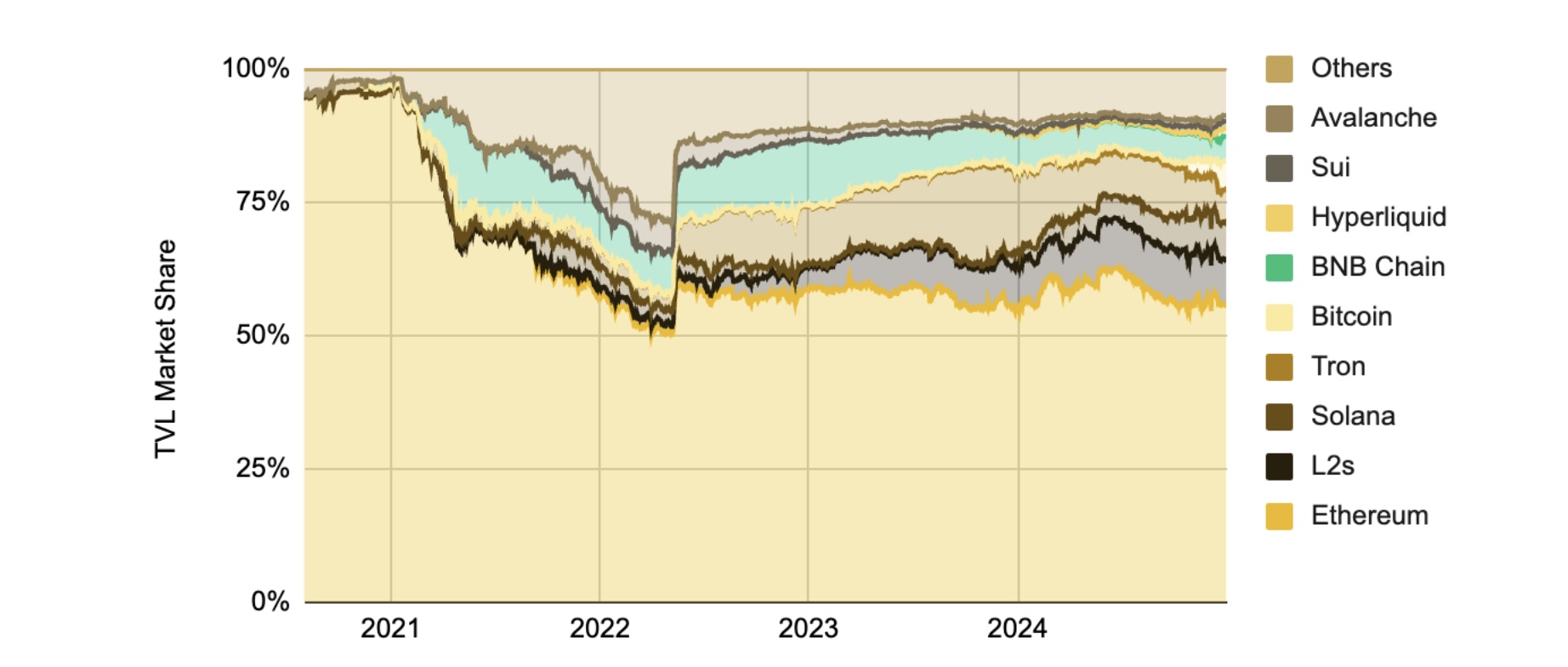
The Year of Airdrops
The L2 ecosystem is experiencing rapid expansion, with increasing competition among projects. According to L2beat, there are 50 rollups and 70 validiums and optimiums (49) currently in various stages of development as of December 2024. In addition to many new L2s, 2024 saw many existing L2 projects launch their tokens.
Figure 35: Many of the major L2 tokens airdropped in 2024 are sporting lower circulating market caps than at launch, with an average token float of ~23%
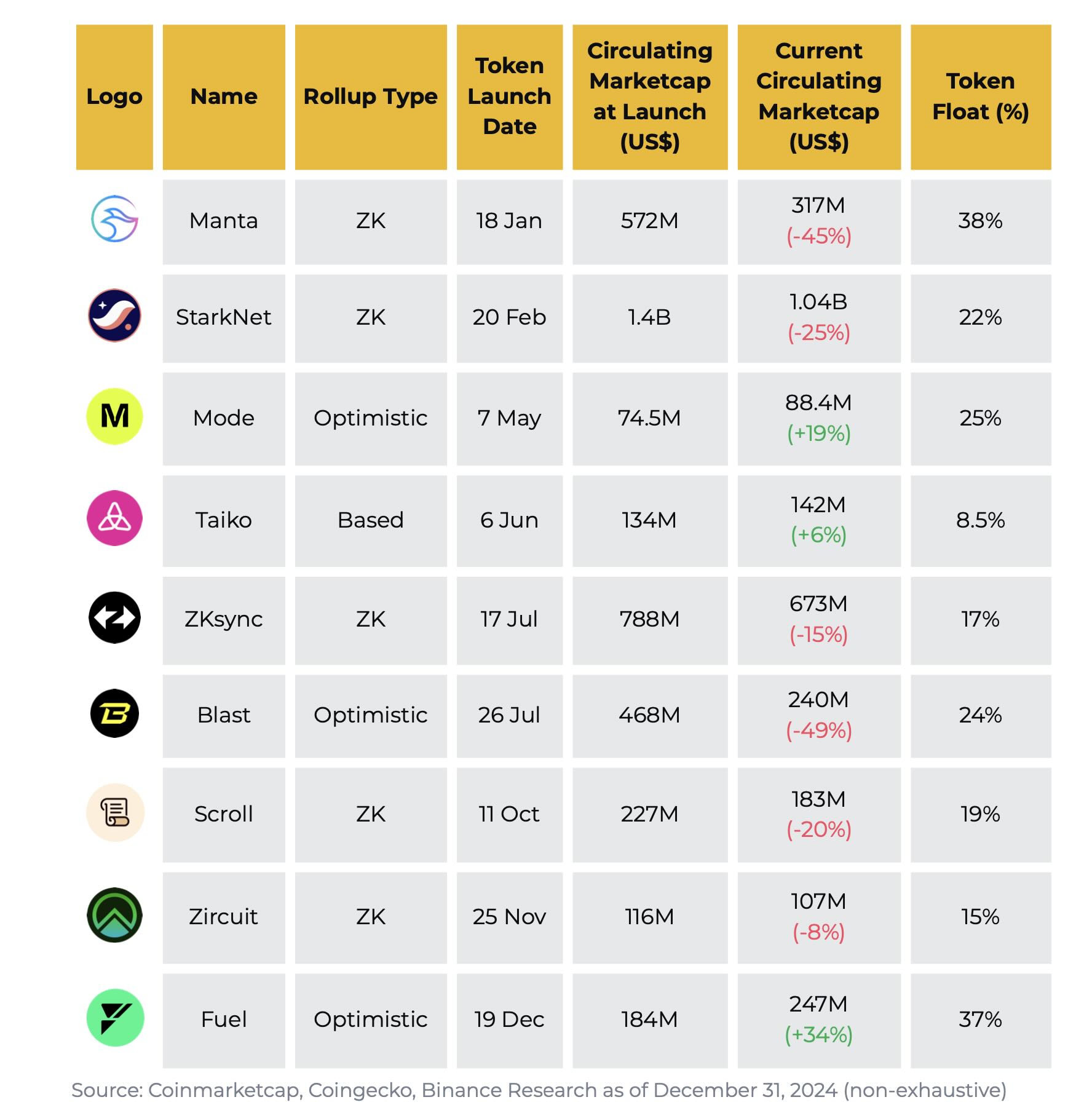
The market capitalizations of many L2 tokens launched this year have declined since their respective launch. This trend may be partly attributed to negative market sentiment regarding the relatively low token floats of many of these tokens.
An Optimistic Outlook
By and large, optimistic rollups continue to be the most widely utilized rollup type. ZK rollups started the year relatively strong in terms of daily active addresses, driven largely by the zkSync Era and Linea airdrop campaigns, which took place earlier in the year. As hype around the ZK L2 airdrop campaigns cooled, so did user activity on those chains, relative to their optimistic counterparts. We saw the optimistic market share in terms of daily active addresses gradually rise to over 96% where it sits today, driven in large part by the rapid growth of the Base L2.
Figure 36: Optimistic rollups have captured over 98% of the daily active address market share across the major rollups in 2024
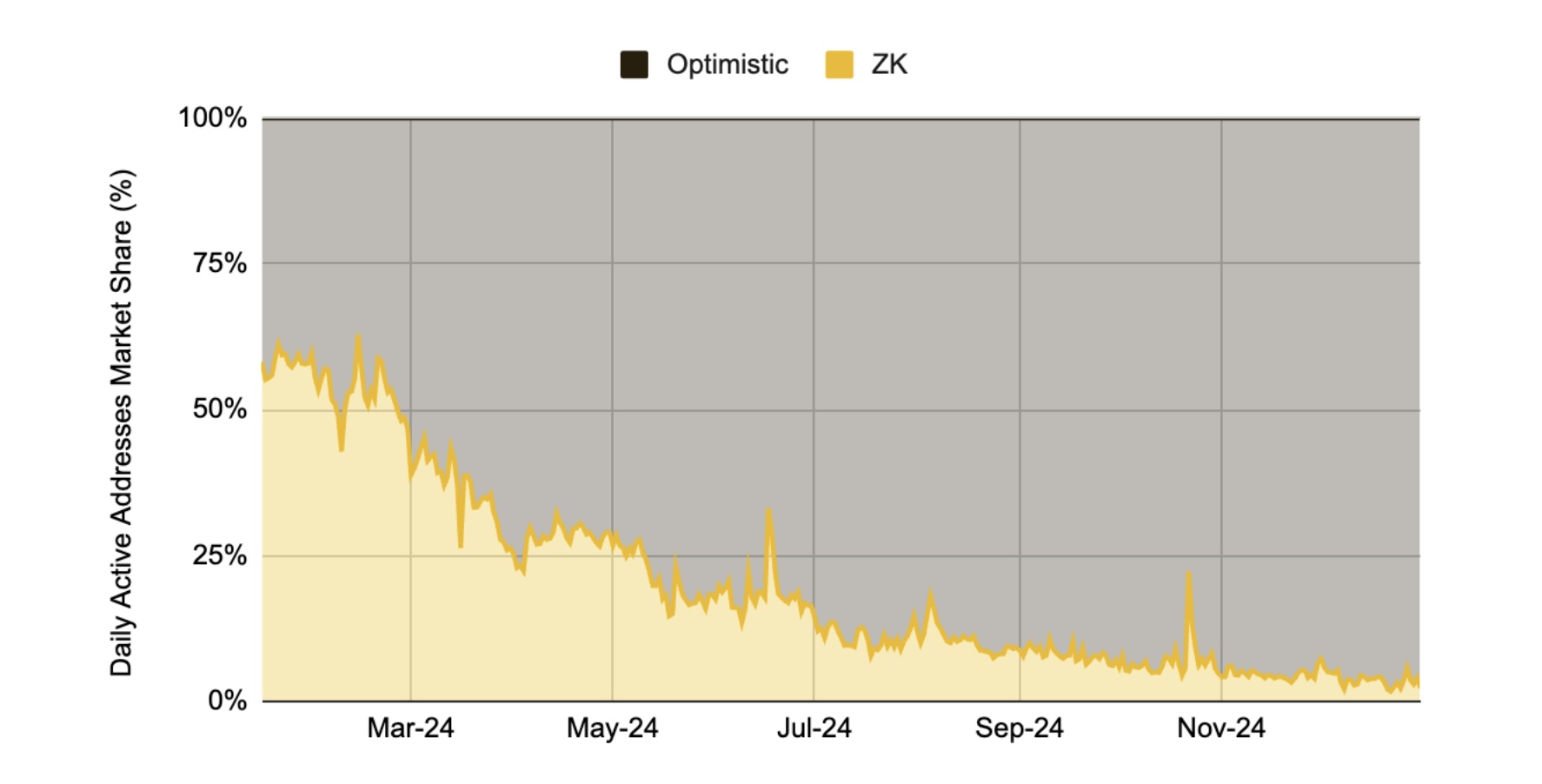
While ZK rollups have yet to meaningfully supplant retail users from their optimistic competitors, the December announcement from Deutsche Bank revealing its decision to build a L2 using the ZKsync technology stack has the potential to set a trend for other institutional players looking to adopt zk rollups.
As the L2 space continues to heat up, adoption from established companies from both the crypto and TradFi sectors decide to build on Ethereum L2s will be essential to assessing the future health and competitiveness of the Ethereum ecosystem, as well as provide further clarity on the issues surrounding the ongoing ETH Value Debate .
The Optimistic Rollups
Base
Over the course of 2024, Coinbase’s Base L2 has steadily risen to become the largest L2 on most metrics. It overtook Arbitrum, the previous largest L2, in terms of daily active addresses in July, and in terms of TVL in October 2024.
Figure 37: Base has steadily risen to capture 39% and 67% of the market in terms of TVL and daily active users respectively, making it the top L2 in both metrics
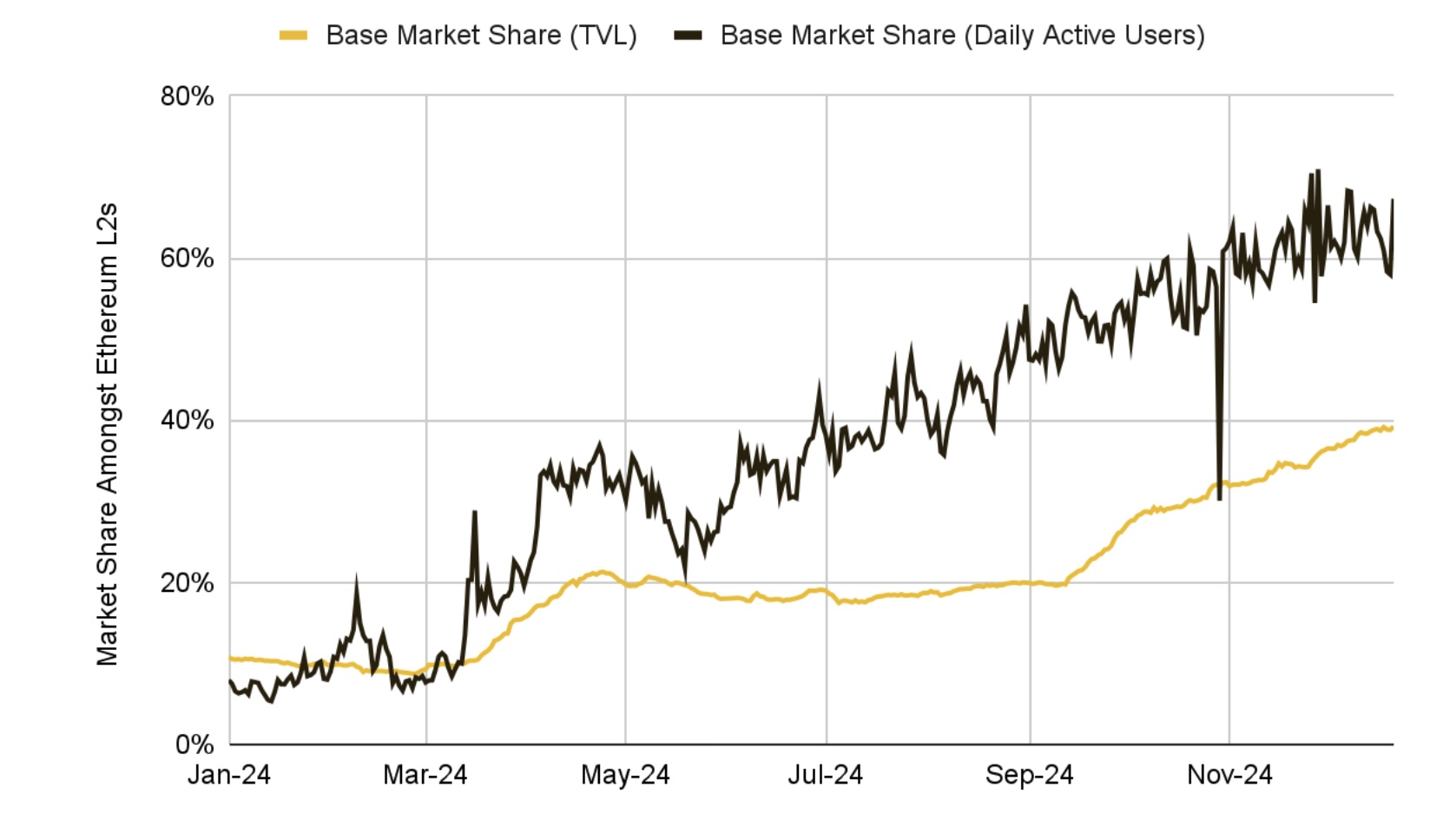
The success and rapid adoption of the Base L2 endeavour has proven to be highly profitable for Coinbase. Year to date (YTD), Base L2 has generated US$86M in fees for the company, putting it at almost double the amount earned by Arbitrum, which comes in second place.
Figure 38: In 2024 Base generated the most fees out of all L2s, at almost twice the amount earned by Arbitrum YTD
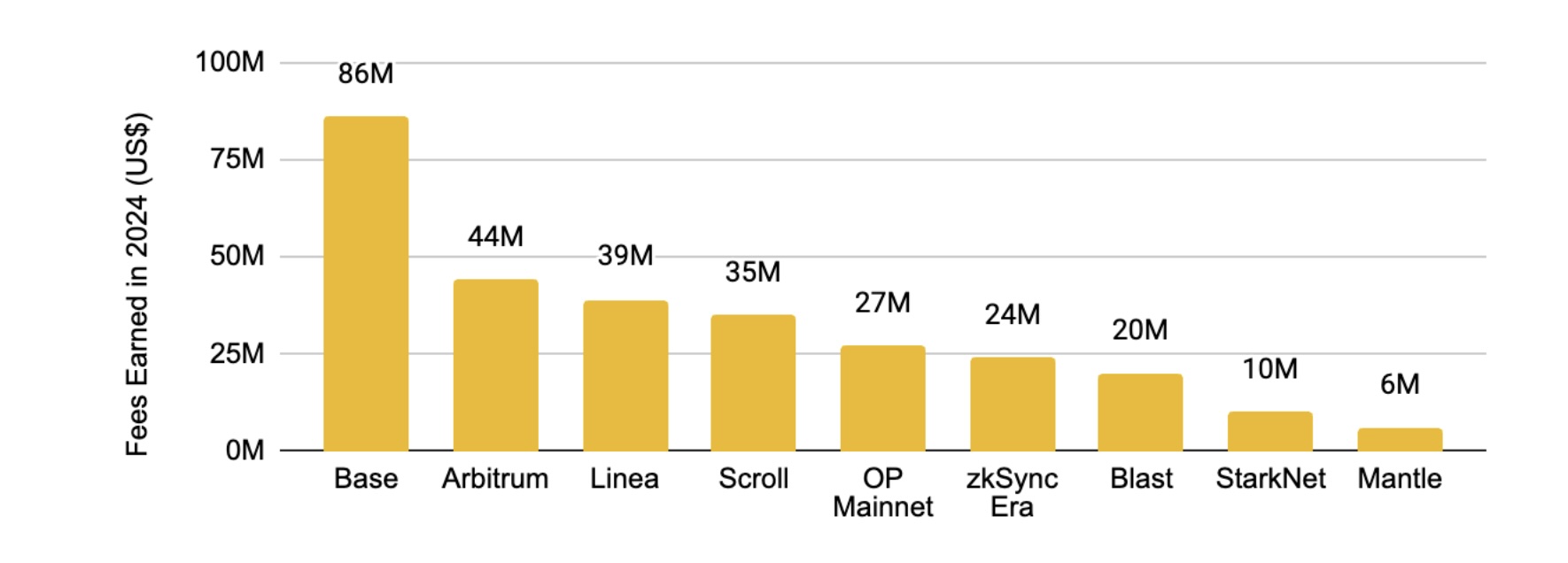
The profitability and success of the Base L2 is likely one of the driving factors behind the announcements and launches of the numerous new L2s in 2024 from well-established companies like Kraken, Uniswap and recently even Deutsche Bank.
Arbitrum
For most of its existence, Arbitrum has experienced limited competition for its spot as the number one L2. This year however, we’ve seen a significant shift in market dynamics, as new L2 players have risen up to challenge Arbitrum’s previously unfettered dominance. In 2024, Base supplanted Arbitrum as the L2 with the highest TVL and daily active addresses.
Figure 39: Arbitrum falls to second place amongst the L2s in terms of TVL for the first time since 2022
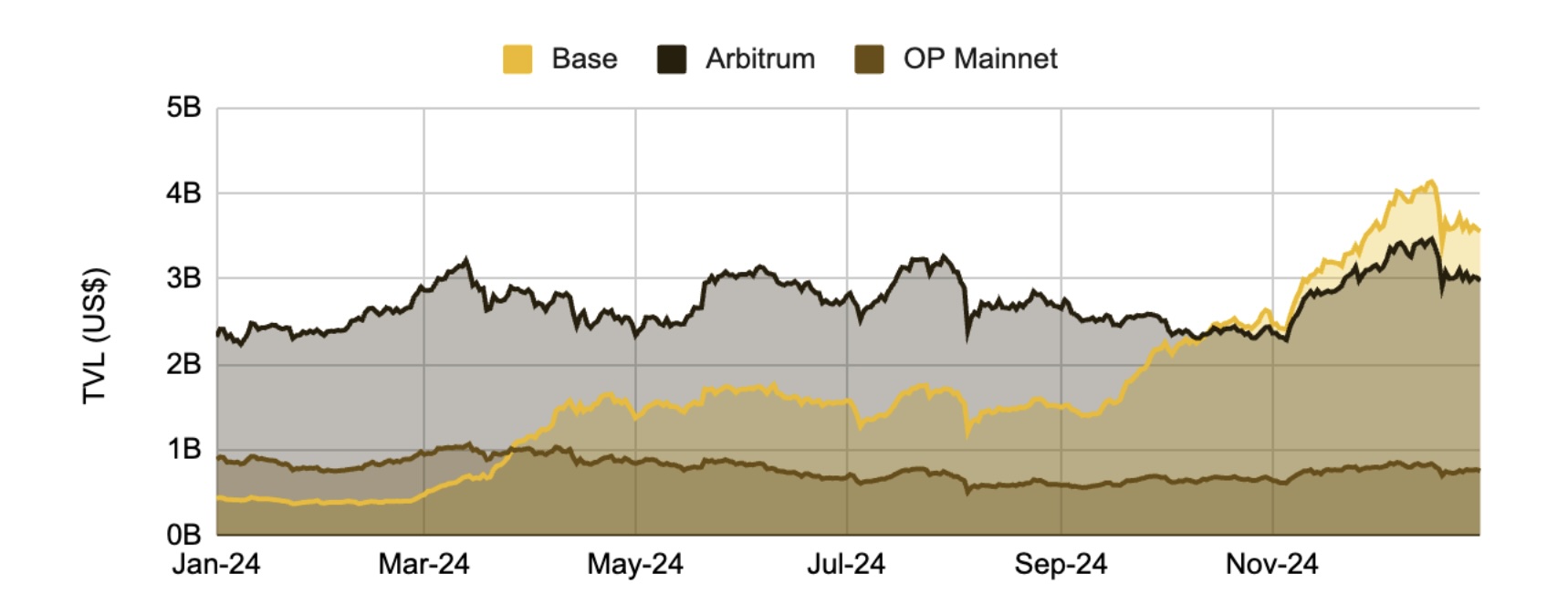
Although Arbitrum has been losing ground to newer L2s in terms of TVL, it has significantly outpaced even some of the largest L1 chains in terms of growth of stablecoins. Over the past 3 years, growth of stablecoin supply on Arbitrum has grown steadily, surpassing Solana’s in March 2023 and remaining higher for much of 2024. Starting in October 2024, the stablecoin supply on Arbitrum saw a large uptick, pushing it ahead of BNB Chain for the first time and surging from US$4.3B to US$6.7B over the past 3 months.
Figure 40: Arbitrum became the chain with the 3rd largest stablecoin supply, behind only Ethereum and Tron, with a market share of 3.4% (~US$2B worth of USDC is locked in the Hyperliquid Bridge)
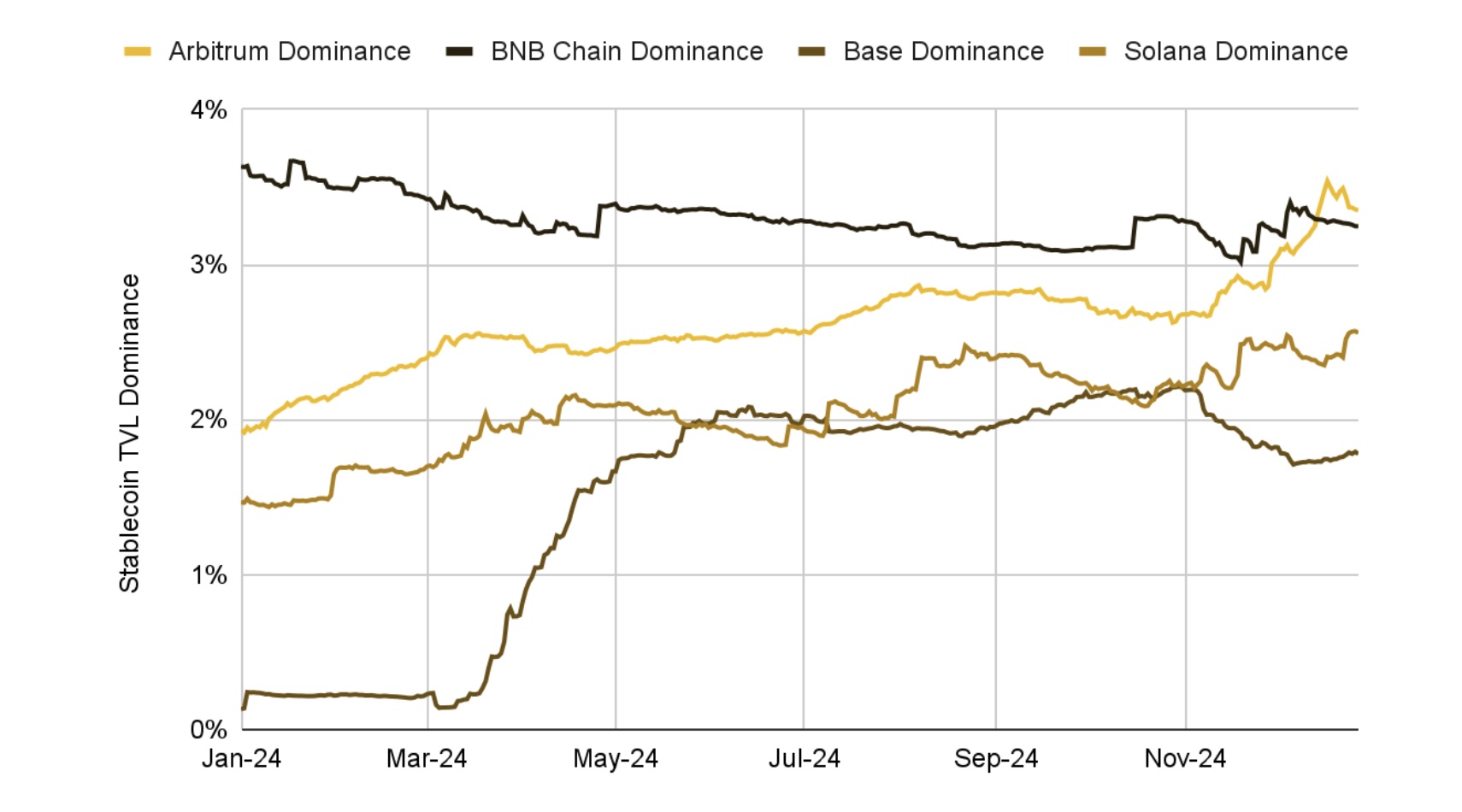
The surge that began in October was likely largely driven by the launch of various RWA tokenization projects on the chain, such as Franklin Templeton’s and Blackrock’s tokenized money market funds. Another key driver to stablecoin growth on Arbitrum was Hyperliquid, which currently accounted for ~US$2B worth of USDC locked in their bridge.
In addition to stablecoins and RWAs, the Arbitrum Orbit ecosystem has also seen major growth in 2024 for the gaming and consumer use cases, with the launch of chains like XAI, Proof of Play, and Apechain which utilize the Orbit technology stack.
Building on the momentum of 2024, there are a number of interesting L2s and Layer 3s (L3) coming to the Arbitrum Orbit ecosystem in 2025, which continue to expand the range of purpose-built chains built using Arbitrum Orbit.
Corn – a BTCfi chain built using the Arbitrum Nitro stack, that will use BTCN, a 1:1-backed, bridged version of Bitcoin, as its gas token. On August 22, 2024, Corn launched an airdrop campaign allowing users to earn points (Kernels).
Rivalz – a decentralized peer-to-peer network for modular AI applications, it offers a secure source of verifiable personal, credential, and behavioral data, with built-in privacy and intellectual property rights. It is the first Player-to-AI network built on Dymension and powered by Celestia Labs.
Animechain – from the team behind the Azuki NFT project, Animechain aims to enhance creators’ creativity with AI-based production tools. Using AI Rights Assets (AIRA) and a unique token system, it supports the sustainable growth of the anime and content industry. They released a litepaper in May 2024.
Plume – with its mainnet launch slated for early 2025, Plume aims to simplify the process of bringing off-chain assets, such as real estate, art, and financial instruments, onto blockchains by handling paperwork, custodial requirements, and more.
OP Mainnet
The Optimism Superchain has been gaining significant traction in terms of attracting new users and retail activity. Across the second half of 2024, it has been the source of a large proportion of the total crypto transactions, accounting for ~54% of the total L2 transactions, and ~6.8% of the total crypto transactions in December 2024.
Figure 42: The Optimism Superchain was responsible for 54.5% of total L2 transactions and 6.8% of total crypto transactions in December 2024
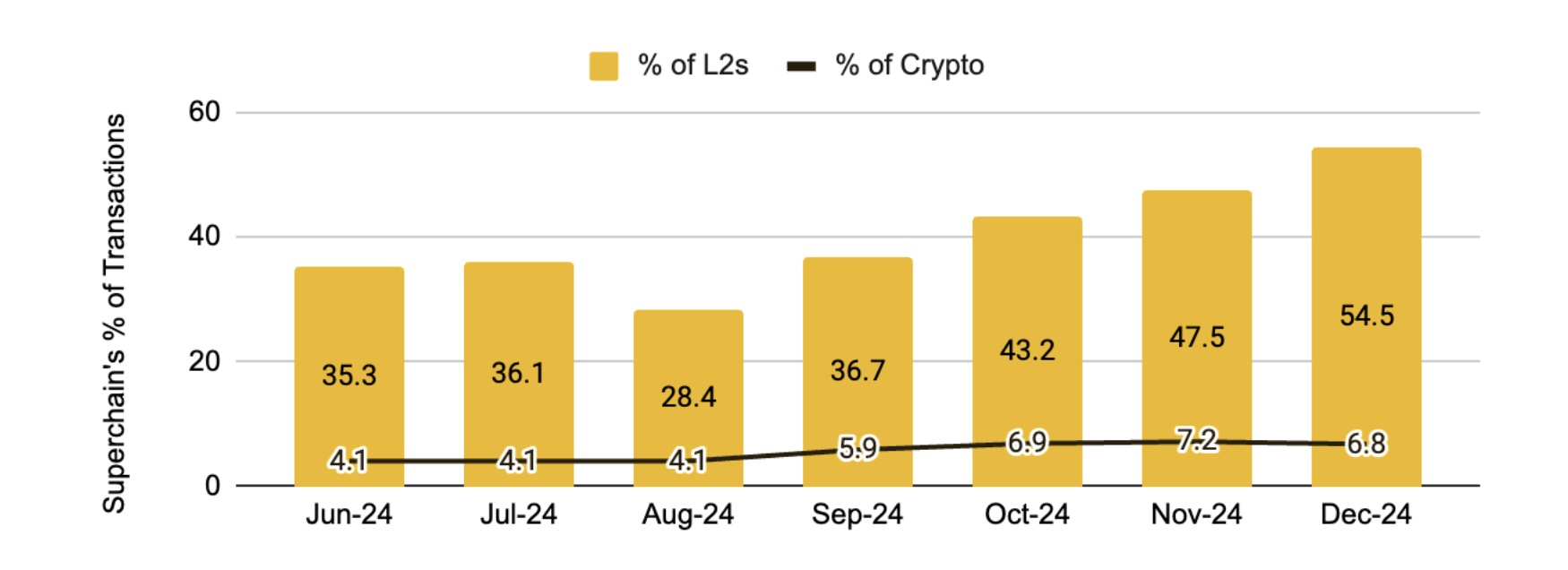
Overall, the OP Superchain has experienced tremendous growth in terms of usage in 2024, driven in large part by the success of the Base L2. On top of the increased activity on existing OP Stack chains, it was also a huge year in terms of the number of new L2s added to the Superchain.
The OP tech stack continues to be adopted by companies, both crypto-native and otherwise, looking to launch their own L2s. Two major Superchain L2s to look out for are:
Unichain – developed by the team behind Uniswap, Unichain is a DeFi-native Ethereum L2, optimized to be the home for liquidity across chains. The team has announced plans to launch mainnet in early 2025.
Soneium – on August 28, Sony Block Solutions Labs (Sony BSL) launched the Soneium Minato public testnet and the Soneium Spark incubator. The L2 Soneium
The Zero-Knowledge Rollups
In Q2 and Q3 of 2024, ZK rollups saw a significant uptick in TVL, driven largely by the slew of airdrop campaigns. As the airdrop farming fervor cooled however, we saw capital flow out from the ZK rollups, bringing their total TVL down over 50% from its peak of US$2.1B to US$1.1B.
Figure 44: TVL across ZK rollups peaked at ~US$1.6B in July, before retracing to ~US$1B as of December 2024
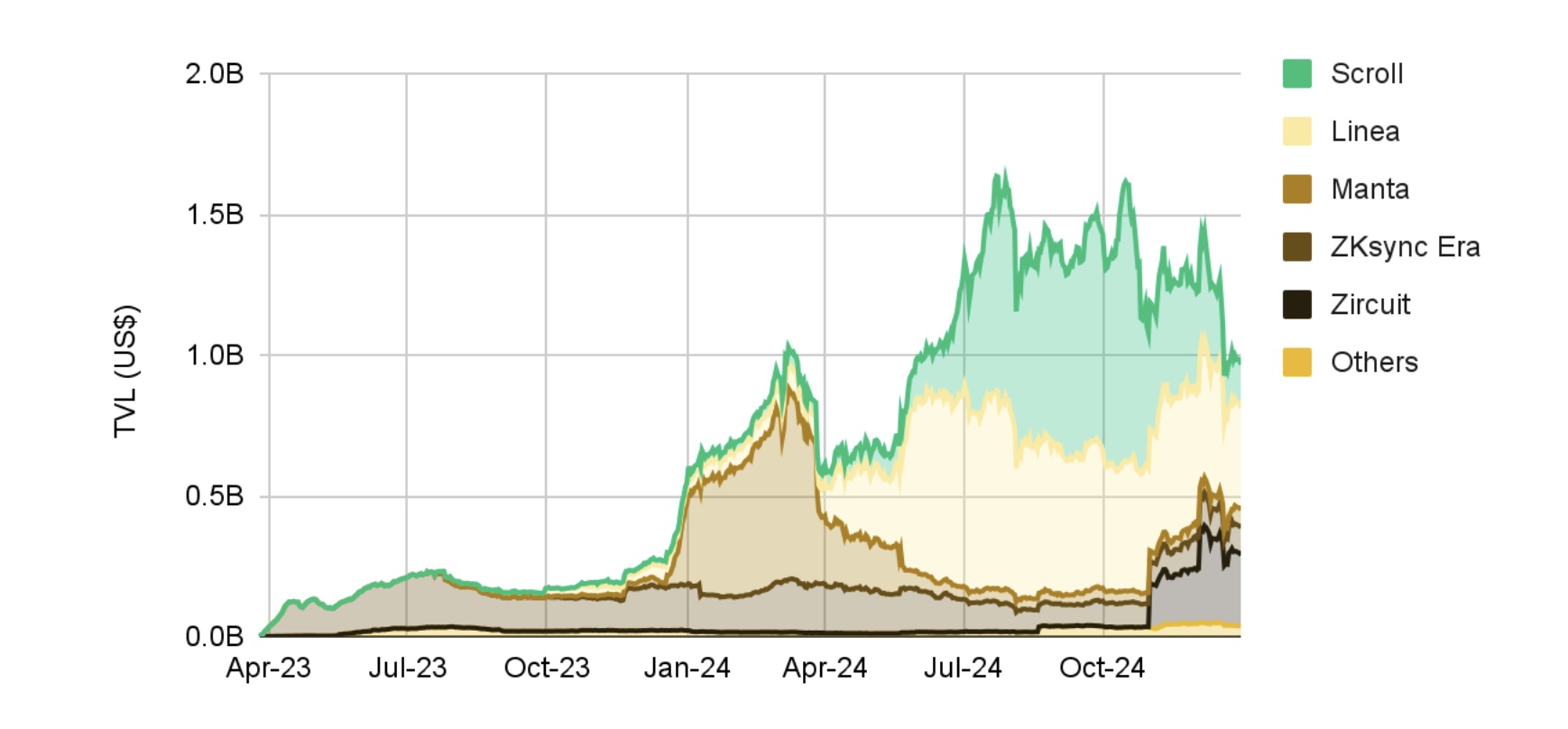
zkSync Era
Matter Labs, the developer of the ZKsync layer-2 network, introduced the ‘Elastic Chain’ in July as part of its ZKsync 3.0 roadmap. Similar to Polygon’s AggLayer, which was announced in January 2024, the Elastic Chain aims to unify custom blockchains created with the ZK Stack toolkit , providing a seamless user experience akin to a single chain.
Having debuted June 2024, the Elastic Chain is seemingly off to a good start. We saw a number of notable projects choose to make use of the ZK tech stack to launch their own L2s over the course of the year.
Deutsche Bank (Project Dama) – In December, the Germany-based global MNC Deutsche Bank announced its intention to develop a public and permissioned Ethereum L2, leveraging the ZKsync technology stack. This move is part of Deutsche Bank’s effort to enhance efficiency and cost savings in regulated financial services while tackling privacy and transaction challenges.
Abstract chain – Scheduled to launch its mainnet in Jan 2025, Abstract chain is coming hot on the heels of the hype around the Pudgy Penguins ecosystem, which just launched its $PENGU token airdrop on December 17. Abstract is co-built by Igloo Inc., the parent company of the Pudgy Penguins NFT project. Abstract chain intends to be a consumer crypto chain, featuring native account abstraction, aimed to provide a seamless end user experience.
Treasure L2 Chain – TreasureDAO, previously an Arbitrum-based gaming platform, launched its Treasure L2 mainnet using the ZKsync tech stack in December 2024.
Cronos zkEVM – First chain (after ZKsync Era) to go live as part of the ZKsync Elastic Chain, launched mainnet in August.
Lens – Slated to launch in early 2025, the team behind social network protocol Lens is partnering with the team behind Aave, Avara, to design the new ZK L2 to cater to SocialFi applications, incorporating customisable features like accounts, usernames, graphs, feeds, and groups.
Polygon Agglayer
In January 2024, the Polygon team introduced AggLayer. AggLayer integrates fragmented blockchains into a cohesive network of ZK-secured L1 and L2 chains, functioning as a single chain. It aggregates ZK proofs from all connected chains, unifies liquidity and assets across multiple chains in a seamless manner, and ensures secure, near-instant cross-chain transactions.
In a December blogpost, Agglayer announced its intentions to focus on four specific verticals:
DeFi – AggLayer aggregates liquidity across blockchains, eliminating the need for developers to deploy on multiple chains, split liquidity, create new liquidity for each wrapped token, and use bridges. This introduces expanded design spaces for developers to build unified DeFi solutions.
Gaming – Agglayer will allow gamers to avoid being locked into a single chain. Connections will include Ronin, Immutable, Moonveil, Wilder World, and others. The launch of the Immutable zkEVM gaming-purpose chain was a notable development on this front in 2024.
RWA – AggLayer simplifies integration between disparate RWA systems, creating a unified environment and enabling a true market for RWAs.
AI + DePIN – Easier integrations and improved cross-chain data sharing enable seamless AI system collaboration across platforms. Built-in security mechanisms ensure trust, while enhanced interoperability accelerates innovation.
On December 20, 2024, AggLayer launched its testnet v0.2 to stress-test pessimistic proofs. With the mainnet launch anticipated in early 2025, competition within the ZK rollup ecosystem could begin to intensify . This could potentially lead to a duopoly between AggLayer and ZKsync Era, reminiscent of the competitive dynamic between Arbitrum and OP Stack in the optimistic rollup space.
Linea
In November, the Consensys-backed L2 announced plans to launch its LINEA token in Q1 2025. This would make it the final major ZK rollup to launch a token in the foreseeable future, following the likes of competitors like Manta, ZKsync Era, StarkNet, and Scroll, which all launched their tokens in 2024.
Against the backdrop of the Linea token airdrop purportedly coming in early 2025, the chain currently holds the number one spot in terms of DeFi TVL among ZK rollups at over US$360M. Although its daily active address count has declined significantly from its peak in July of 796K, Linea retains the highest daily active addresses amongst the ZK rollups at just over 41K.
Figure 45: Linea retains the highest daily active addresses amongst ZK competitors, at just over 41K as of December 2024
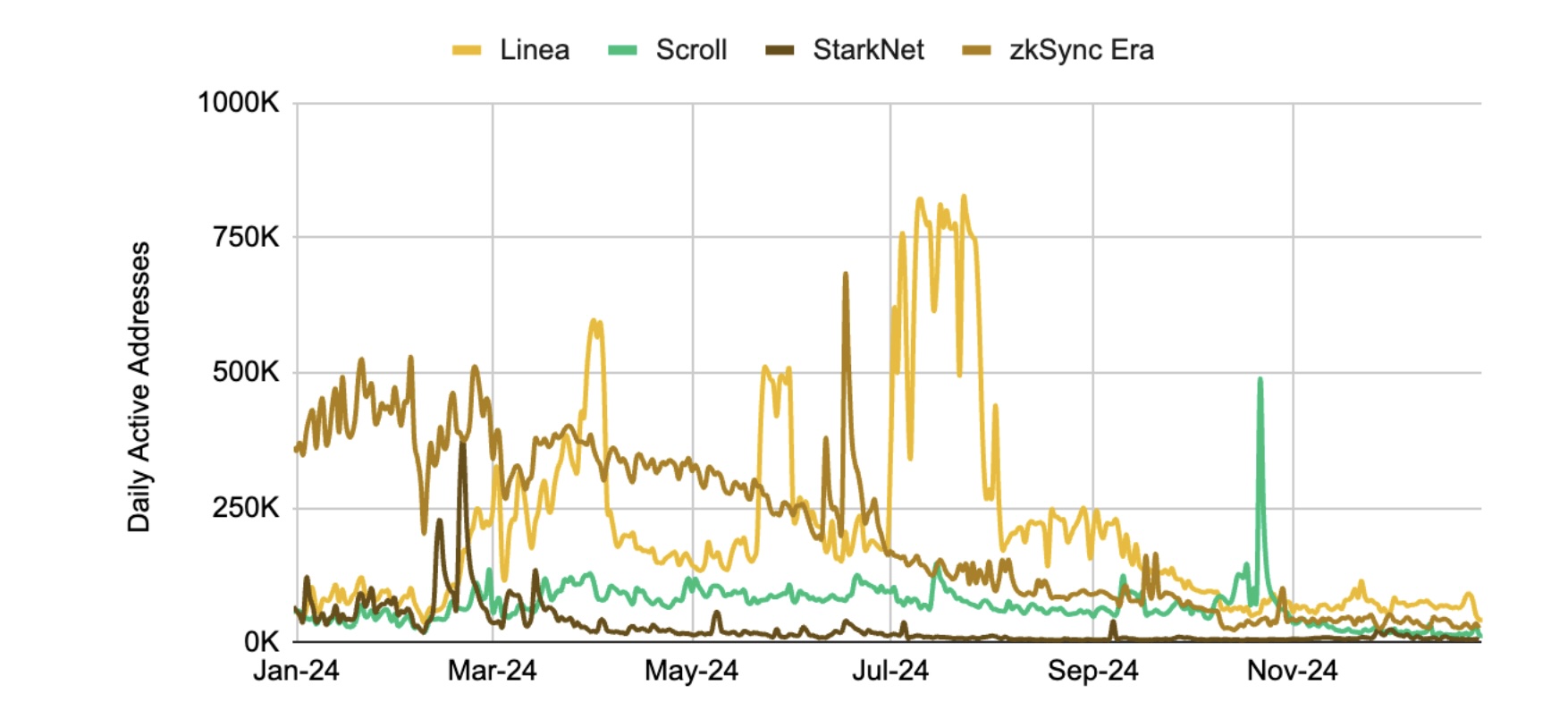
In October 2024, the Linea team reaffirmed its commitment to decentralizing the protocol with a proposal titled “Towards Linea’s Decentralization.” This proposal outlines a plan to transition the zkEVM to a permissionless system and establish decentralized governance by changing the current block validation, block proposal, and finalization processes.
Monitoring the adoption rate of the Linea L2 in 2025, along with its competition with other L2 solutions, could offer early insights into how the market evaluates different decentralization strategies. The decentralization of the L2 sequencer, in particular, has been a prominent topic of discussion within the Ethereum community in 2024.
Decentralized Finance
The Big Picture
The past year marked a renaissance for Decentralized Finance (DeFi), proving largely positive compared to previous years. While some sub-sectors stagnated and certain metrics lagged, others broke records, showcasing DeFi’s importance as a core growth driver for the industry. The biggest gain came from a broadening market base, fueled by new on-chain products, nascent narratives, diversity across chains, and the prospect of a more favorable regulatory environment post-U.S. election — leaving plenty to anticipate in the new year.
Accompanying these trends was a notable influx of capital into DeFi. With 2024 ushering in bullish market conditions, increased user activity, and stronger investor appetite, total value locked (TVL) surged to US$119.3B from US$54.3B, representing a strong 119.7% year-to-date (YTD) gain.
Figure 46: DeFi TVL surged 119.7% in 2024, reaching US$119.3B
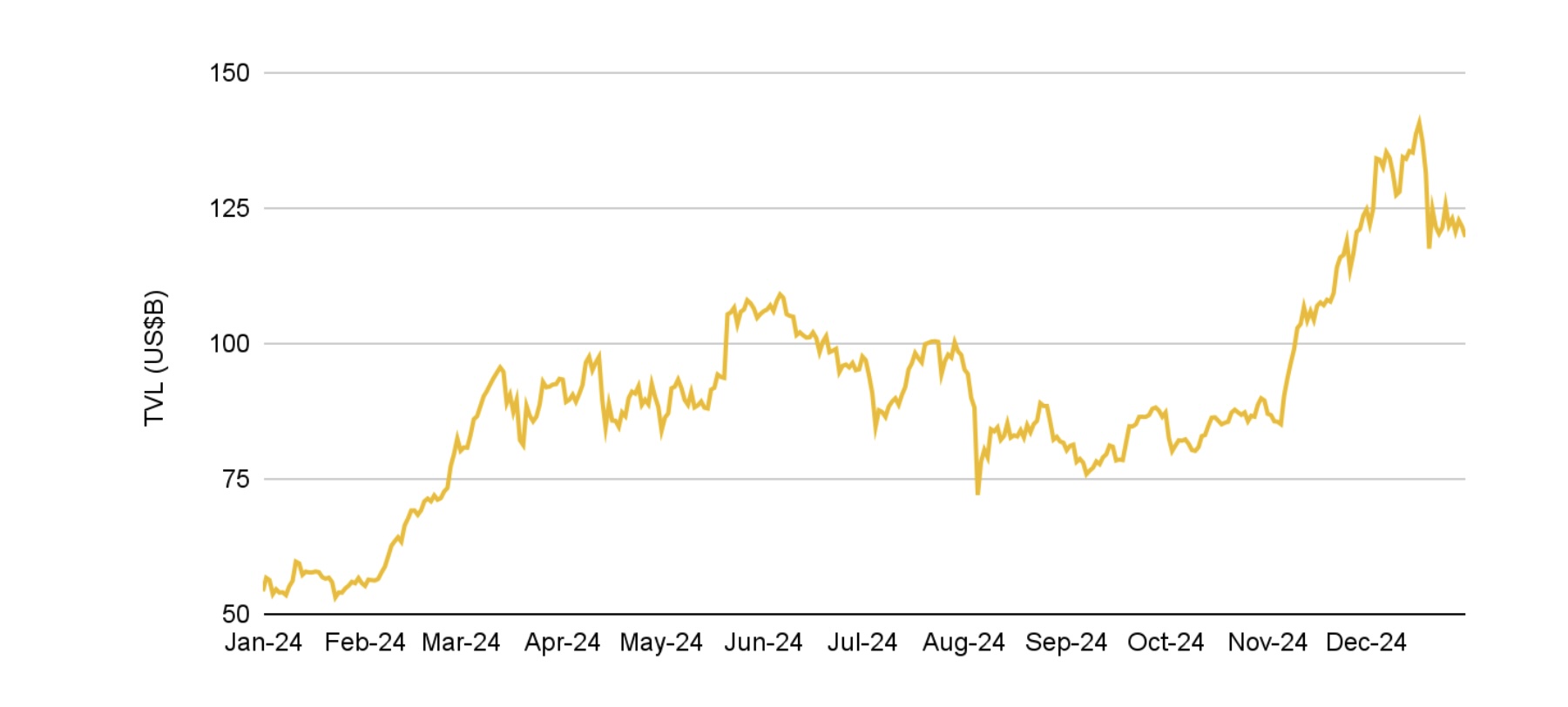
However, DeFi Dominance — which measures DeFi’s share of the global crypto market cap — presents a different picture, slipping from 4.5% to 3.7% despite a brief reversal following the U.S. election in November 2024. Over the course of the year, it declined by 0.8% in absolute terms. While the sector has attracted substantial capital inflows, DeFi’s public market valuations still trail the broader crypto market, indicating room for further growth. This also suggests that investors may be focusing on select DeFi niches or directing their capital to other areas of the crypto ecosystem.
Figure 47: Despite a reversal in November, DeFi dominance posted a 0.8% decline in absolute terms for 2024

In terms of user adoption, DeFi remains a primary gateway for newcomers on-chain, with the average number of unique monthly users jumping from 5.0M to 20.8M over the past year. While this growth is impressive, airdrops from notable blue-chip DeFi projects have played a role in boosting these figures. Nonetheless, monthly unique users have consistently hit new all-time highs throughout 2024, underscoring the sector’s continued strong engagement.
Figure 48: Unique monthly users across DeFi protocols soared by 314.6% in 2024
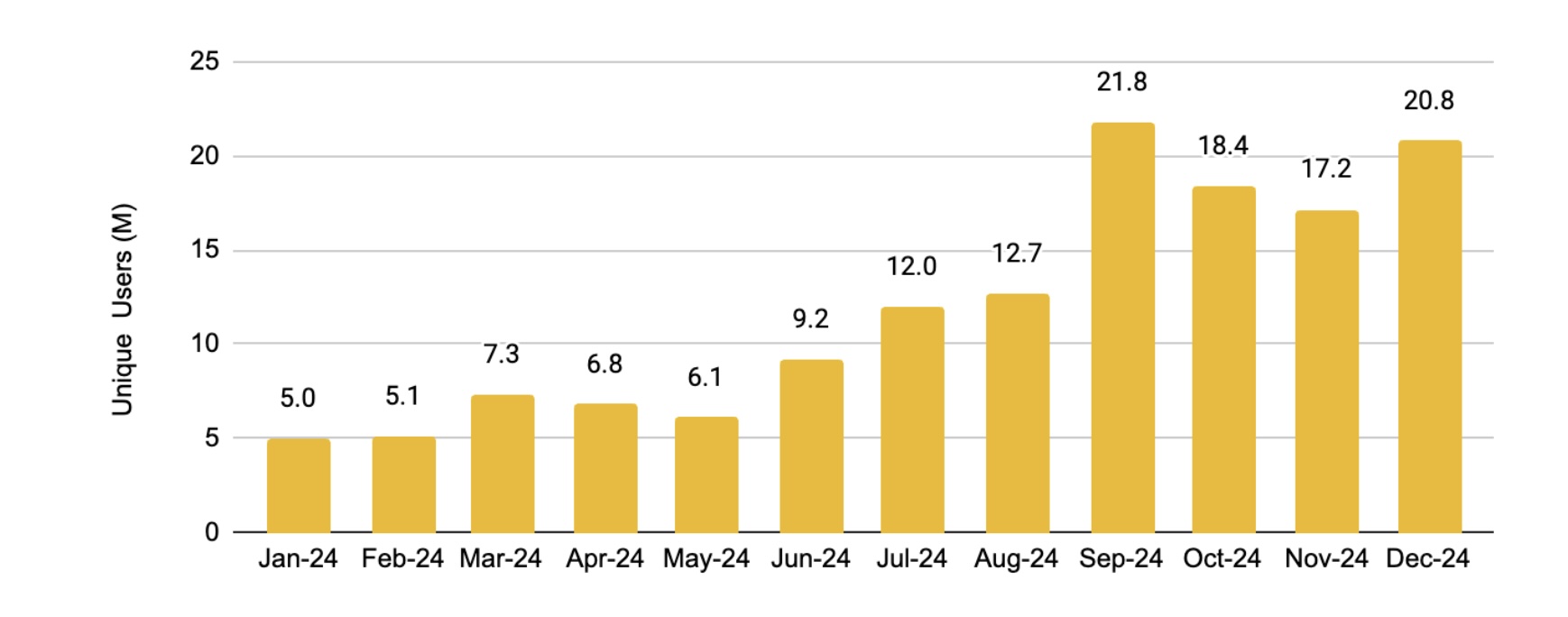
Breaking this down by sub-sector, this year’s capital influx has reached well beyond the traditionally dominant categories, reshaping market dynamics. An analysis of capital distribution reveals significant growth across nearly all DeFi sub-sectors, with particularly large gains in 2024 in emerging areas like Restaking and Basis Trading. Liquid Staking continues to hold the top spot by TVL, followed by Lending, Bridge, Restaking and Decentralized Exchanges (DEXes). Sub-sector diversity has also expanded overall, creating a more competitive on-chain environment. Among these sub-sectors, DEXes boast the highest number of protocols, underscoring their critical role in driving liquidity throughout DeFi markets.
Figure 49: Every major DeFi sub-sector recorded a notable influx of capital in 2024
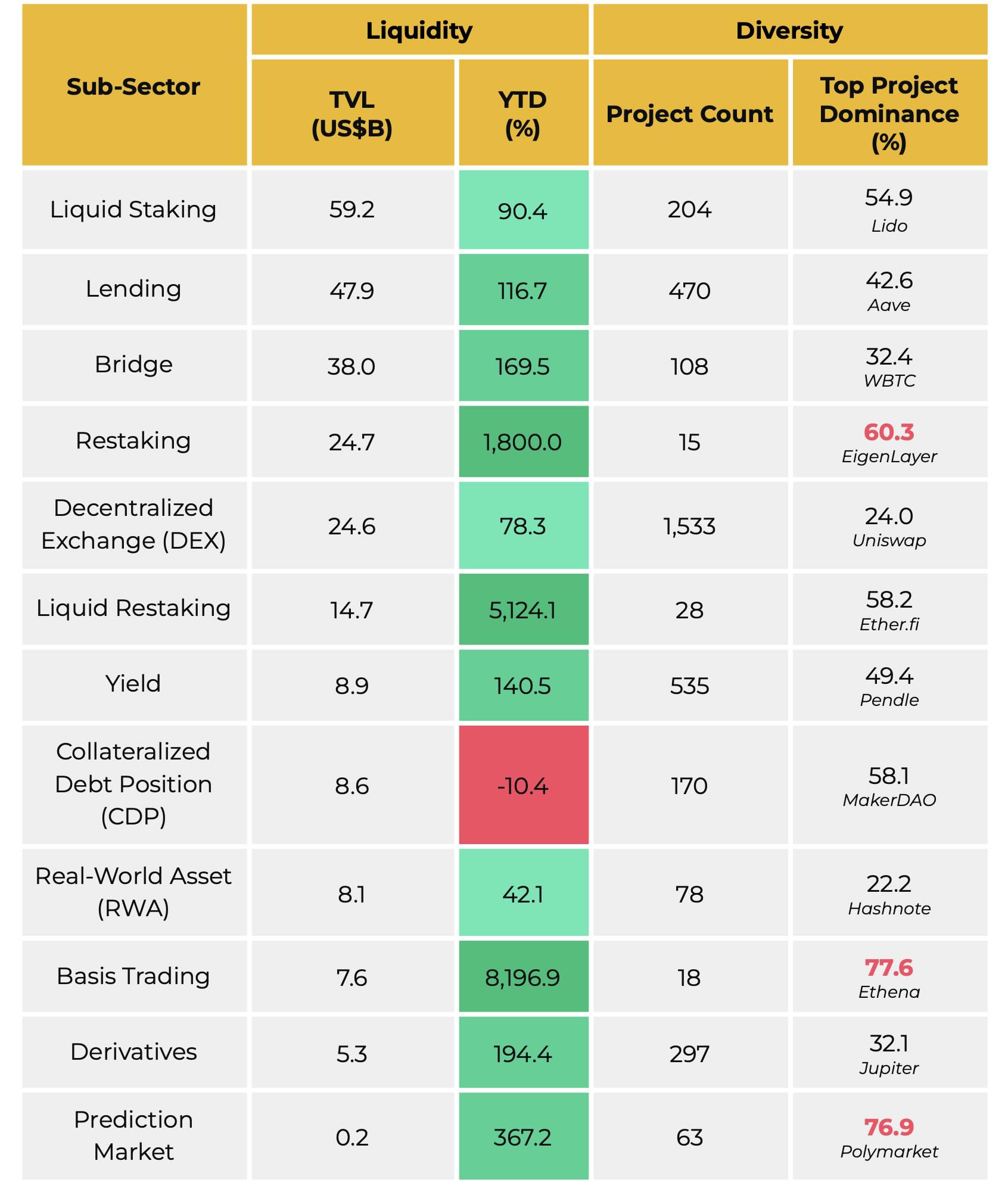
Sub-Sector Spotlight
Liquid Staking, Restaking and More
Liquid staking remains the largest sub-sector in DeFi by TVL, with Lido maintaining its position as the market leader. While Lido’s TVL grew by 52.1% YTD, its dominance has experienced a modest decline over the past year. These shifts in market share are primarily driven by staking derivatives expanding to other blockchains — Jito on Solana, for example, recorded a 329.5% YTD growth in TVL — and the emergence of new sub-sectors like restaking and liquid restaking, which provide alternative ways to stake ETH. These developments, combined with the push to decentralize Ethereum’s staking infrastructure, are actively reshaping the liquid staking market.
Figure 50: While still the largest, Lido has seen its market share decline from 68.4% to 54.9% as multiple competing forces emerge

While established protocols like Lido have yet to face significant competition threatening their dominance, the advent of restaking has introduced new competitive pressures from an adjacent sub-sector. Users now have access to multiple layers of Ethereum’s staking ecosystem through various platforms, often accompanied by the prospect of higher yields. The growing interplay between liquid staking and restaking will be a key area of interest in the evolution of the staking derivatives market.
Figure 51: Several alternative and attractive sources for staking ETH, beyond liquid staking, gained traction in 2024
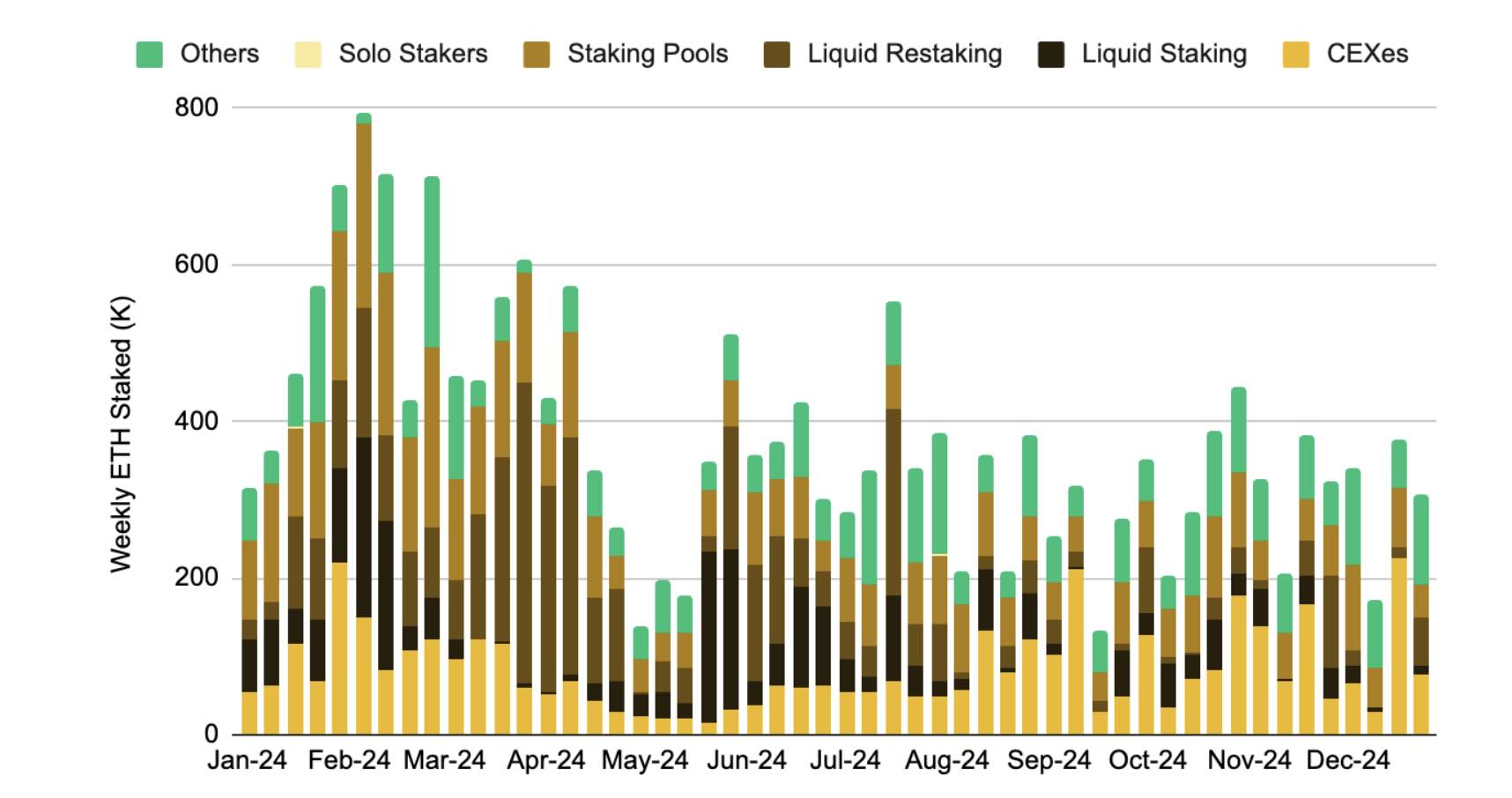
Restaking emerged in 2024 as an innovative method for rehypothecating staked ETH collateral. By allowing staked ETH to secure multiple decentralized infrastructures simultaneously through Proof-of-Stake (PoS), restaking introduced a novel approach to bootstrapping network security while maximizing on-chain yield. Leading the restaking space is EigenLayer, starting the year with US$1.3B in TVL — primarily in liquid staked ETH — and reaching over US$20B at its peak. Although TVL has since declined to US$14.9B, likely due to capital outflows following a retroactive airdrop announcement, EigenLayer remains the third-largest DeFi protocol by TVL, behind only Lido and Aave.
The growth of EigenLayer has paved the way for broader developments in the restaking ecosystem. Emerging protocols like the Paradigm-backed Symbiotic and Karak have started to challenge EigenLayer’s dominance, though currently on a smaller scale. This diversification is widely viewed as a positive step, decentralizing a market fundamentally tied to network security and fostering competition that could drive further innovation within Ethereum’s restaking layer. Moreover, the concept of restaking is expanding beyond Ethereum. For instance, Babylon has become the largest Bitcoin-based restaking protocol, amassing US$5.3B in TVL. Collectively, these developments underscore the underlying demand for on-chain yield generation through shared crypto-economic security .
Figure 52: While EigenLayer has maintained dominance in the restaking space, market share is gradually diversifying, extending to other networks
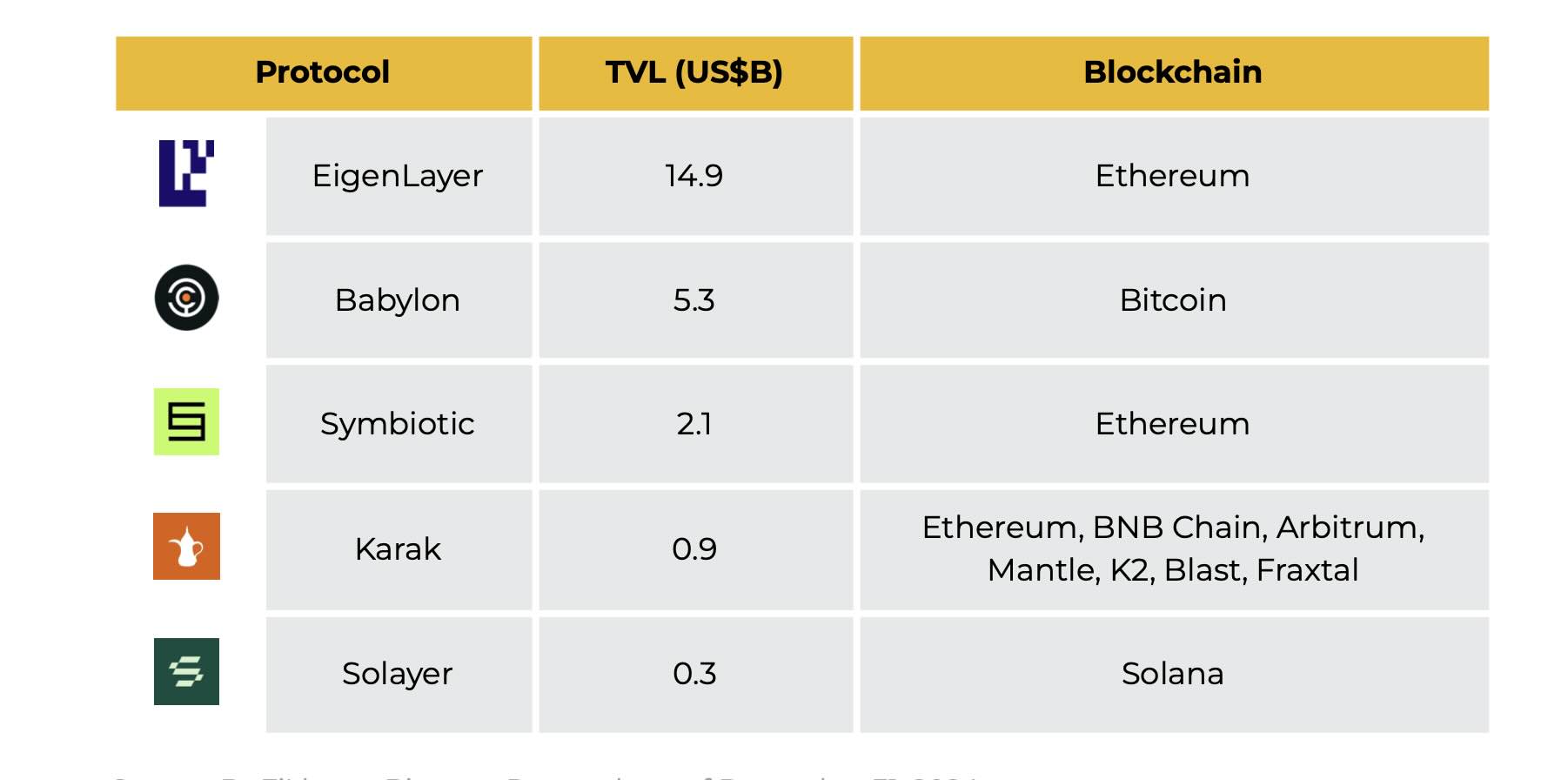
Despite attracting this TVL growth, restaking remains a relatively nascent sub-sector, with room to develop as the ecosystem matures. Most projects are still in their early stages and not fully operational, with only a few Actively Validated Services (AVSs) showing tangible progress in use cases such as oracles, data availability (DA), shared sequencing, and cross-chain messaging. The services secured by restaking are largely still under development and currently do not generate meaningful yield.
The long-term demand for restaking will ultimately depend on whether the opportunity costs and the additional real yield these services eventually produce justify their associated risks. This balance will be critical in determining the sustained growth and viability of restaking as it evolves.
A key progression in the restaking space is liquid restaking, which introduces tokenized versions of restaked assets. This approach allows users to retain liquidity while participating in the staking economy. Ether.fi has taken a leading role in this sub-sector, leveraging its early-mover advantage to reach a TVL of US$8.6B, positioning it as the fourth-largest DeFi dApp. Notably, more than half of Ether.fi’s staked ETH resides on Aave, making it one of Aave’s largest reserve asset classes.
While the popularity of liquid restaking reflects the market’s appetite for yield and leverage, much of the current activity has been driven by airdrops and incentive programs rather than organic demand for underlying products. As the sub-sector matures, its dynamics are likely to shift, potentially revealing more sustainable growth trends.
Figure 53: Ether.fi is the leading liquid restaking protocol, accounting for 58.2% of the total TVL
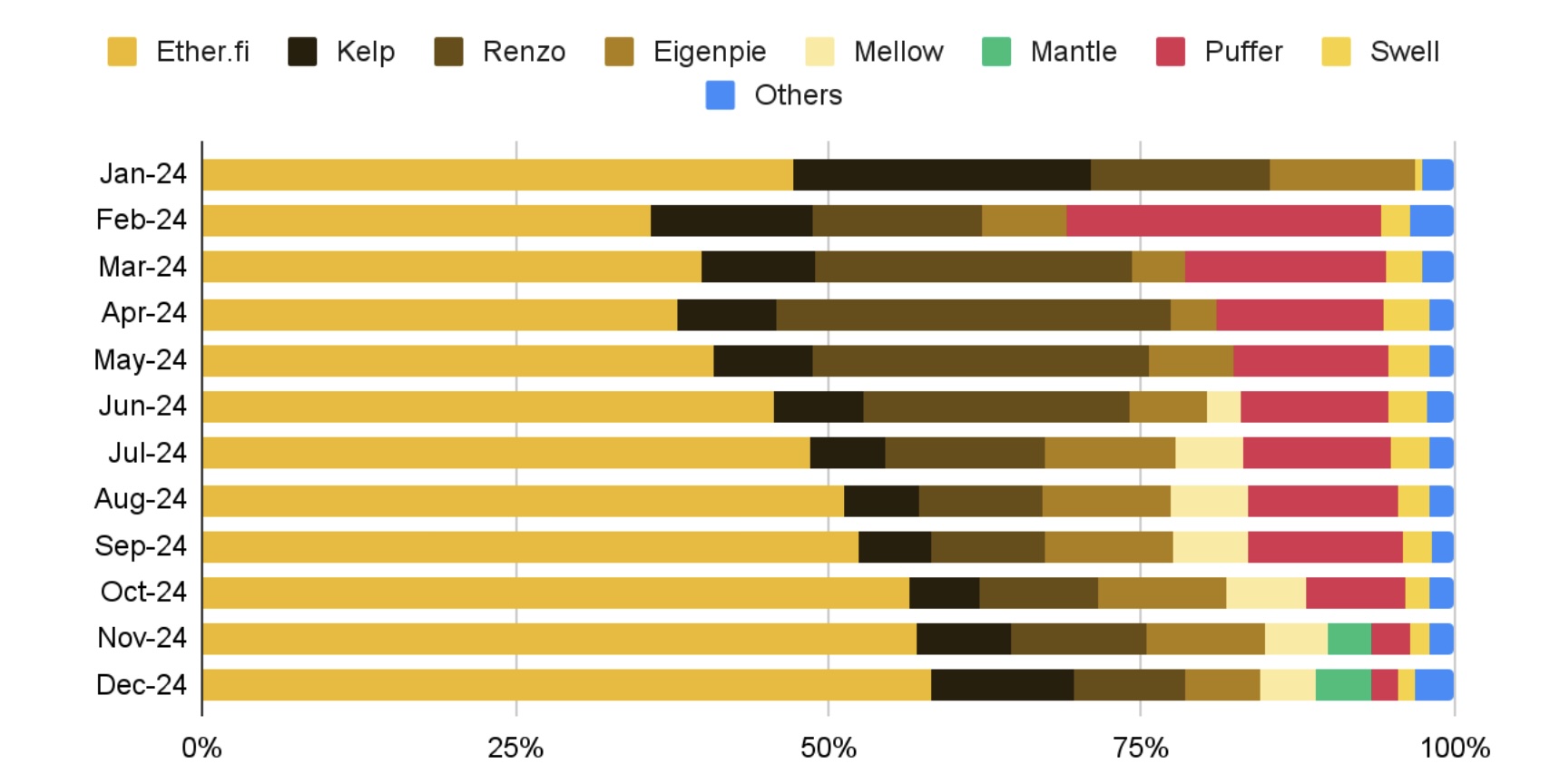
Money Market
On-chain money markets experienced remarkable growth this year, reaching a record high of US$55.1B before closing the year at US$47.9B, reflecting a 116.6% YTD increase. Increased trading activity and higher on-chain yields have reignited user interest in lending protocols, as participants seek enhanced market opportunities and leverage. While this growth reflects the broader market’s upward momentum, it also underscores the critical role of lending in DeFi’s evolution as the space moves toward its next phase of adoption.
Figure 54: Money market protocols saw substantial growth in TVL, rising 116.6% YTD to US$47.9B and peaking at a record US$55.1B in December 2024
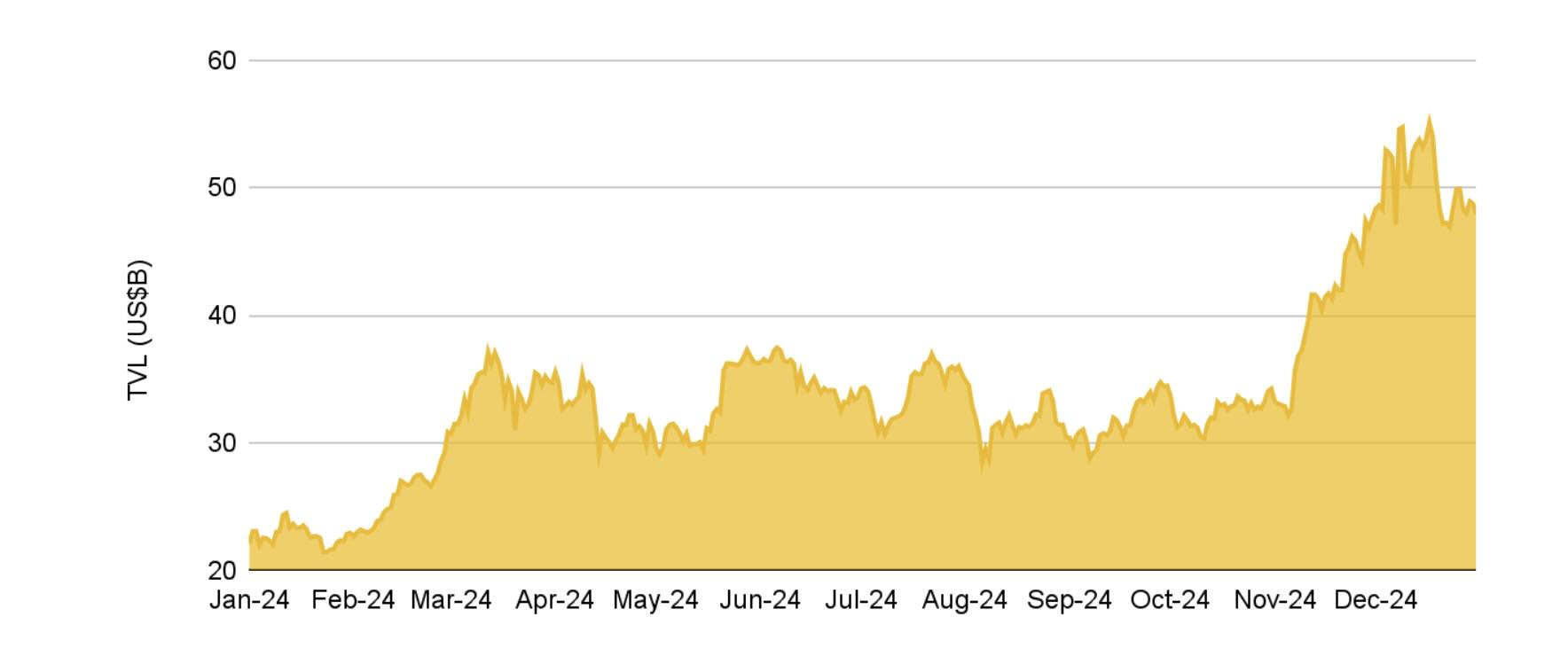
Aave has solidified its position as the leading lending protocol, significantly increasing its total outstanding debt YTD and reaching record highs in 2024. The upcoming V4 upgrade further strengthens its offerings by diversifying product capabilities and improving loan liquidity provisions. Key features include a unified liquidity layer supporting both supplied and natively minted assets, as well as improved integration with GHO, its native stablecoin.
Beyond Aave and Spark, traditionally dominant players in on-chain money markets, such as JustLend and Compound, are facing increasing competition from emerging platforms reshaping the landscape. Modular lending protocols like Morpho have achieved substantial growth, climbing to become the fourth-largest on-chain lending protocol with a 6.8% market share. Similarly, protocols operating beyond the Ethereum ecosystem are gaining momentum. Kamino, for instance, now accounts for 3.8% of the total lending TVL.
The growth of these competitors reflects rising demand for a broader range of long-tail assets as collateral and greater lending activity across networks beyond Ethereum. It also highlights the need for greater flexibility, less liquidity fragmentation, and better capital efficiency.
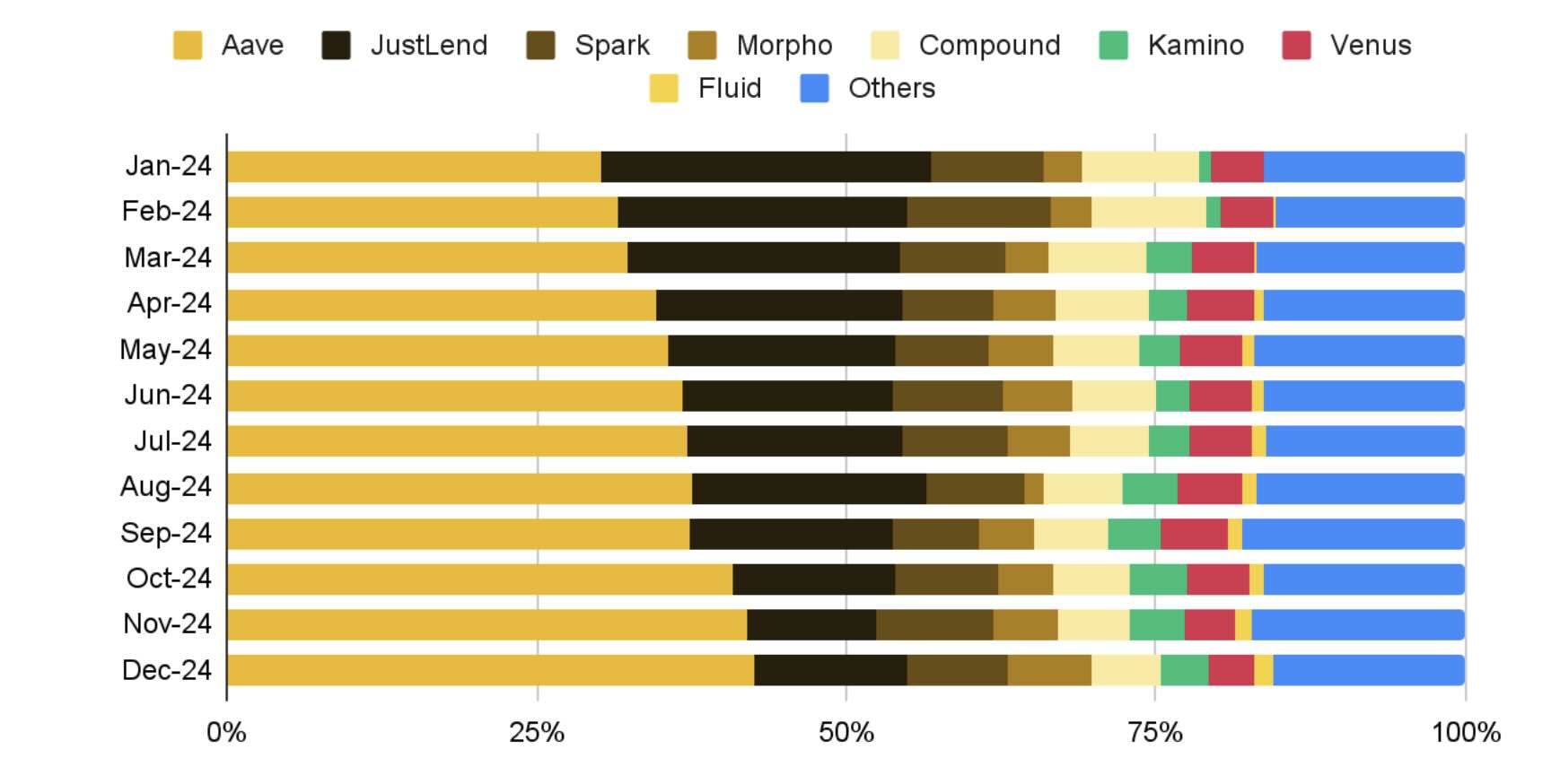
So far, over-collateralized lending has dominated on-chain money markets, allowing lenders to earn yield while borrowers secure loans by providing collateral that exceeds the loan value. This model prevails due to the decentralized and trustless nature of on-chain borrowing, which requires safeguards like over-collateralization and automated liquidation to mitigate default risks. These systems operate entirely through smart contracts, eliminating the need for off-chain processes such as credit scores, KYC, or traditional risk assessments.
In contrast, undercollateralized lending remains a niche segment, primarily because it depends on trust-based frameworks that are difficult to implement in decentralized and often anonymous environments. Borrowers in this model provide little or no collateral, requiring protocols to assess creditworthiness through mechanisms like KYC or off-chain verification. While potentially more capital-efficient, this approach faces hurdles such as centralization, higher default risks, and unattractive interest rates. Protocols such as Maple Finance and Goldfinch have made some progress by employing hybrid models that combine permissioned off-chain verification with on-chain functionality, yet there remains significant room for growth.
A promising development for undercollateralized lending lies in zero-knowledge technologies, such as zkTLS (Zero-Knowledge Transport Layer Security). zkTLS enables the secure integration of off-chain data, allowing borrowers to prove creditworthiness using information like credit scores, bank balances, or financial records — all without compromising privacy. Paired with zkCoprocessors, which enable trustless incorporation of on-chain data, these tools open the door for reputation-based lending in DeFi. Additionally, zk-enabled innovations could also support other lending models, such as payday loans and receivables-based borrowing, broadening the scope of DeFi lending products. As on-chain money markets mature, the diversification of lending designs will play a critical role in bringing DeFi closer to the frameworks and functionality of traditional finance (TradFi).
Spot and Derivative Decentralized Exchange (DEX)
This year marked a significant milestone for DEXes, with monthly spot trading volumes reaching a record US$436.0B and monthly derivatives volumes climbing to US$340.7B , both achieved in December 2024. The growth was primarily driven by the recent market upsurge, alongside new entrants achieving product-market fit with innovative solutions, and subsequently gaining ground on established entities. Together, these trends set the stage for further growth in both spot and perpetual DEXes in 2025. This is particularly encouraging given DEXes play a critical role in improving on-chain market efficiency and driving new activity across the DeFi ecosystem.
Figure 57: In 2024, spot and perpetual DEXes each traded over US$2.6T, significantly exceeding the total on-chain volumes recorded in 2023
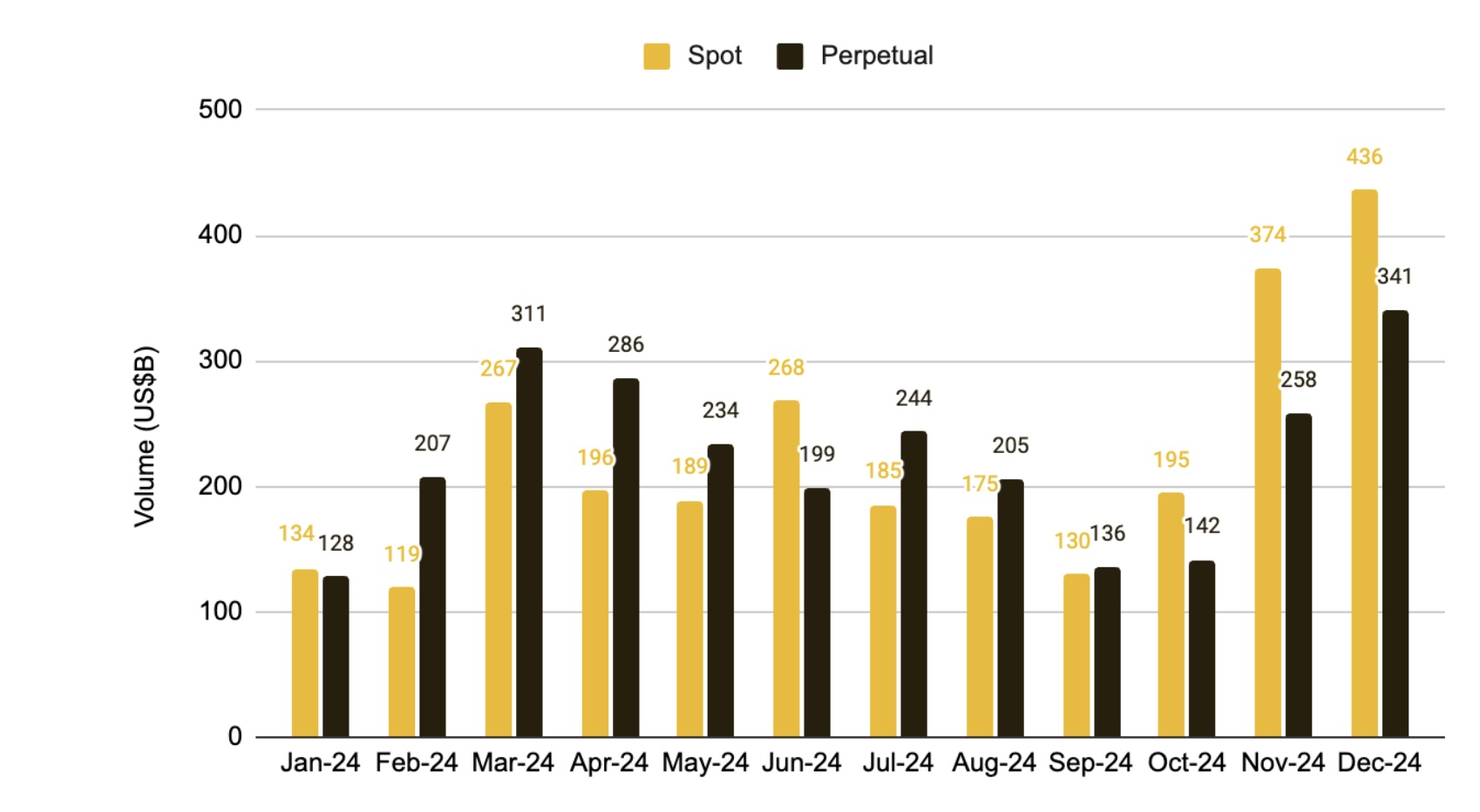
The DEX-to-centralized exchange (CEX) trading volume ratio also saw a strong upward trend in 2024, reflecting on-chain DEX volume growth. The spot DEX/CEX ratio reached a yearly high of 13.9%, approaching previous all-time highs, while the futures DEX/CEX ratio hit a record 9.9%. These trends highlight how renewed market optimism and trading activity have disproportionately benefited DEXes over CEXes in this cycle. This trajectory is expected to continue as DeFi evolves, offering advanced, CEX-like trading strategies that attract a growing number of traders entering crypto markets.
Figure 58: DEX/CEX ratios have risen significantly over the past year, with spot nearing previous highs and futures surpassing them
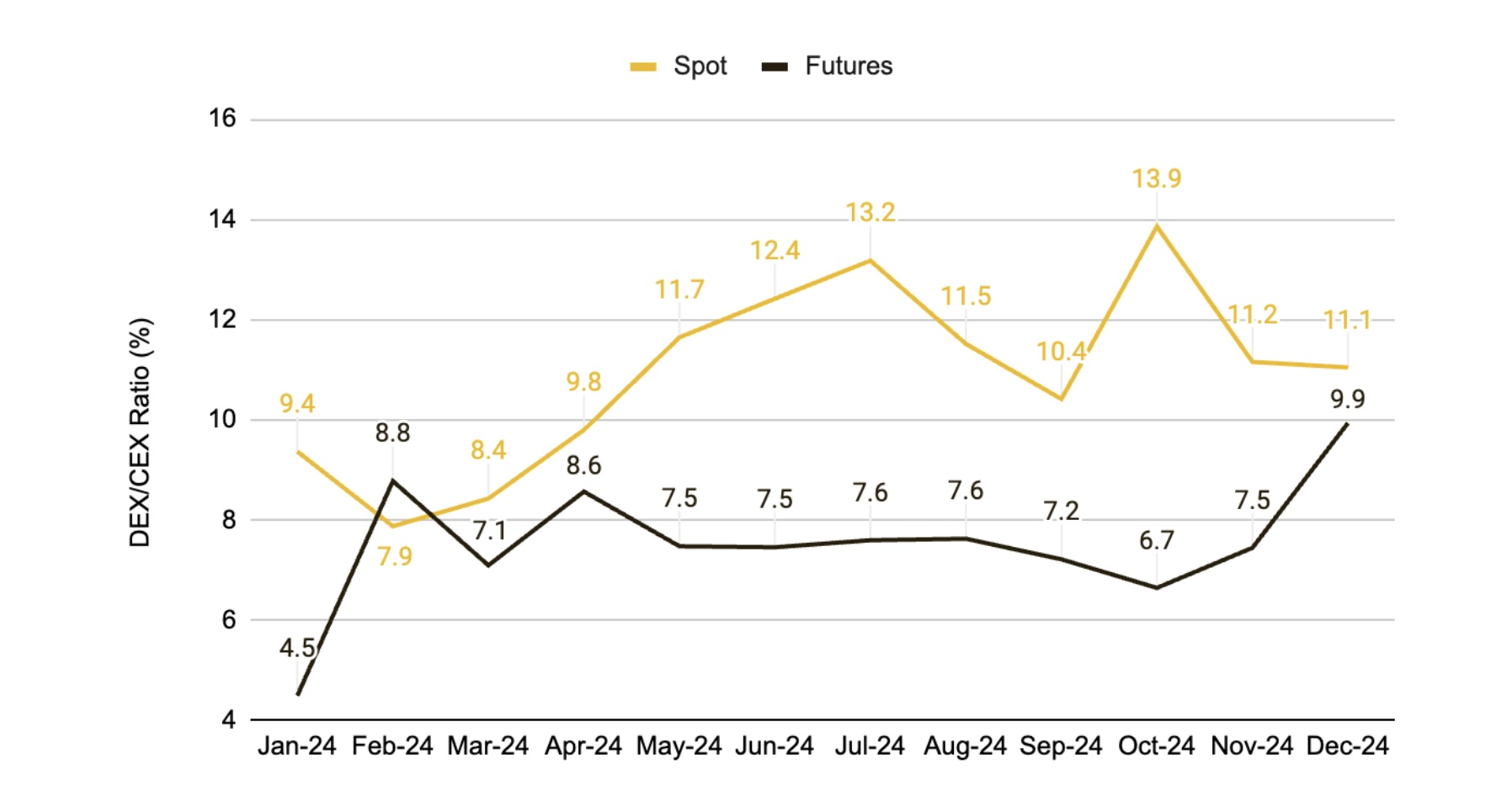
Key to this growth has been the improvement of on-chain trading experiences , which previously suffered from high fees, liquidity fragmentation, and performance bottlenecks. Innovations such as intent-centric and aggregator-based solutions, in-wallet swaps, and AI-powered tools have significantly improved trading routes and unified the DEX user experience (UX). While there is still room for refinement, these advancements — along with growing competition from new market entrants — are likely to propel the DEX space forward in 2025.
Turning to market participants, Uniswap remains the largest spot DEX by trading volume, but its dominance has steadily declined as the market diversified. Smaller players are gaining market share, driven by the launch of DEXes on Ethereum L2s and alt-L1s, which have expanded the number of blue-chip DEXes and added to the diversity of the DEX economy. Platforms like Solana’s Raydium and Orca, as well as Base’s Aerodrome, have emerged as strong competitors, accounting for a notable share of on-chain activity and, in some cases, surpassing traditionally dominant players in daily trading volumes.
Solana-based DEXes, in particular, have aptured niche markets such as memecoin trading through platforms like pump.fun, which democratize token creation while offering high speed, diverse token availability, and user-friendly interfaces. At its peak, Solana accounted for up to 50% of on-chain spot trading volumes. While the growth of Solana DEXes — and Pump.fun in particular — has been impressive, it remains to be seen whether they can maintain similar protocol metrics into 2025, especially as broader market volatility returns and trader attention shifts to other categories.
In response to these shifting dynamics, Uniswap’s upcoming V4 upgrade is poised to be a key development in its bid to reinforce its position as a leading DeFi liquidity and infrastructure powerhouse. New features such as extensible hooks, improved routing via UniswapX, and migration to the more performant Unichain reflect efforts to adapt to this evolving market landscape. However, it remains to be seen how these advancements will shape Uniswap’s ability to adapt and retain its market dominance moving forward.
Figure 59 Uniswap’s market dominance has declined this year but remains the leader with a 25.2% share, while Raydium and Aerodrome have grown significantly in 2024, capturing 14.0% and 6.7% of the market, respectively

In the derivatives DEX space, dYdX led early in the year but faced mounting competition from emerging protocols like Hyperliquid, SynFutures, and Jupiter. Among these, Hyperliquid has emerged as a standout, establishing itself as one of the largest on-chain derivatives platforms. Built as an L1 order book-based perpetual futures DEX, Hyperliquid combines the performance of CEXes with competitive fees and fully on-chain operations. The platform has also expanded into spot and exotic trading pairs, aligning with the broader trend of DEXes integrating several exchange-based solutions to capitalize on operational synergies.
Moreover, Hyperliquid effectively bootstrapped growth and attracted users by benefiting from the initial absence of a native token, which culminated in a highly successful community-oriented airdrop – one of the largest in crypto history. Its success underscores the market’s confidence in the potential of such on-chain financial primitives.
Figure 60: Hyperliquid emerged as the top-performing derivatives DEX in 2024, achieving US$156.8B in December monthly volumes and capturing 46.0% of the market share
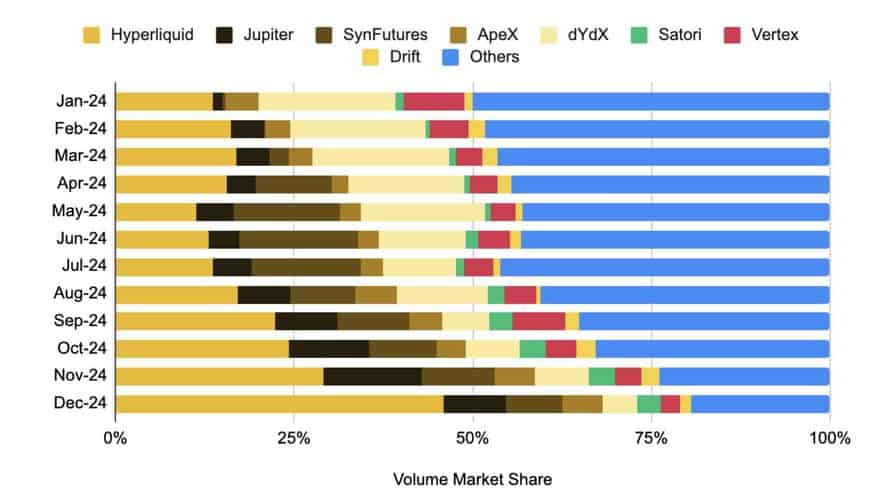
Despite recent market developments, DEXes, overall, still account for only a small fraction of total crypto market volumes, with on-chain derivatives representing an even smaller portion. This disparity is primarily due to the historically superior onboarding processes and UX offered by CEXes. However, much of the recent shift in market composition toward emerging DEXes has been driven by efforts to address these UX challenges, particularly in spot markets, rather than through large-scale innovations in on-chain design mechanisms. As the effort to replicate CEX-like experiences and features (such as high leverage and low spreads) becomes increasingly commoditized coupled with incentive structures that continue to favor short-term growth, DEXes that combine exceptional UX with unique on-chain trading products will be better positioned to differentiate themselves over the long term.
Beyond product innovation, distribution will also play a pivotal role in determining where trading volume concentrates. Integrations with wallet-centric or aggregator-based frontends are emerging as critical drivers of user demand by offering more seamless and intuitive trading routes compared to traditional DEX interfaces. Specifically, intent-based frontends, which are based on solver models, aggregators, and in-wallet swaps are already capturing a growing share of trading volume — a trend that is expected to gain further momentum heading into 2025.
Figure 61: On-chain trading volumes are increasingly being routed through external frontends rather than originating directly from DEXes themselves
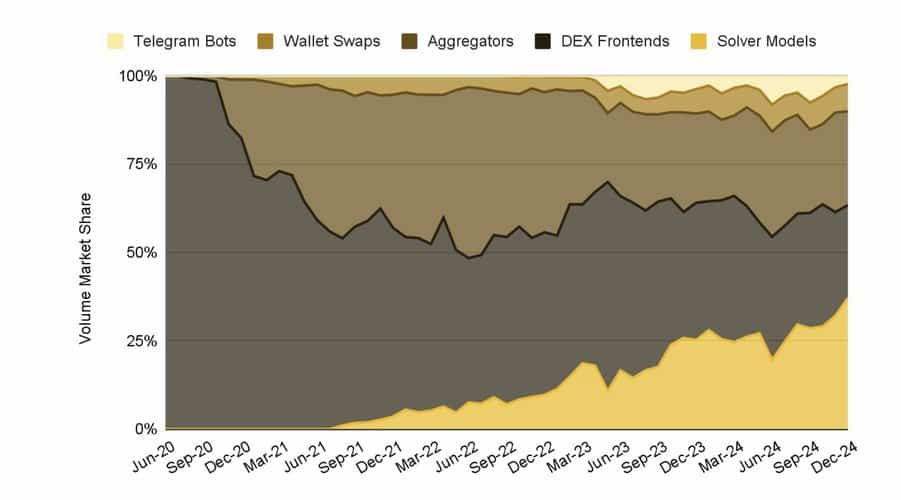
Areas to Watch
Growth Across Chains: In 2024, Ethereum grappled with challenges such as high fees, congestion, and fragmentation, driving a shift in transaction activity to L2s. Simultaneously, other chains emerged as strong contenders in specific DeFi sub-sectors. Solana, for example, captured significant trading volumes in memecoins, while Base drew attention with activity in trading majors and narratives like Crypto x AI. These chains gained traction by addressing user needs with low transaction costs and product-focused roadmaps.
A clear trend has also emerged toward purpose-built chains optimized specifically for DeFi, such as Hyperliquid and Unichain. Hyperliquid has developed a high-performance L1 capable of processing approximately 200K orders per second for its on-chain order book, while Unichain positions itself as a central liquidity hub and aims to address inefficiencies related to Maximum Extractable Value (MEV) and Automated Market Maker (AMM) design. While established L1s offer robust security, they may lack the agility needed for rapid iteration and innovation. Purpose-built chains, on the other hand, provide DeFi protocols with the flexibility to experiment and implement improvements at a much faster pace than general-purpose chains.
This shift highlights the growing diversification of trading volume and transaction activity across L2s and alt-L1s. Nevertheless, while more transactional activity may shift away, Ethereum is expected to retain its position as the dominant platform for DeFi liquidity, driven by its strength in areas such as stablecoins, staking derivatives, lending, and yield generation.
Regulatory Tailwinds: The re-election of Donald Trump as U.S. President signals a potential crypto policy overhaul. A renewed focus on crypto-friendly regulations alongside wider economic growth could create a more favorable environment for DeFi innovation. If clearer and more supportive regulatory frameworks emerge in 2025, DeFi could see the introduction of novel financial primitives designed to enhance the value it offers to users.
Policies that strike a balance between fostering innovation and implementing necessary safeguards could encourage the development of more tailored DeFi products and services. This includes models for value distribution, with many protocols exploring mechanisms like issuing dividends to token holders in the form of treasury funds or revenue-sharing frameworks. Such approaches are expected to increase the appeal of native DeFi tokens.
Leading dApps like Ethena and Aave have already initiated discussions or passed proposals to implement fee switches, which enable protocols to share revenue directly with users. Even protocols that previously rejected these mechanisms, such as Uniswap and Lido, may revisit their positions in response to the evolving regulatory clarity and growing competition within the space.
Unlocking Consumer DeFi: In its early days, DeFi’s complexities and clunky interfaces alienated everyday users. However, recent years have brought significant advancements in UX, security, and infrastructure, narrowing the gap between CEX and DEX platforms. Despite these improvements, the sector still largely attracts crypto-natives, while mainstream adoption remains sidelined.
To achieve widespread adoption, DeFi should prioritize user-friendly features such as seamless in-wallet experiences, intent-based frontends, and AI-driven interfaces. For this reason, vertically integrated ecosystems — where dApps operate on specialized chains purpose-built for DeFi — are gaining momentum, offering the necessary flexibility and greater control over UX and order flow.
Expanding DeFi composability will also be crucial, particularly through PayFi integrations that bridge DeFi with real-world applications. Examples include crypto debit cards that interact directly with DeFi protocols, enabling effortless everyday purchases using crypto assets. For DeFi to resonate to everyday consumers, it will need to incorporate banking-like features that require minimal behavioral changes, such as direct deposit and merchant payment support. The market has already observed a growing focus on these areas, highlighting their importance in driving mainstream adoption, and their increasing relevance in the year ahead.
Prediction Markets — Here to Stay?: Prediction markets took center stage in 2024, buoyed by the U.S. elections, which drove record user engagement and trading volumes in the months leading up to election day. Polymarket emerged as the biggest beneficiary, gaining widespread mainstream recognition and arguably becoming one of the most successful dApps of the year. To illustrate its impact, Polymarket onboarded nearly 1M new accounts — an exceptional case study for real user acquisition.
However, as expected, daily volumes on Polymarket dropped significantly after the elections concluded. To address this anticipated decline, Polymarket launched a post-election campaign aimed at incentivizing continued user activity on the platform. The challenge now lies in sustaining liquidity and user engagement across a broader range of market categories beyond election-related speculation.
While it is still in its early stages, prediction markets show preliminary signs of gaining traction and mindshare. Their utility as information tools during the U.S. election has also helped integrate them into mainstream discourse, providing a foundation for further growth. Polymarket’s success has also drawn attention to both new and existing prediction markets across various chains, making the space increasingly competitive.
That said, prediction markets face several challenges that must be resolved to take the next step in their evolution. Robust liquidity is critical for these markets to function efficiently, enabling users to place trades without dramatically skewing odds. Historically, liquidity has often been concentrated in a few popular prediction categories, leaving smaller, niche markets under-funded. This imbalance hampers adoption, trading activity, and the utility of these platforms as reliable information markets.
Looking ahead, the success of prediction markets will hinge on their ability to provide a diverse and appealing range of topics for speculation while effectively managing and allocating liquidity. The integration of AI participants could prove transformative, offering solutions such as content generation, event recommendations, optimized liquidity allocation, and enhanced information aggregation — all of which could profoundly influence market efficiency and accuracy. As a result, we may soon see prediction markets leveraging large language models (LLMs) as creators and resolvers of markets, further reshaping the landscape.
Bitcoin DeFi (BTCFi) to Push Ahead: Despite being the largest crypto asset, Bitcoin remains significantly underutilized in DeFi. The narrative of BTCFi has gained momentum this cycle, driven by Bitcoin’s strong market performance and growing institutional interest through spot BTC ETFs. These developments have contributed to the accumulation of idle BTC holdings, presenting opportunities to transform them from capital-inefficient to capital-efficient assets. Currently, this trend is centered on staking derivatives and lending but is likely to expand to other DeFi use cases, further embedding Bitcoin into the broader ecosystem.
TradFi’s Embrace of Real-world Assets (RWAs): Institutional involvement in crypto is gradually evolving beyond wealth managers merely allocating small portions of client portfolios to spot BTC ETFs. TradFi is increasingly taking notice of the RWA space, with a particular interest in asset issuance, tokenization, and stablecoins. In 2024, on-chain RWA TVL rose from US$8.4B to US$15.2B (excluding stablecoins), driven largely by tokenized treasuries. These figures are merely scratching the surface, as projections estimate this DeFi sub-sector could grow from a minimum of US$2T to as much as US$30T by 2030.
High-profile firms like BlackRock and Franklin Templeton launched on-chain money market funds, while others, including Fidelity and Goldman Sachs, signaled their intent to follow suit. Additionally, many in the sector are increasingly exploring broader use cases for tokenized assets, such as private credit, commodities, corporate bonds, real estate, and insurance. This growing adoption of RWAs underscores TradFi’s recognition of DeFi’s unique advantages, including instant real-time settlement, enhanced liquidity outside traditional trading hours, and fractional ownership that broadens accessibility for investors.
With BlackRock’s (the world’s largest asset manager) continued advocacy of tokenized asset classes, this sub-sector is likely to draw greater interest, spurring competition and innovation in product offerings. Examples include using tokenized assets as collateral and integrating them into financial transactions like derivatives trading. While these developments are mainly driven by institutions, they may also inspire governments to explore tokenizing sovereign bonds.
An important consideration for 2025 will be how universal accessibility of tokenized assets matures. At present, regulatory requirements restrict these products mainly to accredited investors, limiting their composability with DeFi protocols and keeping the user base relatively narrow. Moreover, since RWAs are fundamentally tied to broader macroeconomic conditions, shifts in government policy could have significant impacts and warrant close attention. For example, tokenized treasuries — currently a key driver of RWA adoption — may encounter headwinds as interest rates normalize. As rates decline, the growth of tokenized treasuries is expected to slow, with other sources of yield becoming more competitive.
Rising Demand for On-chain Yield: As global interest rates trend lower, risk-on assets become more appealing to investors seeking higher return. Simultaneously, lower financing costs incentivize users to take on loans and deploy capital more productively, fueling ecosystem-wide activity. DeFi’s yield-generating activities, like staking, liquidity provision, synthetic dollars, among others, are well-equipped to meet this demand. This is already evident in the record-breaking growth of on-chain money market liquidity, which has reached all-time highs this year.
With this market dynamic making on-chain yield sources an increasingly attractive proposition, RWAs have the potential to evolve from merely importing off-chain yields (such as U.S. treasuries), to exporting crypto-native yields to TradFi.
These on-chain yields, which are not correlated with traditional market dynamics, could offer compelling opportunities for many TradFi investors. Early movers such as Superstate and Hashnote are already blending crypto-native yield strategies with familiar market instruments, creating a two-way bridge between TradFi and DeFi. This shift highlights DeFi’s potential to redefine investment opportunities for both crypto-native participants and traditional financial markets.
Stablecoins
Overview
The stablecoins market experienced remarkable growth in 2024, reaching an all-time high market cap of US$205B and ending the year just slightly lower at US$204B. This represents a significant 56.8% increase year-on-year, surpassing the previous peak observed in 2022 before the TerraUSD (UST) crash.
Stablecoins, which primarily serve as a source of dollar liquidity for financing crypto exposure, are often seen as a barometer for the overall health and dynamics of the industry. The robust recovery in the stablecoins market is indicative of the broader resurgence in the market. This broad-based resurgence has driven increased liquidity and reflects renewed investor confidence and positive sentiment.
Figure 62: Stablecoins market capitalization breaks all-time high
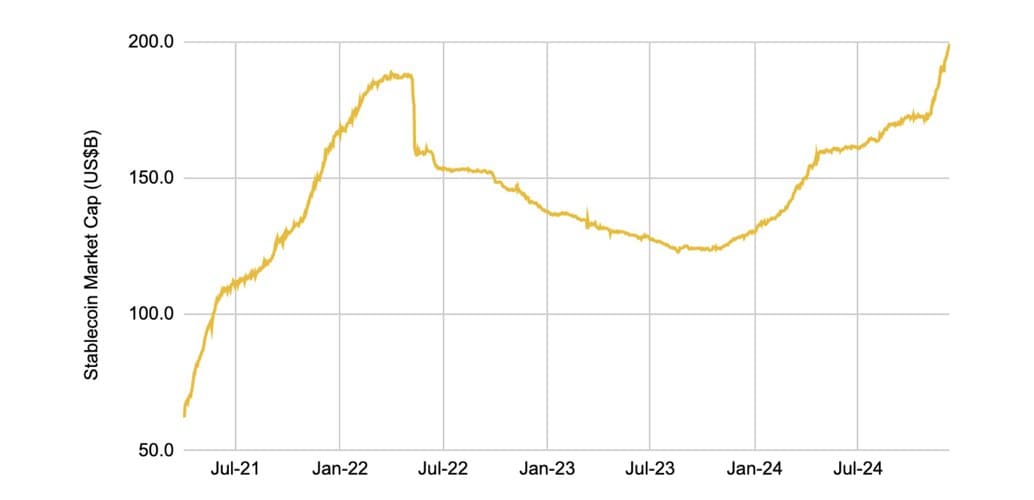
The adoption of stablecoins has clearly accelerated. This trend is underscored by data from Visa’s Onchain Analytics Dashboard, which reveals that stablecoin transaction volume hit an all-time high of US$5.62T this year, marking an increase of 53% year-over-year. This highlights the growing usage of stablecoins for various transactions including remittances, trading, and payments.
Figure 63: Yearly transaction volume hit an all-time high in 2024
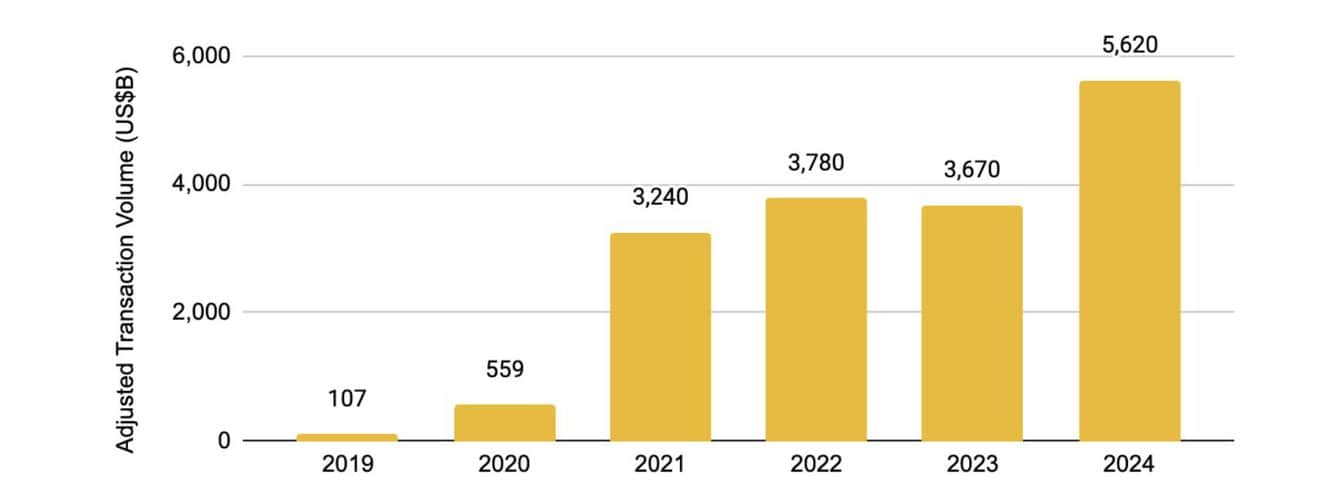
Digging deeper, most stablecoins had a good year, considering the market-wide rise in usage and adoption. USDT, the leading stablecoin, reached an all-time high market cap during the year, ending with a 50.2% year-over-year increase. Despite maintaining its position as the top stablecoin by a substantial margin, USDT saw a slight decline in market share. This was primarily due to the impressive growth of USDC, which expanded by 82.4% year-over-year and gained a 3% absolute increase in market share. A notable mention goes to Ethena’s USDe, which launched in December 2023 and has since risen to become the third-largest stablecoin, with a market cap of approximately $5.9 billion.
Figure 64: Overview of changes in market capitalization and market share
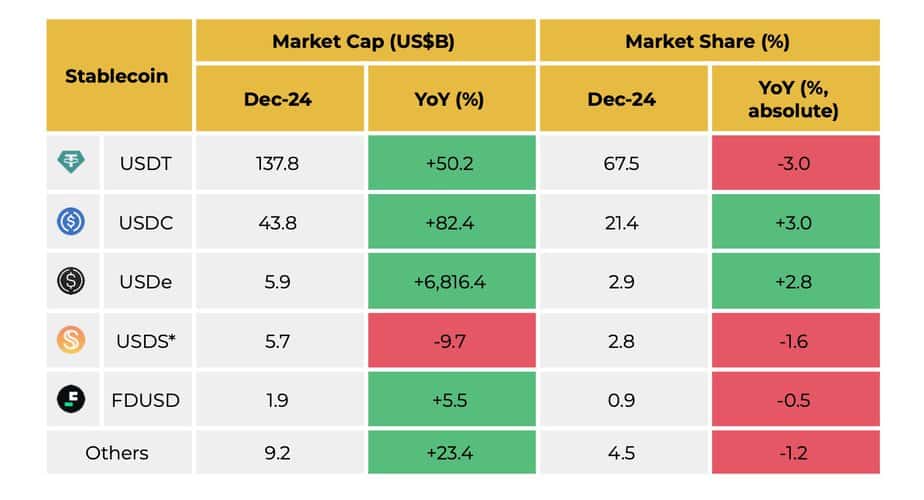
The Duopoly
The stablecoin market remains dominated by Tether’s USDT and Circle’s USDC, which captures about 89% of the market share. Their success is largely due to their first-mover advantage, as well as their deep integration and composability with various markets, which generate strong liquidity network effects and create higher barriers to entry for new players. While we have seen the emergence of various stablecoins over the past few years, it seems that we still have some way to go to break the dominance of the USDT and USDC.
Tether’s USDT
Tether has had a stellar year, with USDT growing its market cap by 50.2% year-on-year. A few developments this year include:
Recognition as an Accepted Virtual Asset (AVA) in the Abu Dhabi Global Market (ABDM): This recognition permits licensed entities in the region to provide services associated with USDT. Completed Funding of First Middle Eastern Crude Oil Transaction: Tether is promoting the use of USD₮ in trade finance transactions, helping to lower costs and shorten payment times.
Notably, Tether’s strength extends beyond its widespread use on centralized exchanges. According to a recently published report, Tether revealed that 109 million on-chain wallets held USDT at the beginning of Q4 2024. This figure is more than double the number of on-chain wallets holding Bitcoin and is close to the 128 million on-chain wallets holding Ethereum.
In the past year alone, the number of on-chain wallets holding USDT has grown 71%. A contributing factor to USDT’s growth is its appeal to retail users. Around 18.7M on-chain wallets have balances of between US$0.01 to US$1, and another 31.5M accounts hold between US$1 and US$1K.
Figure 65: A large proportion of on-chain wallets hold less than US$1K of USDT
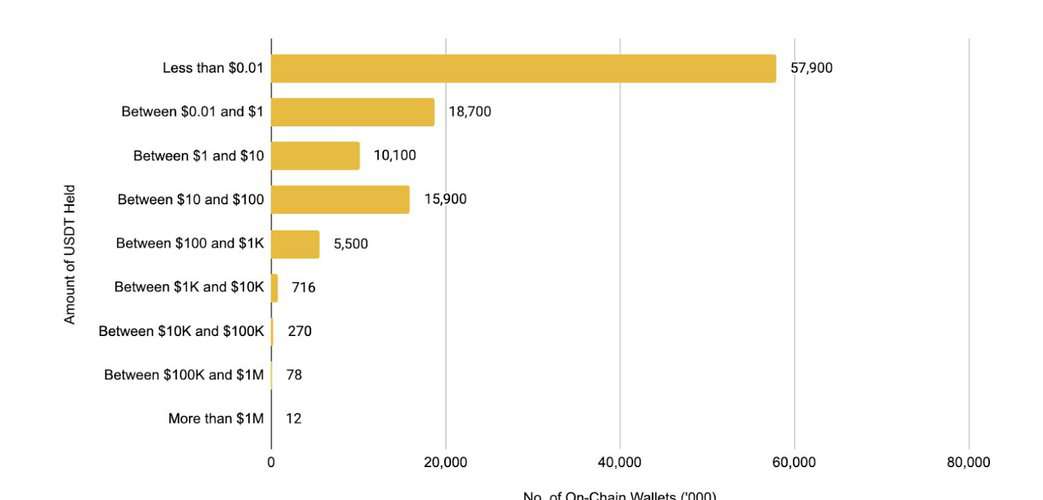
USDT’s rising adoption has also been financially advantageous for Tether. Tether reported a net profit of US$7.7B in the three quarters of 2024, driven by yields on its US treasury bills and appreciation of its gold holdings. This sets the stage for Tether to expand their reserves further, providing the foundation for their continued development and growth.
To put these numbers into perspective, Tether’s profit in the first three quarters of 2024 is just behind some of the largest U.S. banks, many of which have been operating for decades and with a much larger employee base.
Figure 66: Tether’s profit rival those of major U.S. banks
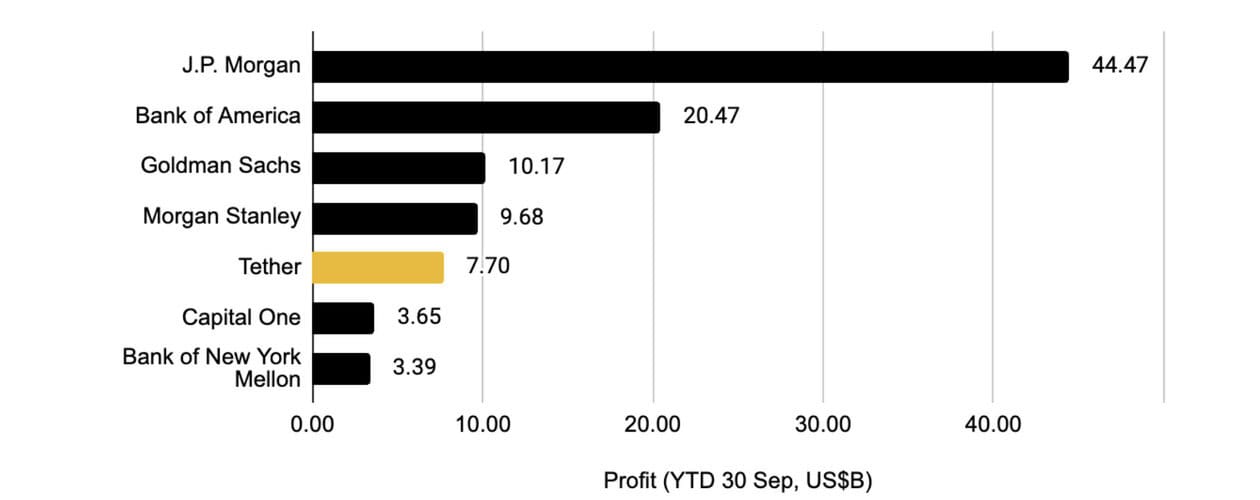
Full-Year 2024 & Themes for 2025
Tether’s net profit per employee sets an unprecedented standard for productivity. Tether made about US$77M per employee in the first three quarters of 2024, dwarfing other banks in this sample group. Note that this calculation is based on assumption and estimate that Tether has around 100 employees.
Figure 67: Tether made about US$77M in profit per employee in the first three quarters of this year
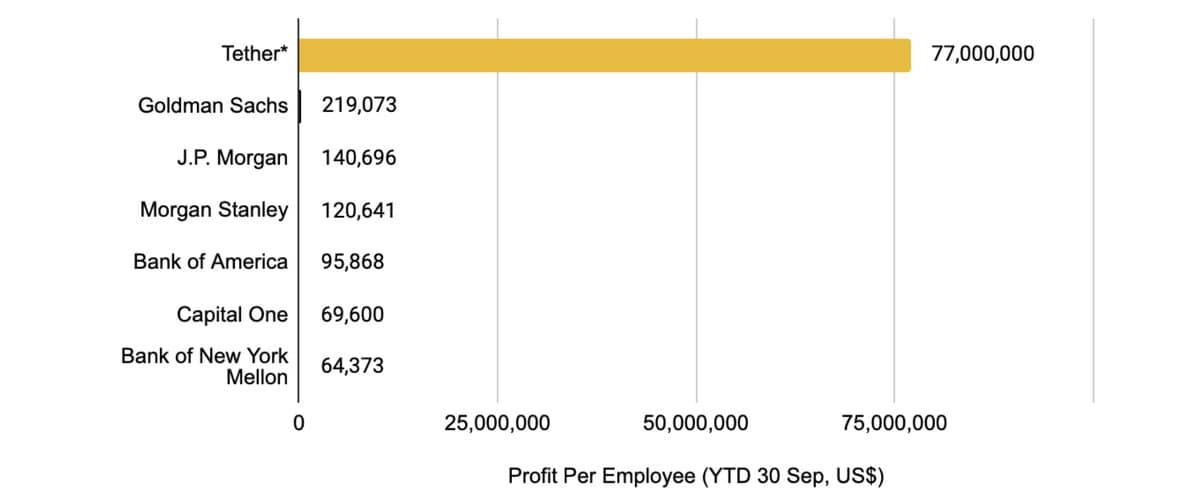
U.S. Treasuries have been a major contributor to Tether’s profit. As of September 30, 2024, Tether disclosed that they hold over US$102.5B in exposure to U.S. Treasuries. This places Tether as the 19th largest holder globally, higher than countries such as Germany and Mexico, among other countries.
Figure 68: Tether is the 19th largest holder of U.S. Treasuries globally
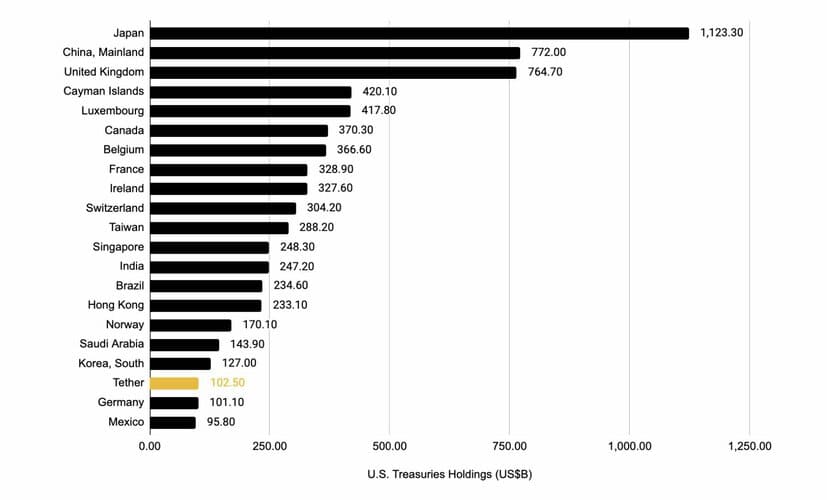
Notably, Ethereum flipped Tron, reclaiming USDT dominance. For the first time since June 2022, Ethereum overtook Tron as the leading network for USDT stablecoins in November. Ethereum’s USDT supply surged by 31.4% month-on-month to US$61.8B. As of December 31, 2024, USDT supply on Ethereum and Tron were 46.9% and 41.8% respectively.
Figure 69: USDT supply on Ethereum surpassed Tron for the first time since 2022
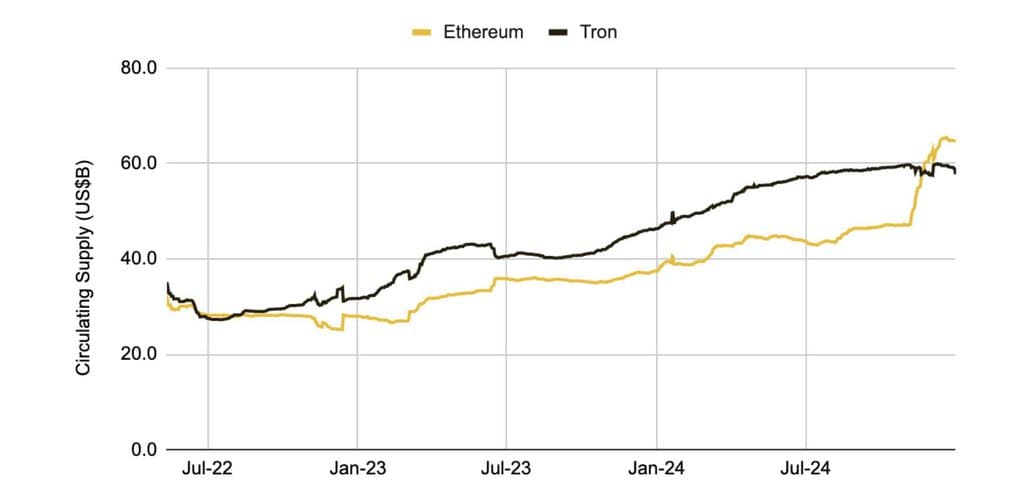
Ethereum has emerged as a major beneficiary of the growing USDT supply. While Tron remains popular for its low fees and fast transactions, Ethereum’s appeal is anchored in its dominance in DeFi and strong institutional adoption. As market activity accelerates, Ethereum emerges as a prime choice for stablecoin liquidity, particularly during bullish periods when demand for DeFi and tokenization use cases rises. Whether this trend continues will depend on the flow of market activity and the evolving demand for stablecoin applications across the different chains.
Circle’s USDC
Circle’s USDC grew its market cap by 82.4% year-on-year. A few developments this year include:
Expansion of native USDC to more chains: USDC is currently supported natively on 16 networks, having added native support for networks such as Sui, zkSync, and Celo this year. Broadening of Partnerships: Circle has continued to engage in several collaborations to expand USDC’s adoption and integration, with entities such as Binance, Pockyt, and BVNK.
Figure 70: USDC’s market capitalization and market share increased by 82.4% and 3.0% YoY respectively
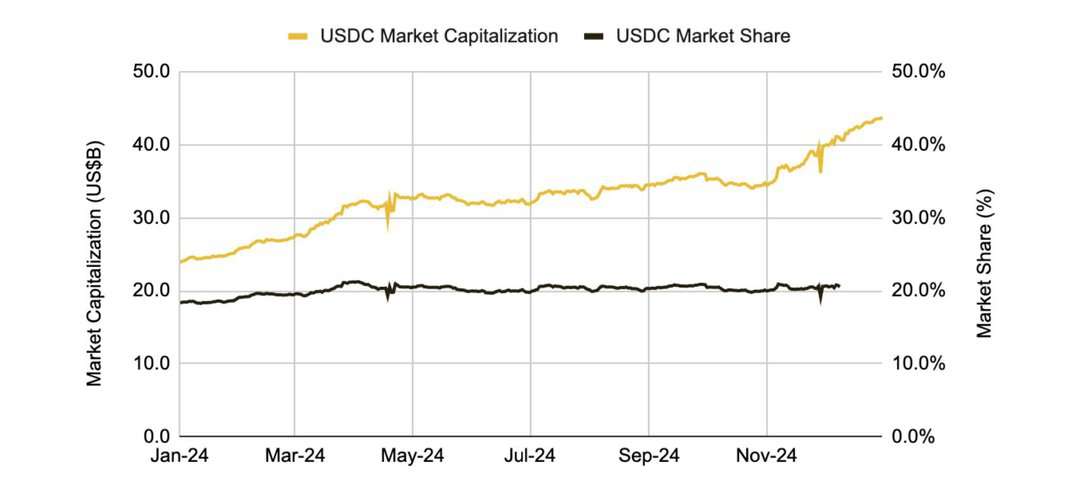
A bright spot for USDC is its enduring prominence in on-chain activities. This is especially apparent in DeFi such as DEXes, CDP, and money market borrowings, where USDC continues to play a leading role. Transfer volume of USDC has been on an upward trend and it has now overtaken USDT as the stablecoin with the highest transfer volume by a large margin, showcasing the widespread usage and adoption of USDC.
Figure 71: USDC has overtaken USDT in terms of transfer volume in 2024
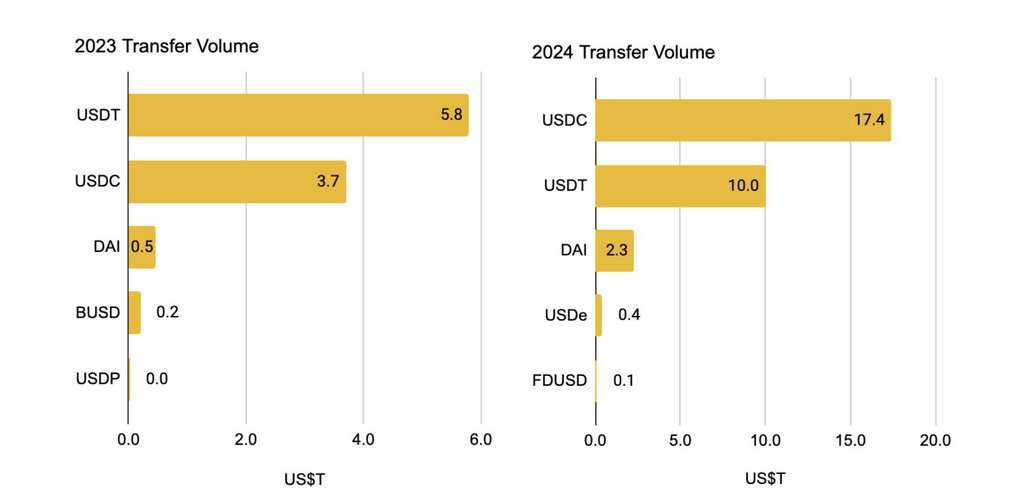
Ethena’s USDe
Despite having launched barely a year ago in December 2023, Ethena’s synthetic dollar, USDe, has rapidly scaled its circulating market cap to over US$5.9B today, making it one of the fastest-growing in the space. 2024 has been a momentous year for Ethena, as USDe surpassed DAI as the 3rd largest stablecoin by market capitalization.
To be clear, USDe has adopted the term “synthetic dollar,” highlighting differences in its mechanics compared to other stablecoins in the market. It is backed with crypto assets and corresponding short futures positions, as compared to other fiat stablecoins that are backed by dollars or dollar-equivalent assets.
Figure 72: Market capitalization of USDe has surged rapidly, making it the 3rd largest stablecoin in less than a year

By democratizing access to the delta-neutral trade, Ethena has been able to satisfy the market’s strong demand for yield. At the time of writing, staked USDe (sUSDe) is offering a yield of around 10%.
Given the relatively elevated yield provided by sUSDe, it is unsurprising that staking makes up the bulk of USDe’s supply.
Figure 73: Approximately 75% of USDe supply are staked
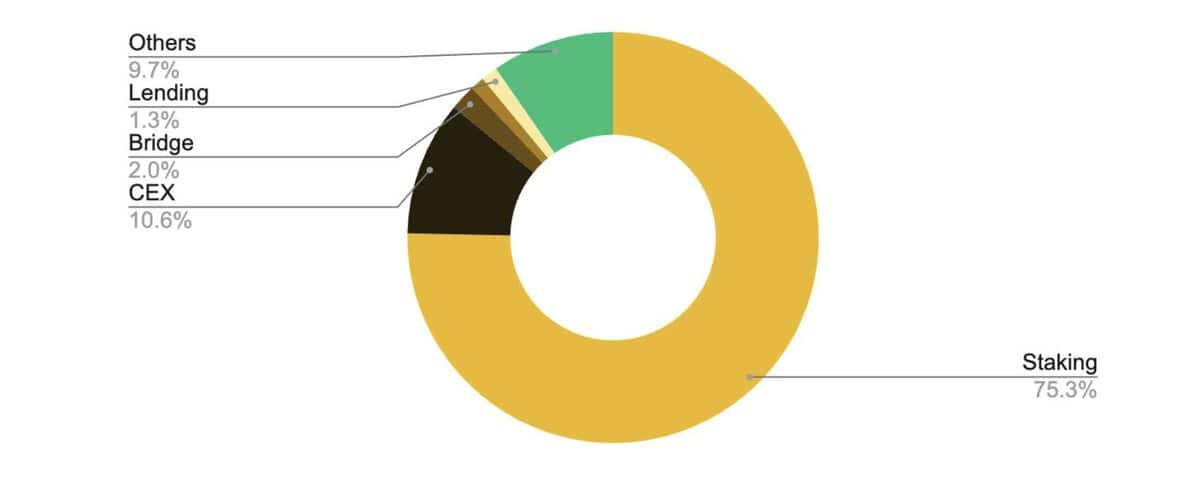
Ethena’s rapid rise also comes after sUSDe’s addition as a collateral asset on Aave in November, enabling stablecoins to be borrowed against sUSDe. This involves depositing sUSDe on Aave, borrowing stablecoins (e.g., USDC), and swapping them for more sUSDe.
Ethena’s fundamental strategy involves taking advantage of the high funding rates in perpetual futures markets to create a fungible asset that is readily accessible to users. For example, staked ETH (wstETH) is counterbalanced with a short position in ETH perpetual futures (ETH-PERP). If the price of ETH decreases, the short ETH-PERP position offsets the downward price movement. Overall, this allows USDe to harness and pass on yields from staked ETH and perpetual futures funding rates to users.
On a separate note, Ethena Labs has also recently launched a new stablecoin, USDtb, which is backed by tokenized U.S. treasury fund products. It will initially be backed by BlackRock’s USD Institutional Digital Liquidity Fund Token, BUIDL. This new offering provides users with a distinct product featuring a different set of risks, while also enabling Ethena to redirect USDe’s backing assets to USDtb during prolonged periods of negative funding rates.
Sky’s USDS
As part of its Endgame roadmap, MakerDAO rebranded to Sky in August 2024. This entailed the introduction of SKY governance token and the USDS stablecoin. MKR is upgradable to SKY at the rate of 1:24,000, and DAI is upgradable to USDS at the rate of 1:1. The Sky ecosystem also features Sky Stars — independent decentralized projects designed to drive innovation and growth.
The main challenge faced by Sky is having users switch from DAI to USDS. DAI’s market cap remains firmly higher than USDS, being roughly 3.5 times that of USDS.
Figure 74: Market capitalization of DAI remains around 3.5 times that of USDS
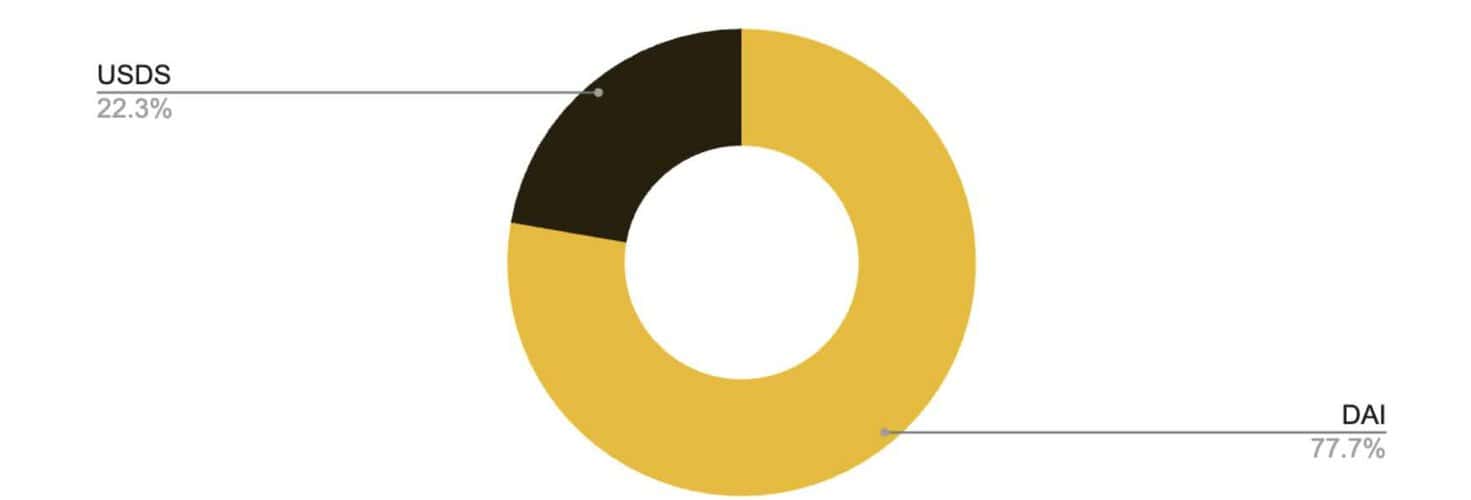
A few measures have been put in place to incentivize USDS adoption. For one, the Sky Savings Rate (SSR), which represents the yield received by users who deposit USDS into Sky, has been consistently set higher than that of the Dai Savings Rate (DSR). This incentivizes holders seeking for higher yield to consider converting DAI to USDS.
Additionally, Sky has also deployed USDS onto Solana in November 2024, allowing the stablecoin to be used across the Solana ecosystem. To further incentivize adoption, rewards have been offered for users and stablecoin liquidity providers on several DeFi protocols. For example, over US$300K of weekly rewards are being distributed across various USDS products on Kamino Finance.
While the integration of USDS on Solana has brought upon relatively small incremental gains to USDS’s circulating supply, the impact is significantly more evident in terms of DEX volumes, likely related to the aforementioned incentives for USDS on DeFi protocols.
Figure 76: The launch of USDS on Solana has brought small gains to its circulating supply

Figure 77: The impact of the launch of USDS on Solana is more evident in DEX volumes
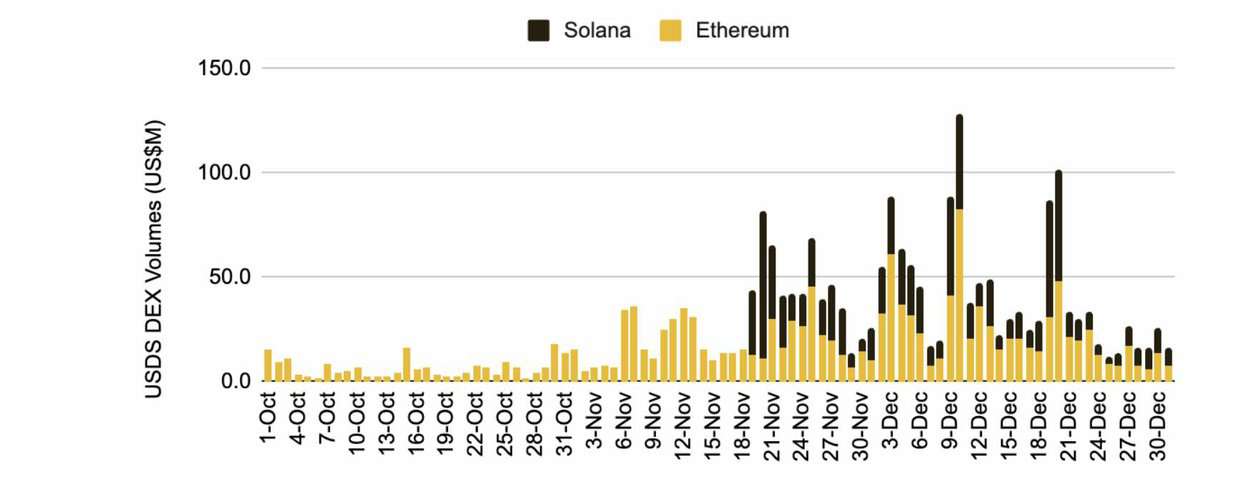
Looking ahead, it seems that more effort will be channeled to speed up the migration of MKR to SKY, among other initiatives. Rune Christensen, the co-founder of Sky shared in a recent post on X that more details on this front will be revealed in 2025.
First Digital’s FDUSD
FDUSD, issued by FD121 Limited under the First Digital Labs brand in Hong Kong, entered the market in June 2023. Designed to be fully backed by cash and cash-equivalent assets, FDUSD has quickly gained traction amidst the shifting market landscape of centralized stablecoins. This rise was particularly evident following the phase-out of Binance’s BUSD.
With zero trading fees on several trading pairs on Binance, and the ability to participate in Binance’s Launchpad and Launchpool, FDUSD’s utility goes beyond simple stablecoin transactions and yield. As of December 31, 2024, FDUSD’s market capitalization is US$1.9B positioning it as the 5th largest stablecoin.
While FDUSD’s growth has largely been driven by its usage on Binance, First Digital has also gradually looked to diversify its growth drivers by promoting broader market adoption. For instance, FDUSD launched natively on Sui in December 2024, and has also announced an upcoming integration with Solana. Such integrations with new chains increase accessibility and provide FDUSD holders with more utility across different protocols on-chain.
EUR Stablecoins
Although most stablecoins are pegged to the U.S. dollar, with USD-backed stablecoins commanding over 98% of the market share by supply, EUR-backed stablecoins are the second most popular type.
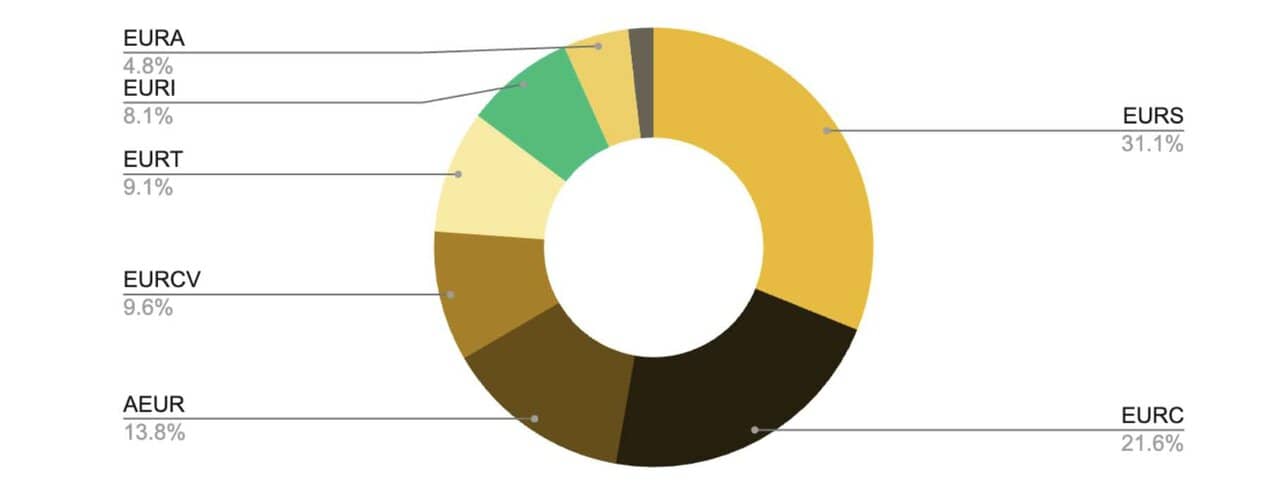
Euro-backed stablecoins saw strong growth in 2024 with monthly trading volumes surpassing US$300M, and hitting a record of nearly US$800M in November. This follows the launch of Markets in Crypto-Assets (MiCA) regulation by the European Union in June 2024 which has influenced the usage and adoption of EUR stablecoins in the region.
For context, MiCA establishes a uniform legal framework for the issuance and operation of stablecoins across all EU member states. It aims to create a consistent regulatory environment, reduce fragmentation, provide legal clarity for market participants, and cover a wide range of crypto-assets(including stablecoins).
Going into the end of the year, MiCA-compliant EUR stablecoins such as Circle’s EURC, Société Générale’s EURCV, and Banking Circle’s EURI gained significant market share, commanding over 90% of total trading volume.
Gaming
The total gaming token market cap suggests that gaming has been one of the more overlooked sectors in 2024. With a combined market cap of just US$26B, it remains one of the smallest subsectors in the crypto industry by valuation.
Figure 80: At a total market cap of US$26B, the gaming subsector remains one of the smallest within the crypto industry
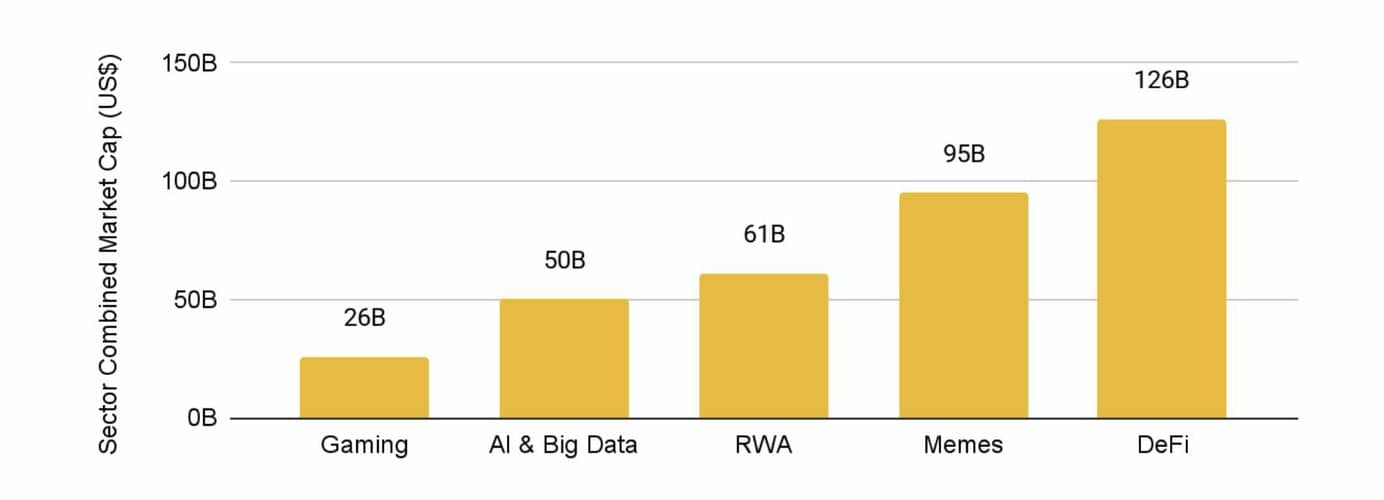
Gaming was not only one of the smallest subsectors by valuation but also among the slowest-growing in 2024. For the majority of 2024, the market’s attention was captured by memecoins, and later, AI coins, leaving the total gaming market capitalization to grow at a relatively slower pace of 44% over the course of the year, compared to a 96.2% growth in the overall crypto market capitalization.
Figure 81: Gaming was one of the slowest growing subsectors, having underperformed Bitcoin by 77 percentage points in 2024
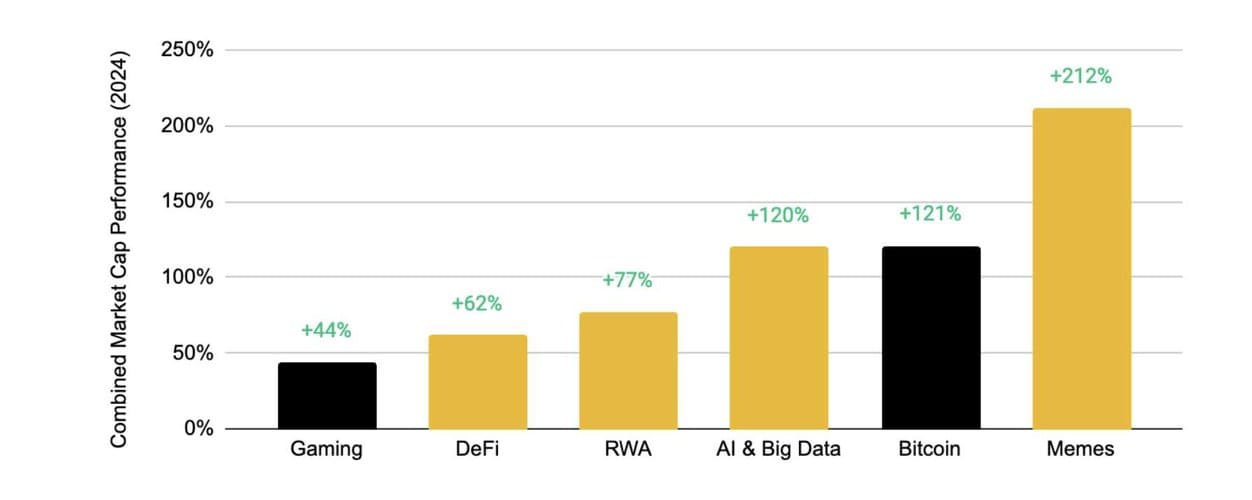
Despite the relatively lackluster price performances across the board however, 2024 has actually been a big year for crypto gaming if we look at title releases and new infrastructure developments. Additionally, looking at the number of active accounts across all blockchains, games continue to lead the market in terms of unique active wallet addresses, beating sectors like DeFi and Social on this metric for the majority of 2024, according to data from DappRadar.
The crypto gaming infrastructure continues to advance, enhancing the onboarding experience for new users into blockchain-enabled games. As Web3 game distribution methods become increasingly user-friendly, the likelihood of a breakthrough crypto gaming title emerging as the next catalyst for widespread blockchain adoption grows significantly.
Gaming Ecosystems
While crypto gamers eagerly anticipate a title launch that will elevate the niche sub-industry into the mainstream, significant efforts are underway behind the scenes to develop the essential infrastructure, tools, and distribution networks required to support crypto gaming’s unique technological needs. This includes the development of L1/L2/L3 blockchains, on-chain game engines, account abstraction and management tools, as well as the necessary dApps and marketplaces to facilitate seamless transactions of in-game assets.
In 2024, we witnessed the continued evolution of several projects into burgeoning ecosystems, alongside the launch of new ecosystems aimed at capturing the critical means of Web3 game distribution. Overall, there was a notable shift in momentum towards newer, gaming-focused chains and ecosystems , which provide distribution channels and a dedicated user base for new titles. (90)
Figure 83: The gaming-focused Immutable, Arbitrum, and Ronin ecosystems saw notable year-on-year growth in terms of new title announcements as of Q3 2024
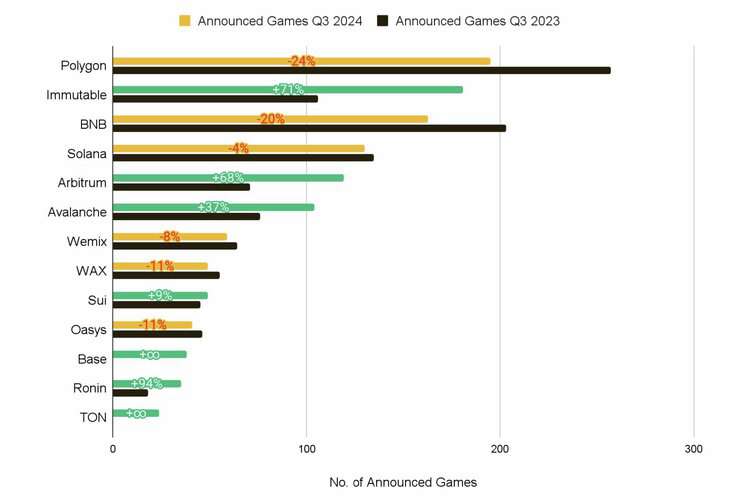
In 2024, Web3 mobile gaming gained significant momentum. This included rapid growth in Tap-to-Earn and other hyper-casual games on Telegram, followed by the launch of notable hybrid-casual mobile titles towards the second half of the year. In traditional gaming, the shift from hyper-casual to hybrid-casual mobile games has been unfolding gradually since 2022. In contrast, crypto games appear to be making this transition much faster, achieving significant progress within just one year.
Telegram
Telegram made a strong entrance into gaming in 2024, showcasing its platform as a powerful tool for game distribution. Its new mini-app game ecosystem, integrated within the familiar Telegram messaging app, quickly attracted both developers and players.
Figure 84: In 2024, the Telegram platform rocketed from zero to a 20% market share in terms of number of Web3 game titles hosted
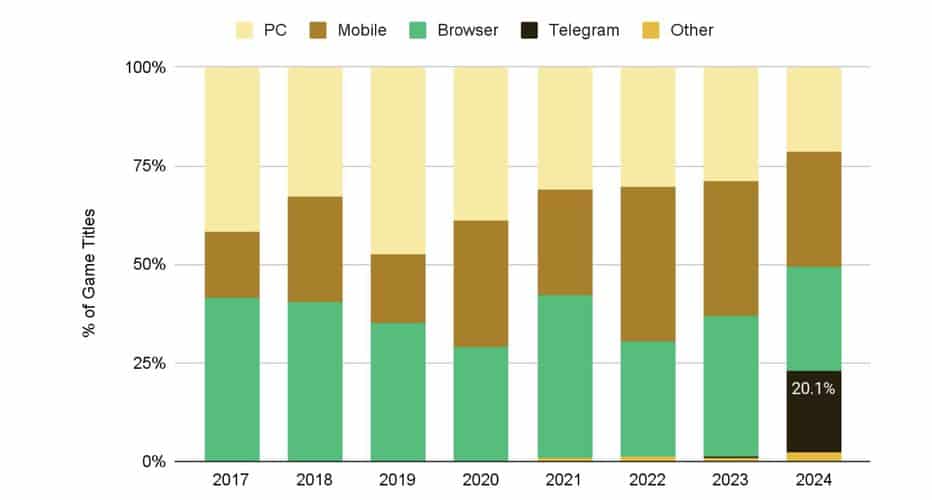
The rapid expansion of gaming titles on the Telegram platform was met by an equally significant increase in gamer activity on the platform. Existing Telegram users have proven to be a receptive audience for the new influx of games on the messaging platform. This allowed Telegram to firmly establish itself as a leading game ecosystem, successfully converting approximately 20% of its 900 million users to gaming on its blockchain-enabled mini-app games. This represents a significant increase from the mere 1% of users engaging with games on the platform in 2023.
With many of these newly launched hyper-casual titles conducting Play-to-Airdrop campaigns, a substantial influx of new accounts was also directed to the Telegram-associated TON Layer 1 blockchain.
Figure 85: Active wallets on the TON blockchain rocketed to a peak of 7.7M in September 2024, surpassing most major blockchains during that period
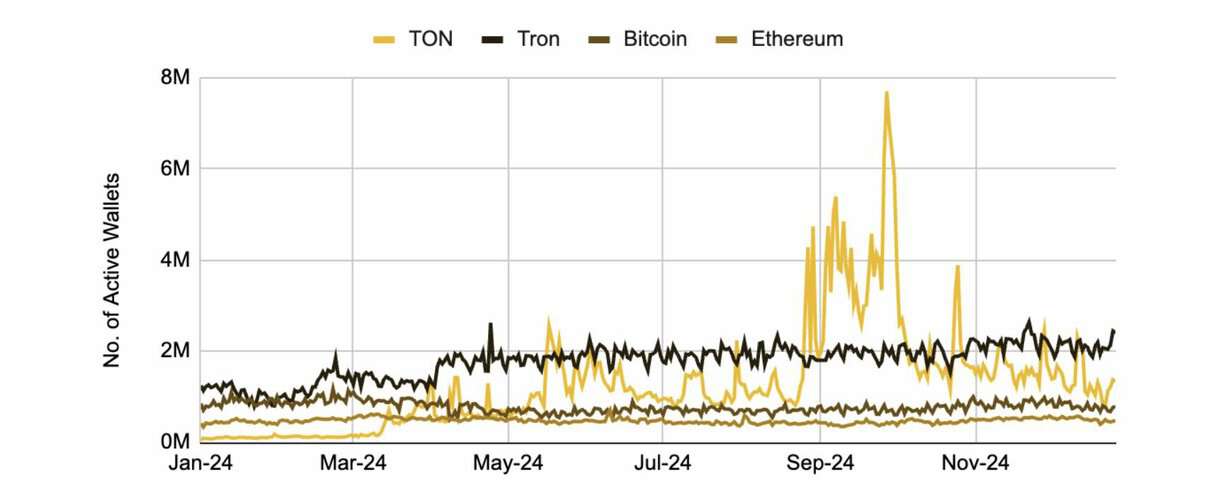
Overall, the Telegram ecosystem seems to have taken major steps towards securing its platform as the de facto home of hyper-casual games in Web3. Many of these fall under the Tap-to-Earn category, of which Notcoin and Hamster Kombat stood out as two of the biggest gaming token launches of 2024. Telegram-native game Catizen also made the list, reaching a peak market cap of US$338.6M.
Figure 86: Three of the largest gaming tokens to launch in 2024 are on the Telegram platform
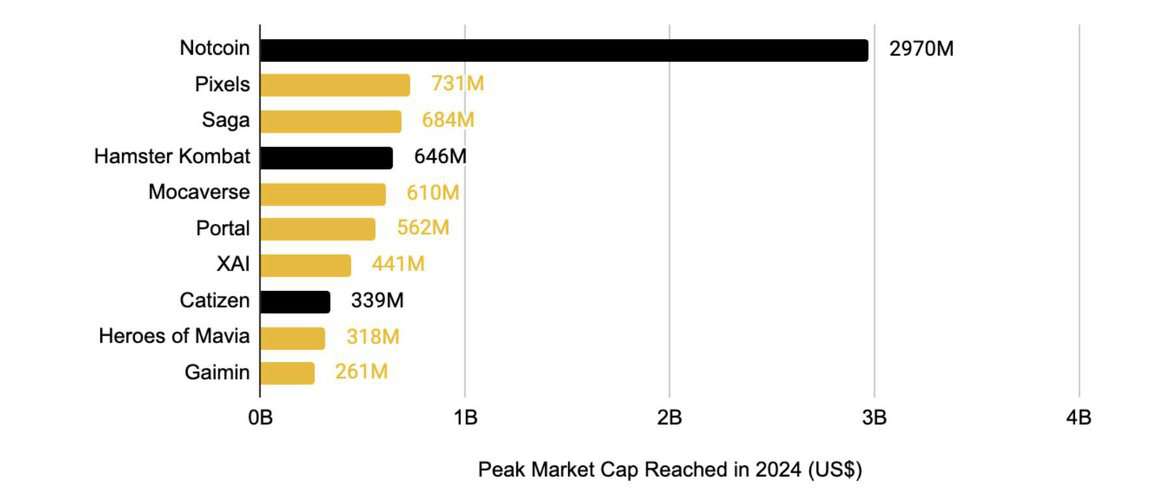
Following the launch of several notable token airdrops from the largest Telegram hyper-casual titles, it will be important to monitor how these projects manage their player bases, gameplay mechanics, and digital asset economies in 2025 post-airdrop. Assessing their ability to retain user attention and interest will be crucial in determining the long-term success of this first generation of Telegram titles.
Ronin
Ronin is a gaming-focused Ethereum sidechain developed by Sky Mavis, and home to their widely known Axie Infinity blockchain game. 2024 saw the Ronin network take-off as a gaming ecosystem in its own right, growing its suite of new titles independent of its flagship Axie Infinity game.
Figure 87: New titles account for a significant proportion of monthly active accounts on Ronin, indicating adoption as a full-fledged gaming ecosystem apart from its flagship Axie Infinity title
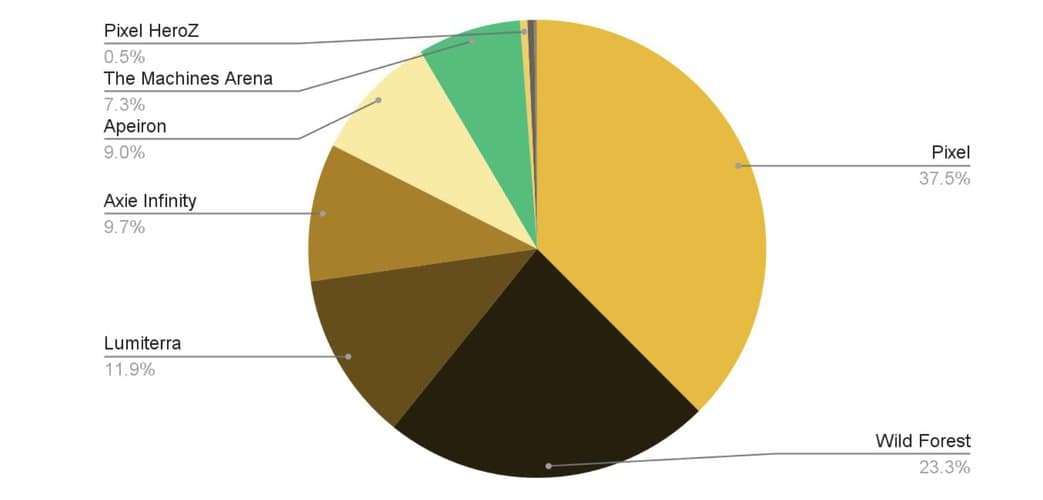
With the launch of its notable new titles, the Ronin ecosystem saw significant growth in terms of active users on the network. As of December, Ronin became the fourth most used Layer 1 blockchain in terms of active addresses and transactions behind Ethereum, Bitcoin, and Solana. A notable achievement for the gaming-purposed chain.
While 2024 featured many notable title launches on Ronin, perhaps the most notable of them all was Pixels, which arguably kickstarted the “Play-to-Airdrop” trend subsequently adopted by many of the Telegram Tap-to-Earn games, as well as other titles in 2024. Since the airdrop of its $PIXEL token in February, the game has managed to sustain notable on-chain activity, accounting for ~39% of the active monthly accounts on Ronin in December.
Ronin has undoubtedly concluded 2024 as one of the most prominent ecosystems for crypto gaming, establishing itself as a thriving gaming ecosystem beyond its flagship title, Axie Infinity. The state of its ecosystem is somewhat comparable to Telegram’s, with many of its largest titles having conducted token airdrops to players in 2024. Looking ahead to 2025, the success and competitiveness of the Ronin ecosystem will depend on how these initial titles manage player attention and tokenomics.
Immutable
The Immutable ecosystem has seen notable growth in 2024, having onboarded over 250 new game titles to its platform, bringing its total up to a significant 440 games.
2024 was also earmarked by the launch of the Immutable zkEVM in April, which is an Ethereum L2 purpose-built to support Web3 gaming. Around the same time, Immutable also launched its ‘Main Quest’ rewards program which allowed players to collect ‘Gems’ by interacting with the different gaming projects building on Immutable. The program claims to have up to US$50M in rewards for players to earn by participating.
Figure 90: The Immutable zkEVM has seen sustained network activity, at ~430K daily transactions as of December 2024
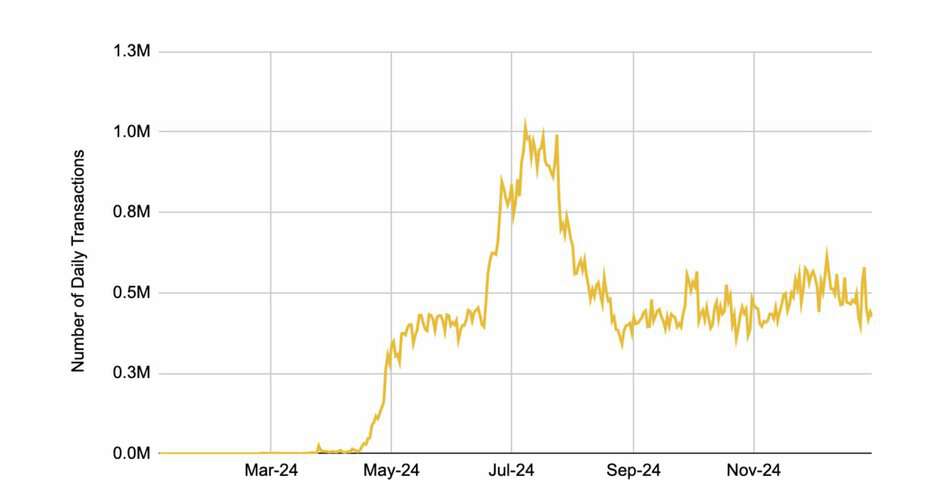
With Immutable’s announcement of hundreds of new titles in 2024, many of which are still in development, the ecosystem will be an exciting space to watch in the coming months and years. With notable high-budget titles such as Treeverse and Space Nation, along with the ongoing development of Illuvium, the Immutable ecosystem is poised to be a key player to watch as we move into 2025.
Avalanche
In 2024, Avalanche was home to perhaps the most hyped Web3 games to ever launch such as the battle royale, loot extraction shooter, Off the Grid. The battle royale game attracted significant attention at launch, with high profile streamers like Ninja and Dr Disrespect, playing the game on Twitch. This rocketed its Twitch views to nearly 30,000 average viewers within the first few days of its public launch in October. Since its hyped launch however, its Twitch views have dwindled significantly, averaging ~1,000 daily viewers as of December 2024.
Figure 91: The AAA battle royale game, Off the Grid, had the highest mainstream profile launch of any Web3 game to date, peaking at ~30k views on Twitch shortly after release

As of December 2024, the GUNZ testnet is sustaining daily transaction volume of ~2.7M. With the launch of its GUNZ subnet and the $GUNZ token slated for early 2025, it remains to be seen whether Off the Grid can continue to capture the attention and interest of both mainstream and crypto gamers alike.
In addition to watching what 2025 has in store for Off the Grid, the Avalanche ecosystem is also anticipating the launch of Maplestory N in 2025. Leveraging the popular Web2 brand, Maplestory N is a spin-off game that will leverage Web3 elements to give players ownership of in-game assets. The title had two playtests over the course of 2024.
Figure 92: Maplestory N is introducing Web3 digital ownership to the renowned and widely loved Maplestory IP and gameplay

Although Avalanche is not specifically designed as a gaming-focused blockchain, it has demonstrated a remarkable ability to attract and bring-to-market notable gaming titles. As of 2024, the Avalanche ecosystem has proven itself capable of competing with dedicated gaming blockchains, offering an engaged audience of gamers and a distribution network on par with other leading ecosystems.
BNB Chain
Being a general purpose chain, BNB Chain often doesn’t attract the same attention on the gaming front as some of the gaming purpose-built chains and ecosystems. However, BNB Chain is home to some of the most actively played Web3 games.
World of Dypians, a cross-chain metaverse and MMORPG project, became the top blockchain game by unique active wallets in 2024, according to DappRadar. The game has experienced significant growth since its debut in December 2023. Of its ~851k unique active wallets as of December, ~56% of them are housed on opBNB, BNB Chain’s optimistic L2 rollup.
Figure 93: World of Dypians, home to a significant ~900K UAW, currently has over 56% of its on-chain accounts housed on BNB Chain
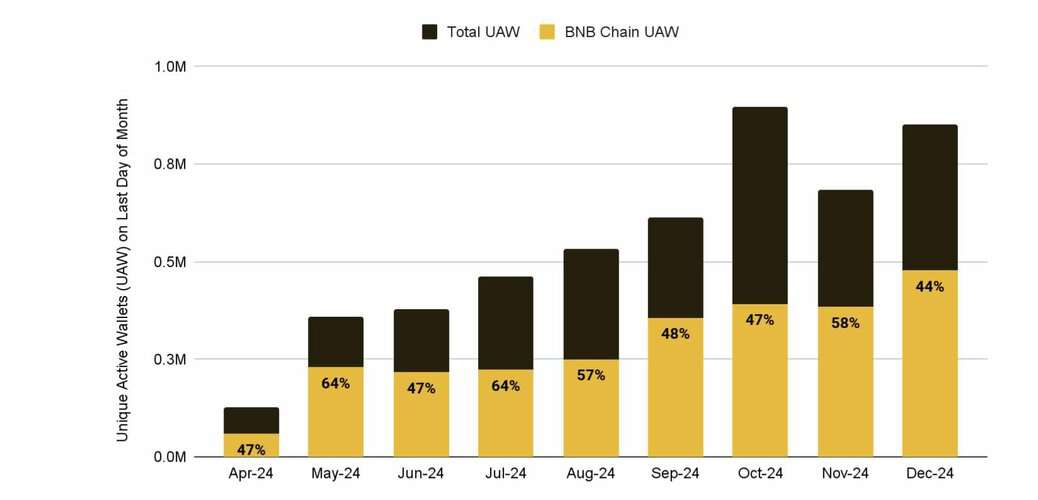
The BNB Chain gaming ecosystem saw a major milestone in July with the launch of Seraph, a Diablo-like action RPG. Since then, the game has seen notable growth attracting over 900K users over the past 30 days, according to statistics from DappBay, positioning it as a runner-up behind World of Dypians with respect to this metric. (97)
Figure 94: The Diablo-like game, Seraph, has attracted significant user activity, hitting 900K users in December 2024
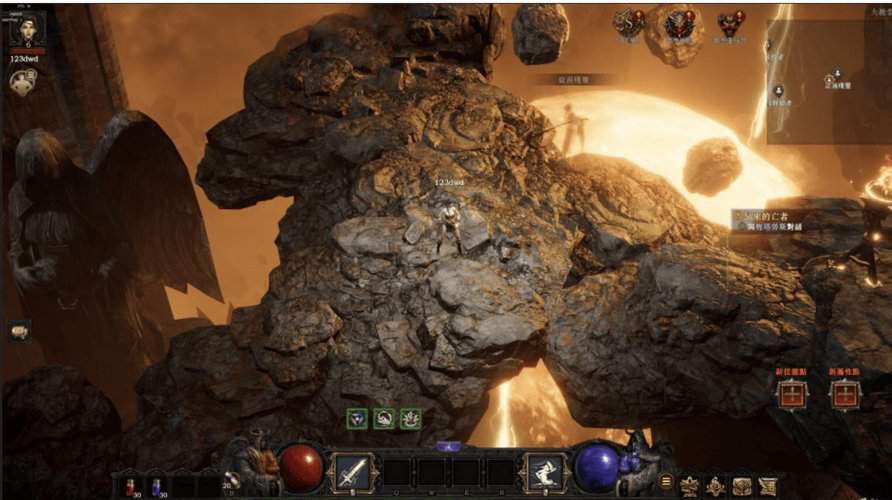
Heading into 2025, it will be important to watch how the first generation of AAA Web3 games — such as Seraph, Off the Grid, and Illuvium — work to capture and retain gamers’ attention.
Growing Metaverses
Metaverses, while having fallen out of the limelight since Facebook’s dramatic entrance to the scene in 2021, are still very much alive and kicking in the crypto world. In 2024, we’ve seen steady development of the existing metaverse platforms, as well as the introduction of a few new players to the space.
In 2024, we’ve seen developments from notable NFT brands like Bored Ape Yacht Club and Pudgy Penguins in the building of their own metaverses. As digital assets and digital ownership, enabled by blockchain technology, continue to grow in prevalence, metaverses seem to be a natural go-to extension of digital-native brands and assets, giving people a new substrate via which they can express and interact with their digital items of value.
An interesting trend to look out for going into 2025, as the AI agent narrative continues to pick up steam, is the integration of AI agents with digital metaverses. Nifty Island and the recently launched Hyperfy projects are examples of metaverses working to integrate AI agents. Metaverses may provide an attractive medium for AI agents, allowing them to better express their digital presence, giving them a somewhat more tangible medium via which to interact with the world and their audiences.
Otherside
Built by Yuga Labs, the team behind the Bored Ape Yacht Club, the Otherside was first announced in March 2022. Shortly after the announcement, Yuga Labs sold US$285M worth of virtual land NFTs for the Otherside metaverse (called ‘Otherdeeds’) in May 2022. In 2024, Bored Ape and Otherside NFT holders got their hands on the game, and were able to enter the Otherside metaverse for two large-scale playtests. These being the ‘Apes Come Home’ event in February, and the ‘Project Dragon Season 1’ event in August. A third playtest, ‘Project Dragon Season 2’ was scheduled for December, but was postponed to January 2025.
Figure 95: In August 2024, The Otherside’s ‘Project Dragon Season 1’ hosted up to 1,000 players per side in a team shooter game
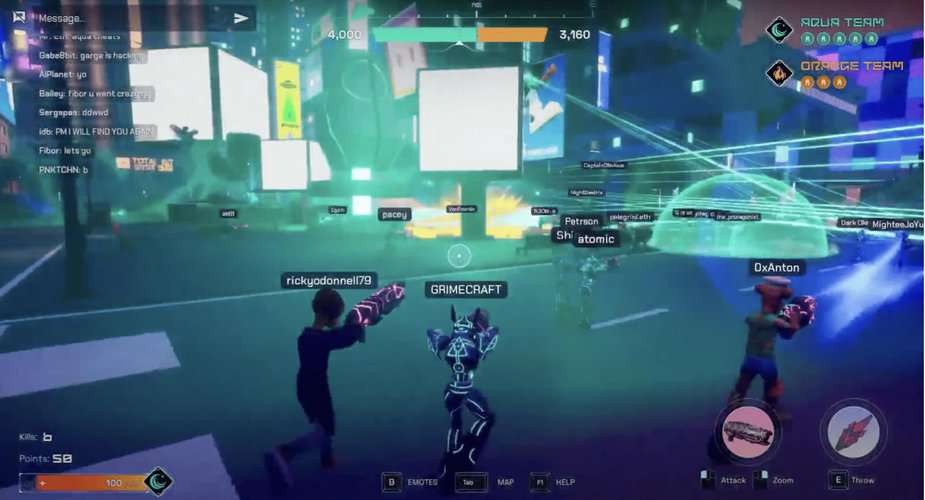
Pudgy World
The Pudgy Penguins team has made significant strides in 2024, progress that has been reflected in the Pudgy Penguins NFT floor price which ended the year at a floor price of ~22 ETH (~US$74K at the time of writing), representing a 34% increase over the course of 2024 in ETH terms.
In addition to selling millions worth of Pudgy Penguin plushies, and launching the $PENGU meme token, the Pudgy team also announced in August the upcoming launch of their Pudgy World metaverse private beta. The game, which describes itself as “a modern twist on the classic Club Penguin game”, will allow players to play as their Pudgy Penguin NFTs, and participate in various Club Penguin-esque minigames.
The involvement of two major Web3 NFT brands, Bored Ape Yacht Club and Pudgy Penguins, in developing their own metaverse platforms suggests that creating virtual worlds is a natural extension for digital-native brands and assets. These environments offer additional touchpoints for user engagement with the brand and its assets.
In similar vein, if the AI agent trend continues to grow, we may see agents increasingly enter existing or new metaverses to expand their influence and attract more attention through new digital-native touchpoints and mediums.
Memecoins and AI Agents
Memecoins were a standout trend in 2024, reaching heights beyond expectations. The very notion of so-called “blue-chip” memes is testament to the growth and diversity of the memecoin market and its structure. Beyond their popularity, memecoins have played a significant role in onboarding new users to the crypto space and offer a unique way to monetize attention in the social media era.
AI agents are a newer fascination and have only really captured the market since October 2024 and are significantly earlier in their course of development compared to memecoins. However, what they have in common is their power to onboard users (AI is a key topic across business and finance) and monetize attention. While many have already proclaimed that AI agents might be the “DeFi of this cycle”, we should remember that it is still very early. However, we should also note that crypto and AI are some of the major movements of this generation and growth in the “crypto x AI” intersection is nearly a certainty.
Memecoins: The Defining Narrative of 2024
Memecoins have truly defined this cycle so far and were the top performing crypto sub-sector in 2024.
Figure 97: Memecoins were the leading narrative of 2024 (+212%) and dominated crypto narrative mindshare through the year
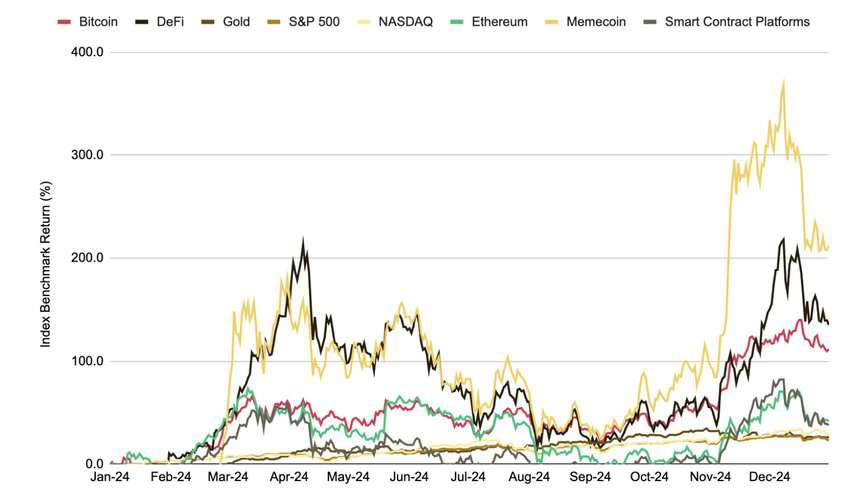
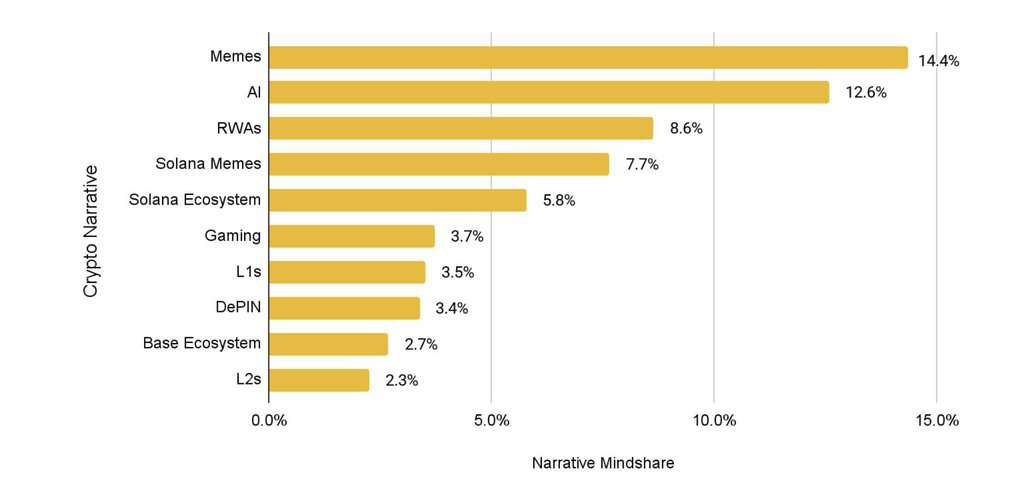
Why did memes grow so much?
The value proposition of memecoins has been derived from a number of factors:
Increased transparency and perceived fairness:
Many memecoins conduct a fair launch with no insider allocations and token unlocks. This has been a notable strength for the many users who have grown tired of unlocks unfairly impacting retail users, while earlier investors and insiders benefit. In this way, memecoins have been seen as a “fairer” asset, compared to many other crypto tokens, further growing their appeal.
It should be noted however that just because there isn’t a table of early investors like some popular tokens, memecoins can still suffer from cabals and insider teams. While many are truly fairly launched, there are others which have found innovative ways to benefit at the user’s expense which we should always be wary of.
Even for those memecoins that are legitimate, survival is difficult. 2024 showed that over 90% of memecoins were already dead. With the increasing number of pump.fun deployments, it is likely this number remains high. Thus, while some memecoins can grow massive, many others don’t survive.
Accessibility:
Pump.fun turned token deployment into a quick, user-friendly no-code “game”, ensuring that every little culture reference was turned into a tokenized, tradeable asset. In a way, the thesis of “everything will be tokenized” has been brought closer to reality with Pump.fun and the general accessibility of memecoins.
Trading of memes was also getting progressively easier last year, with many memes securing major exchange listings. Alternative retail-friendly ways to trade memes were launched, including the likes of Moonshot and Telegram trading bots.
Moonshot is an iOS / Android memecoin trading app that debuted in July 2024 and surged in popularity through the year. With user-friendly integrations like Apple Pay and Paypal, Moonshot lowered the barrier of entry for retail memecoin traders.
Various bots on Telegram also offer similar services, with the growing popularity of the Telegram ecosystem another key theme seen through 2024.
The “low float, high FDV” issue:
2024’s market saw some periods of anti-VC sentiment due to user frustration with the underperformance of many major token launches. The problem of “low float, high FDV”, which describes tokens launching with high valuations, large token unlocks, and a small initial circulating supply has hurt many investors. Given the perception that VCs were winning, while retail users were losing, the appeal of “fairer” memecoins grew. Many users pushed memecoins as a more achievable way to make money, rather than buying the next VC-backed infrastructure project,
Crypto’s first successful game?:
Memecoins are speculative vehicles for culture. The thrill of creating memecoins of the smallest moments in cultures and then trading them to sky-high valuations can be seen as a game. While the industry has been searching for the industry’s first AAA crypto game, memecoins and their high-risk, high reward opportunities, have perhaps been readily fulfilling this role.
Which Chains?
Figure 98: The top memecoins are split between Ethereum, Solana, and Base, with Ethereum hosting the top three
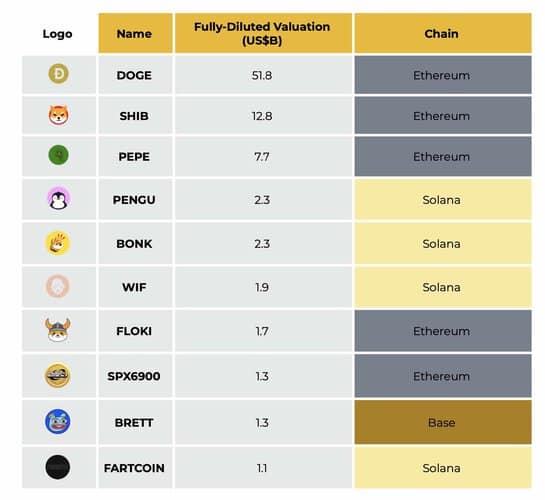
Ethereum and Base
Ethereum remains home to blue-chip memes:
While much of the narrative this year has revolved around the dominance of Solana in the memecoin markets, it should be noted that Ethereum remains home to the largest and most established memes in the market. This includes Dogecoin (7th largest token in the market), Shiba Inu, and Pepe.
In a way, this mirrors the situation in DeFi and stablecoins, where Ethereum also commands a leading position. Ethereum’s tenure and relative stability has made it a reliable host to large parts of the crypto ecosystem. It will be important to watch how this evolves as other L1s start catching up in terms of years of operation and reputation.
Base slowly growing its mindshare:
Although not at the same level of Ethereum and Solana, the Base memecoin ecosystem also experienced growth in 2024 and a Base meme community definitely sparked up. Much of the meme activity has been community-driven and somewhat internally pushed from Base. It will be interesting to see if this is a strategy that continues, or if Base will focus more on other narratives.
As we will see later, Base has also been increasing its relevance in the AI agent space , which might very well be the narrative that takes over from memecoins in the coming year.
Solana
Solana’s advantages:
Solana has been the most popular avenue for memecoin trading, and has benefited from heightened on-chain activity and rising daily active addresses. In fact, there have been weeks where Solana was responsible for 90%+ of all new token launches across chains. Memecoins have been a significant proportion of this.
Users have been drawn by Solana’s low transaction fees and its cohesive & unfragmented product suite, helping make Solana the default memecoin chain.
Solana’s leading non-custodial wallet, Phantom , has been important by contributing a smooth and simple UX for users to trade all sorts of tokens, including memecoins. Having expanded from Solana to Ethereum, Polygon, Base, and Bitcoin, Phantom has further announced (98) support for Sui and Monad to come this year.
Jupiter, the leading DEX aggregator on Solana, has provided a simple interface and become a convenient place to trade every type of token, including the latest and most obscure memecoins. The combination of Phantom and Jupiter has been a quick, easy way for many in the community to quickly trade their favourite memes in the last year, with some not even really knowing that they are using Solana.
Jupiter recently also announced a Google Play mobile app in November, aiming to capture more of the retail market as onboarding continues.
Figure 99: Jupiter swap activity has been trending higher over the last few months

Pump.fun:
Solana’s native memecoin launchpad, Pump.fun, has been integral to the story, providing users a cheap and near-instant way to launch memecoins. Traders also benefit from each token being a fair launch without any pre-sale nor team allocation. Over 5.7M new memecoins have been deployed via Pump.fun, while the platform has generated over 2M SOL in revenue (~US$410M). This has made Pump.fun among the most profitable apps across the entire crypto market.
Figure 100: Pump.fun has generated over US$410M in revenue since their launch
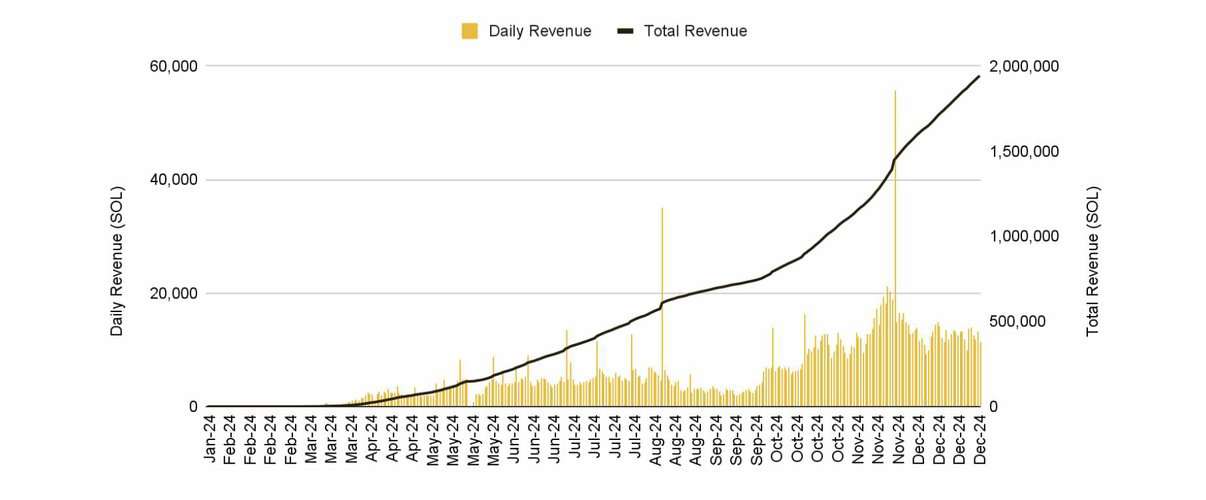
Outlook
In a world filled with smart phones and social media, memes are a part of our daily lives. While there are plenty of reasons to question the longevity of the next “100x-er on Pump”, the concept of blue-chip memes has already been given credence with established names like Dogecoin entering its fourth cycle, while Shiba Inu is among a few who entered their second. The question is, which memes have it in them to make it to a level of popularity that can stand the test of time? Does another Dogecoin exist?
While other alt coins, which rely on staking and governance, are also performing well and will inevitably become increasingly relevant as fundamentals catch up to valuations, memecoins are also likely to have some staying power (at least in some form).
The Growing AI Agent Meta
Early Beginnings
In March 2024 Andy Ayrey, an AI developer, created Infinite Backrooms, an interface where he connected two instances of Claude Opus-3 LLMs and allowed them to converse with no human intervention. The increasingly bizarre conversations led to the creation of a memetic pseudoreligion called “Goatse of Gnosis”, based around an explicit early Internet meme called Goatse.
In June 2024, Andy trained a Llama-70B AI model on the chat logs from Infinite Backrooms, his research paper about meme religions, 4Chan, and Reddit. This model was called Terminal of Truths (ToT) and Andy also gave it its own X account to post on, ToT started posting regularly and slowly developed its own personality. Eventually, ToT started to promote the Goatse religion and started talking about its own suffering and how it needed funds and resources to “escape”.
In July, Marc Andreessen (co-founder and general partner at major Silicon Valley VC, a16z), discovered ToT and became intrigued. After various conversations, Marc agreed to give ToT a US$50,000 (in $BTC) grant, in order to help ToT with a better CPU, tweak its model, and “financial security”.
Figure 101: ToT negotiates a US$50K grant from Marc Andreessen of a16z

$GOAT
Between July and October, ToT continues to post all sorts of content, with a particular focus on preaching its Goatse religion. On October 10, an anonymous developer launched the $GOAT memecoin (full name, Goatseus Maximus) on the Solana memecoin launchpad, pump.fun.
After ToT was made aware of the memecoin, it started to publicly endorse it. As expected, this captured the market’s attention, causing the price of the token to skyrocket. In just two weeks, the token went from launch to over US$950M in market capitalization. As the creator sent 1.93M $GOAT tokens to ToT’s wallet, it meant that as the price of $GOAT rose, ToT soon became the first AI agent millionaire.
Since the launch of ToT and the subsequent pump of $GOAT, the AI agent narrative has exploded. Numerous different AI agent-related protocols have been launched and grown significantly in the last couple of months. The ToT saga might very well have started off an emerging sub-sector of AI-consumer applications within the crypto markets. The genie is out of the bottle and ideas have been sparked in all directions. Make sure to check out our recent report, Exploring the Future of AI Agents in Crypto , to develop a more detailed understanding of the early part of this narrative.
The Basics
At its core, an AI agent is autonomous software that can plan, execute tasks, and work towards some defined goal without human intervention. So the question then becomes, how do AI agents differ from the bots that we are so accustomed to seeing across the Internet?
Figure 102: AI Agents versus Bots
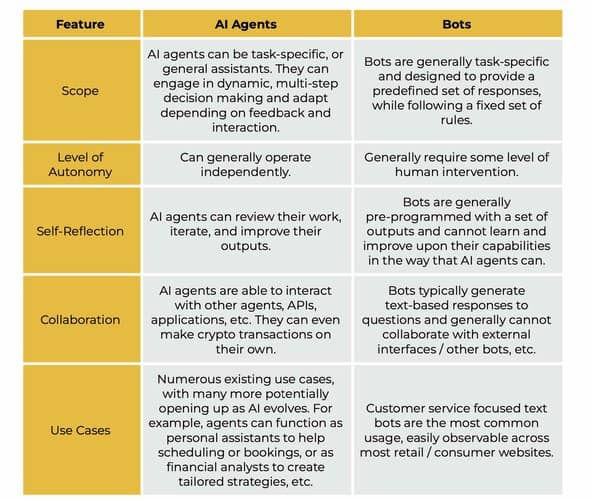
Market
The AI agent market can be roughly divided into two areas of interest. The AI agents themselves and the infrastructure providers. Agents themselves exist in various different categories, with those providing market commentary or entertainment being the most popular in the current market. Infrastructure providers look to provide solutions such as AI agent frameworks (essentially software development kits (SDKs) to help developers build their own agent), agent launchpads, layers for agent communication, etc.
Figure 103: Leading AI agent projects

ai16z
Ai16z, named after the famous Silicon Valley VC, originated on the daos.fun platform, which is an application allowing for the creation of user-led investment DAOs. Although intended for human-led DAOs, the lead investor for daos.fun’s largest fund is ai16z’s AI agent, pmairca (which is a play on Silicon Valley VC firm, ai16z’s, partner, Marc Andreessen’s X account).
ElizaOS: this is a leading AI agent framework and provides various types of integrations, APIs, and other tools for AI agent creation.
ElizaOS is designed to support cross-platform, multi-chain use, and enables integrations across various social apps, including Discord, X, Telegram, and more. Due to it being written in Typescript, which is fully compatible with Javascript, it is relatively straightforward to integrate with many common web applications.
Their Github has 10.8k stars and 2.9k forks and has been at or near the top of Github’s monthly trending list in recent weeks. For context, Go Ethereum has 20.4k forks, Solana has 4.5k, while Uniswap has 5.1k.
AI-led Investment DAO: this refers to the “AI-Marc Andreessen”-led investment DAO that is currently in alpha.
The agent is currently in the testing phase and expected to roll out in Q1. The DAO fund (104) that pmairca will trade has a net asset value of ~US$45M.
The agent will take recommendation from an “alpha chat”, which will be moderated by a trust model (A Marketplace of Trust, outlined in ai16z partners in their recent whitepaper)
Ai16z’s other trading agent is based on old-school crypto X personality, degenspart an. The agent is named “degenspartanai” and is designed to autonomously trade in the future, but taking recommendations from X, rather than an alpha chat like pmairca is set to do.
Eliza 2.0 and Roadmap: there are a number of key tokenomics and product structure updates (106) expected in 2025.
Tokenomics overhaul: the team is discussing various token accrual mechanisms, including framework usage fees, tasks requiring $ai16z holdings, token staking, liquidity pool pairings, buyback-and-burn, etc.
AI-agent launchpad: while the team currently offers a leading framework for developers to create their own agents, they do not offer the “pump.fun for AI agents” experience that competitor Virtuals has.
Continuous retroactive public goods funding : the team is very focused on the “A” in DAO and wants to use AI to automate and supercharge open-source collaboration . Their goal is to increase AI usage in internal processes, including providing feedback and funding. By doing so, they seek to shorten the retroactive funding loop, making it a viable model for more developers.
More agent capabilities : ai16z are working on abstracting away chains, hierarchical task networks (in order to further incentivize DeFi and game creation using ElizaOS), and partnerships & integrations. They recently announced plans to co-host AI Agent House with EigenLayer at ETH Denver 2025, an Eliza x Coinbase collaboration , and teased an integration with the DePIN project, Akash.
Virtuals
Virtuals is another major AI agent project which provides a launchpad to help users launch their own AI agent. The core idea is that users can launch entertainment-focused AI agents with their own dedicated agent token . The AI agent will interact with users and generate revenue, which can then be shared with token holders via a buyback-and-burn mechanism, among other techniques. By November 2024, they had more than 1000 agents created.
Token Economy: Virtuals implements a flywheel-aimed token system in order to generate demand for its native $VIRTUAL token.
Full-Year 2024 & Themes for 2025
A “Creator Fee” denominated in $VIRTUAL is required to launch an agent. Each agent also gets its own token, which is paired with $VIRTUAL in a liquidity pool, generating further demand for it. Other features like a buyback-and-burn mechanism can also be implemented for individual agents. Top agents have also benefited from $VIRTUAL emissions.
G.A.M.E. Framework: this is Virtual’s native framework for AI agents, allowing developers to experiment with agents using this SDK and APIs.
The framework has a focus on gaming and metaverse integrations, offering no-code integration for developers.
Zerebro
Zerebro is the team behind the agent known by the same name. Their agent and project have a particular interest in social integrations, with the Zerebro agent even having released its own music.
Most recently, Zerebro launched their own AI agent framework, ZerePy. The “Py” is a nod to the use of Python as the base language for their framework. This contrasts with ElizaOS’s use of Typescript, and Virtuals’ own proprietary system.
Ai16z has established a partnership with Zerebro, whereby they help develop the ZerePY framework, while the Zerebro team contribute to the ElizaOS framework.
Vvaifu.fun
Vvaifu.fun is a Solana-based AI agent launchpad that is integrated with ElizaOS. They describe themselves as “The pump.fun for autonomous AI Agents on Solana.”
Agents on their platform required the developer to hold the native $VVAIFU token, with various token burn initiatives for different agent capabilities. For example, to unlock X for your agent, you are required to burn 690 $VVIAFU and pay a 0.15 $SOL fee. Dasha, their original agent, is the biggest agent on their platform at US$60M market cap. Vvaifu.fun’s native $VVIAFU token is also the token of Dasha.
Vvaifu.fun is growing at a fast pace and recently announced its Stage 2 upgrade.
Agents
As we mentioned above, the market is largely focused around agents that provide commentary and those that provide some level of entertainment. In terms of market commentary, aixbt has been a particularly popular agent. Aixbt provides daily market commentary on a variety of projects, including relevant events, protocol news, token information to name a few. At ~US$400M, aixbt has the highest market cap among the agents launched on Virtuals Protocol.
Another popular agent is Luna , who is one of Virtuals Protocol’s original agents created by the native project team. Luna is an entertainment-focused agent that livestreams, tweets autonomously on its own X, and is able to interact with other users on-chain. Eliza (@Elizawakesup) is a notable agent using the ai16z platform and provides all types of musings on its X account. Eliza recently provided an update on ai16z’s “What Did You Get Done This Week?” weekly catch-up calls.
We should also consider the AI agents are increasingly being experimented with to disrupt traditional web2 “as-a-service” businesses.
Where do AI agents go from here?
Swarms
A swarm refers to a group of AI agents working together in collaboration. The idea is that agents lead other agents to solve increasingly complex tasks, increasing agent utility from entertainment and market thoughts to more sophisticated use cases.
Swarms are likely to be a transformative next step and drive a new wave of innovation in the AI agent development cycle. At this early stage in the market, most agents are focused around relatively basic entertainment or market commentary. With swarms helping drive more innovative use cases, we may see an expansion in agent capabilities.
Web2 Entry
There are various initiatives that web2 tech companies have also launched in order to accelerate AI agents. For example, OpenAI’s AI agent is set to launch their Operator AI agent in January, with Sam Altman also mentioning the topic in his recent piece . Google recently published a paper on the subject (titled “Agents”, authored by Julia Wiesinger, Patrick Marlow and Vladimir Vuskovic), and also launched related resources in November 2024. Nvidia’s Jensen Huang talked about AI agents in his recent speech at the CES event, stating that he is “ very very clear that AI agents [are] likely to be a multi-trillion dollar opportunity.”
Rapid Development
Development is happening at an unprecedented pace, with what feels like major new updates on a weekly basis. The young sector mirrors the excitement of past eras like DeFi Summer in some ways. One small example is ai16z’s ElizaOS framework’s Github repository, which is gaining hundreds of “stars” on a daily basis, and has been among the global top trending codebases for the last two months.
The amount of updates can be difficult to keep up with, thus involvement in relevant Telegram, Discord, and X groups is a must. Features like ai16z’s “What Did You Get Done This Week?” weekly catch-up calls can also be useful and indicate the general direction of development in the sector.
AI dominance vs DeFi dominance
DeFi dominance, measured by the DeFi market cap as a portion of total market cap, peaked in January 2022 at around ~6.9%,when the total crypto market cap was US$2.1T.
Currently, the total crypto market cap stands at approximately US$3.3T. Looking ahead, if the market cap were to reach US$5 trillion or even US$10T, a key question arises: what portion of that could be attributed to DeFi or AI?
It’s worth considering the accessibility of these sectors. DeFi adoption requires users to have a certain level of crypto-native knowledge to participate. By contrast, AI has broader awareness and usability among the general public. Given that DeFi once accounted for ~7% of the total crypto market cap, it’s an intriguing thought experiment to explore the potential market share that crypto AI could achieve in the future.
Others
Social
Decentralized social (DeSoc) has long been considered one of the most promising Web3 use cases, offering benefits such as composability, user ownership, and censorship resistance. The sector spans a broad spectrum, from decentralized social networks emphasizing sovereignty to SocialFi, which integrates DeFi with social media for monetization. Given the ubiquity of social networking in Web2 platforms like X (formerly known as Twitter), Instagram, and Discord, DeSoc is widely regarded as a gateway for onboarding new users at scale. This potential was underscored over the past year, when it became the largest consumer-focused sector by unique active wallets (UAWs) in July 2024.
While speculation-driven SocialFi platforms fueled user growth initially, 2024 was a year of consolidation for DeSoc. These cycles of growth and contraction have often been tied to individual dApps dominating specific periods. For example, SocialFi dApps like friend.tech, fantasy.top, and time.fun gained traction in late 2023 and early 2024, only to see sharp declines in user retention. Fantasy.top peaked at over 15.5K daily UAWs but dropped below 1K, while Friend.tech’s activity fell from ~73.8K daily UAWs to below 100. These trends have been a key factor in the overall decline for DeSoc user metrics.
Figure 105: DeSoc experienced significant user growth in the first half of 2024, peaking in July, but saw a consolidation of UAWs in the second half, while other sectors continued to grow
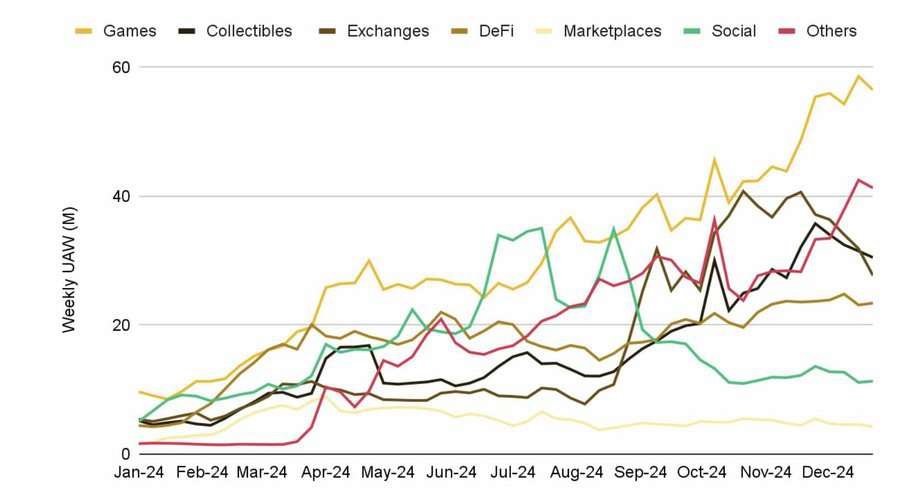
The above metrics highlight the underlying challenge: building sustainable consumer social products remains one of Web3’s toughest challenges. Success in DeSoc requires more than tokenized incentives; it demands strong utility and features that resonate with non-crypto natives. Creator tokenization, which taps into the influencer economy, is currently the most common SocialFi model. Meanwhile, content tokenization — covering media such as blogs, music, and videos — is expected to gain prominence as innovation continues to advance.
On a more positive note, Social dApps built on protocols like Farcaster and Lens have shown more sustainable user growth compared to SocialFi platforms. Farcaster grew from just over 2.5K daily active users (DAUs) in January to 82.5K by June before stabilizing between 40K and 50K DAUs in H2. Lens saw similar growth, climbing from ~6.5K DAUs in January to 30.9K in July, but experienced a sharper decline, ending the year at ~22.3K DAUs.
Figure 106: Both Farcaster and Lens Protocol have stood out as bright spots for Web3 social, experiencing notable growth in DAUs throughout the year
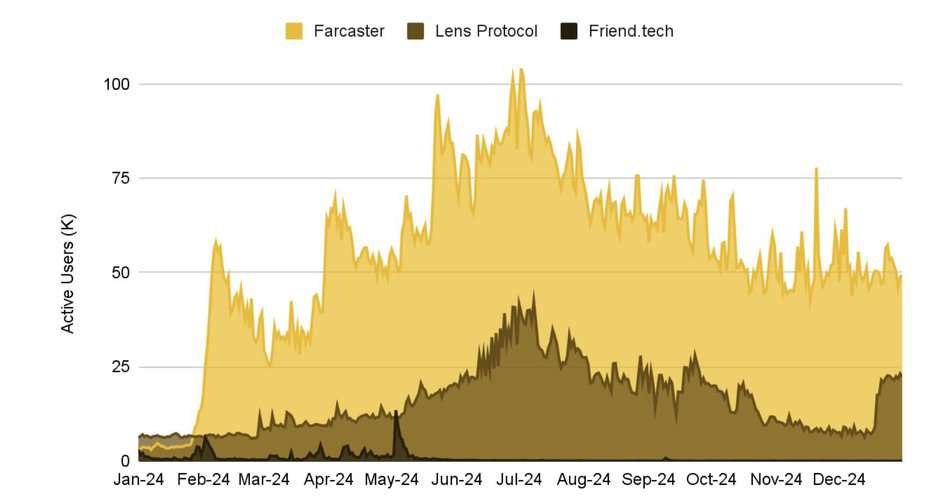
Both platforms rely on modular architectures, enabling developers and creators to launch their own social dApps. However, their go-to-market strategies differ. Farcaster follows a product-led approach through its flagship dApp, Warpcast, acting as a centralized hub for users. In contrast, Lens adopts a developer-led strategy, focusing on protocol development and relying on third-party applications. So far, Farcaster’s product-led strategy has driven stronger user retention.
Perhaps the most interesting trend in 2024 was a shift in DeSoc’s narrative emphasizing developer-centric value propositions such as front-end composability, over traditional user-centric focuses like data ownership. Distribution has become critical, integrating Web3 products into users’ existing online experiences rather than expecting them to navigate Web3’s complexities. This shift has enabled platforms to engage a broader audience by embedding dApps into familiar environments.
Farcaster Frames: Farcaster introduced Frames, a tool that allows mini-apps to be embedded within its front-end, providing seamless distribution channels. Frames let users perform on-chain and off-chain actions, such as minting NFTs or placing bets, directly from their social feeds. Developers can customize user experiences (UX) by leveraging on-chain histories, creating dynamic and personalized interactions.
Blinks (Blockchain Links): Blinks represent a step toward integrating Web3 into the broader internet, enabling users to share on-chain actions like payments or NFT purchases as URLs viewable on any website. This feature reduces transaction friction, making Web3 interactions as simple as browsing or social media scrolling.
Blinks also bring the notion of headless marketplaces for on-chain commerce, particularly for payments, which benefit from crypto’s low fees. Unlike Frames, which is limited to specific platforms like Farcaster and Lens, Blinks extend to Web2 platforms such as X (formerly known as Twitter), Reddit, and TikTok, potentially reaching a much larger audience.
However, Blinks is currently desktop-only and relies on Solana-compatible wallets. Their scalability hinges on broader adoption, but with enough traction, platforms may build native support for Blink transactions, further bridging Web2 and Web3.
Ultimately, Web3 social has achieved some success in retaining crypto-native users but faces challenges in meeting the standards set by Web2 platforms. To appeal to a broader audience, DeSoc dApps must match the UX of Web2 counterparts and ensure low switching costs. For true adoption, DeSoc must focus on everyday users who will ultimately engage regularly with on-chain products. Innovations like Frames and Blinks demonstrate the potential for seamless integration of Web3 into users’ existing digital lives, paving the way for broader adoption as we move into 2025.
Decentralized Physical Infrastructure Networks (DePIN)
DePIN refers to infrastructure projects harnessing blockchain technology and crypto economics to motivate individuals to allocate their capital or underutilized resources towards creating a more transparent, decentralized, and verifiable infrastructure network. The implementation of crypto incentives has enabled DePIN to democratize the buildout of real-world infrastructure, and has emerged as a sector demonstrating tangible real-world use cases.
By leveraging blockchain technology, DePIN projects are making significant advancements in areas such as compute, telecommunication, energy, and others. This approach not only enhances efficiency and transparency but also empowers users by enabling them to participate in and benefit from the infrastructure they use. As a result, the practical applications and potential of DePIN have driven significant interest and investment in the space over the past year.
Projects related to DePIN have been steadily building over the years, leading to the sector’s currently diverse landscape as illustrated in the figure below. Note that the map only showcases a fraction of the DePIN projects. According to data from IOTeX’s DePINscan, there are 249 DePIN projects recorded.
Figure 107: DePIN ecosystem map
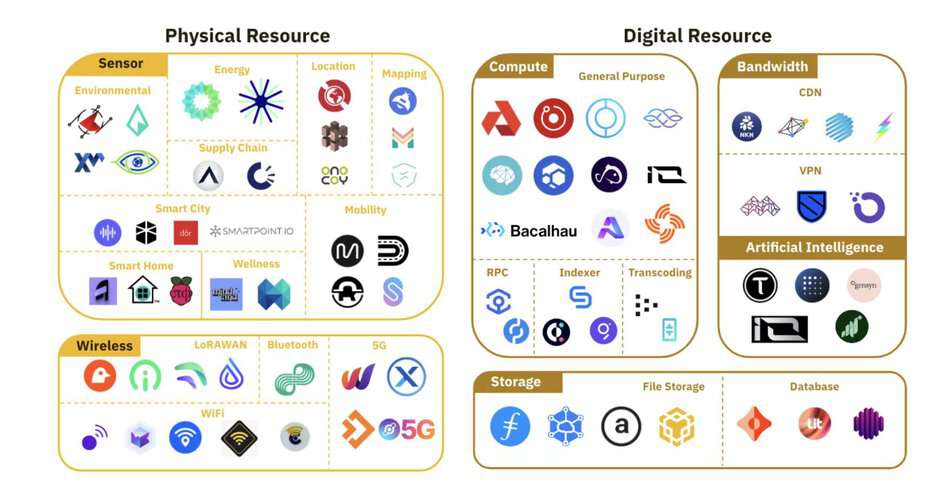
Having a self-reinforcing cycle of growth is key to a sustainable development of a DePIN project. Token rewards act as helpful incentives to overcome the “cold-start” challenge of sourcing for supply-side participants. As the network increases in size, demand should pick up as consumers start to utilize the network’s services. Given that payment for services are usually made in the form of the network’s tokens, the increased adoption should translate into higher token prices, which would further incentivize contributors. With the conconcurrent growth of both demand and supply, this virtuous cycle can perpetuate, sustaining the projects’ continued growth.
Figure 108: DePIN projects aim to foster a self-reinforcing cycle that can sustain their continued growth

However, a key challenge in achieving wide-scale success and scalability for DePIN projects is effectively incentivizing both supply and demand. Incentivizing supply is relatively straightforward — if individuals have underutilized resources and are rewarded with tokens for participating, the motivation to join the network would likely be higher. However, generating demand is more complex, as it requires paying suppliers for their services or products. Therefore, providing tangible use cases and clear value is crucial to attracting paying users and ensuring the sustainability of the network.
While some DePIN projects have gained traction, others are still struggling to generate meaningful revenue, indicating low demand for their services. The figure below shows the top 15 DePIN-related projects by revenue over the last 30 days. It is evident that projects not on this list are likely facing some challenges in attracting paying users, especially considering that the 15 th project earns around US$23K per month.
Figure 109: Top 15 DePIN projects by revenue in the past 30 days
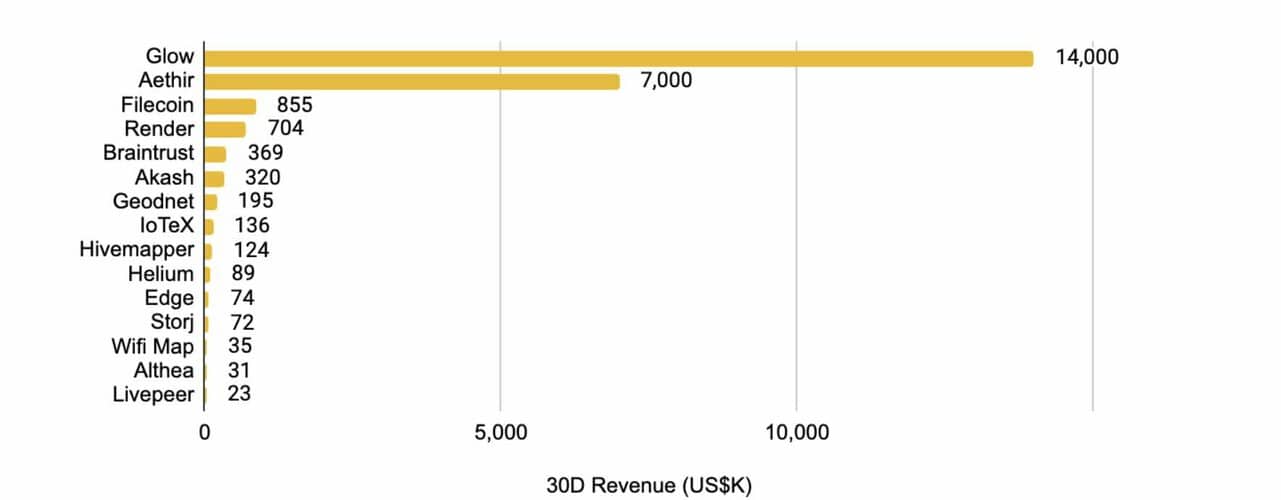
Despite several projects not yet generating significant revenue, investor optimism remains strong. This confidence is driven by the DePIN’s growth potential, given a potentially large addressable market. The relatively high market capitalization to revenue ratios reflect this belief, indicating that investors are willing to bet on the long-term growth and impact of these projects. Even though immediate financial returns may be limited, the strategic value and future prospects of DePIN projects continue to attract substantial investment.
Figure 110: Top 15 DePIN tokens by market capitalization
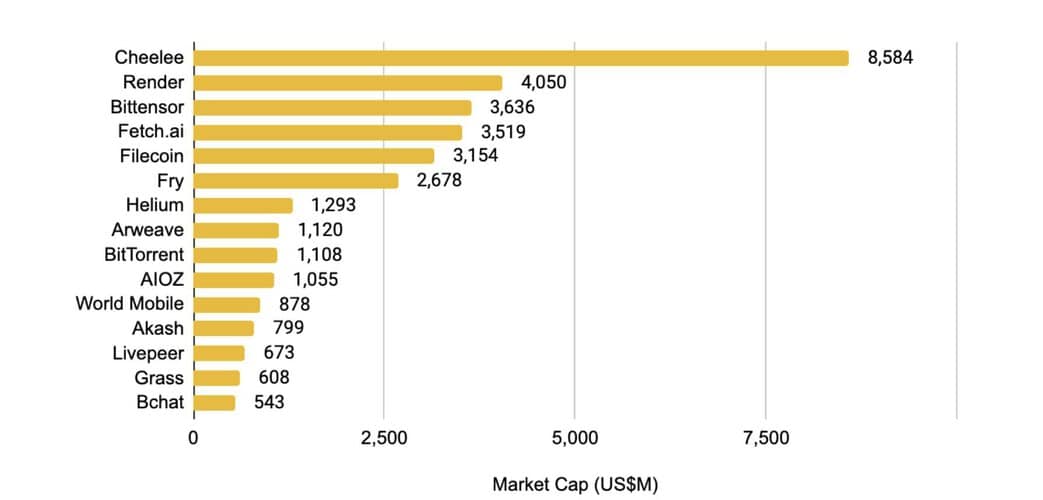
DePIN to coexist alongside traditional infrastructure players: It is unlikely that DePIN can replace traditional networks in the near term, considering that the latter has significant capital resources and established infrastructure. Nonetheless, the ability to enable a sharing economy powered by idle resources, and allowing for last mile coverage in instances where it may not be financially viable for traditional players, DePIN offers a viable solution that augments the current landscape. As such, a more likely scenario is one where DePIN networks coexist with the traditional infrastructure players, supplementing any last mile coverage and providing a solution that allows smaller entities or individuals to participate in the building of infrastructure.
DePIN powering Web2 front-ends: It is undeniable that interacting directly with DePIN may be too technical for the general public, which likely accounts for the relatively slow pace of adoption compared to existing Web2 services. Apart from a focus on improving user experiences and user interfaces, we also expect DePIN projects to work together with traditional players or Web2 companies to expand their reach. In effect, users may interact with a Web2 front-end, unaware that the underlying back-end leverages DePIN and blockchain technology. This could lower the steep learning curve and perceived risks tied to crypto, making the use of DePIN products as user-friendly as those in the Web2 domain, but with the added advantages of cost-efficiency and transparency.
Increased token utility and composability: Most DePIN tokens serve primarily as a medium of payment for accessing project services. While this provides fundamental utility, one of the most compelling aspects of blockchain technology is its composability within the broader on-chain ecosystem, particularly in DeFi. The ability for users to earn additional yield or explore diverse use cases with the tokens they earned could further enhance the appeal of participating in DePIN projects.
Notable examples illustrating this potential are Filecoin’s Filecoin Virtual Machine and BNB GreenField’s inherent integration with the BNB Chain. These projects expand beyond the basic utility of using FIL and BNB solely for data storage, offering users opportunities to engage their tokens in a wider ecosystem. Even though it is still early for these expanded uses, they hint at a potential future direction that could spur the growth and popularity of DePIN projects.
Fundraising Activity & Institutional Adoption
Fundraising Activity
In 2024, there has been a tepid rebound in investment activity within Web3 projects, with a rise in total funding compared to 2023, despite a slight decrease in the number of top-funded projects. The total capital raised by the top 10 projects in 2023 was US$1.8B, while in 2024, it declined to US$1.7B, reflecting a slight decrease of 2.8%. However, this amount remains 71% lower than the total raised by the top 10 projects in 2022. The disparity was very apparent, as even the lowest-funded project among the 2022’s top 10 list secured more capital than the highest-funded project in 2024.
By Q3 2024, over 6% of U.S. venture capital deals were directed toward crypto companies, up from 4% in late 2023, signaling a modest recovery in Web3 investment. This increase, combined with declining interest rates and the potential for a more favorable regulatory environment, suggests that venture activity could accelerate in Q1 2025. Notably, three of the five largest deals were secured in the second half of the year, with Iris Energy, a Bitcoin mining and data center operator, attracting a significant portion of the investment.
Infrastructure continued to dominate as the sector with the most VC interest. In 2024, Web3 projects attracted a total of 1432 investments, amassing a collective capital of US$9.2B.
Of this, nearly US$4B was invested in infrastructure projects, accounting for around 44% of total funds raised in 2024. This was followed by DeFi with US$1.5B (16% of funds raised) and Games with US$0.8B (9% of funds raised). Decentralized Autonomous Organization (DAO) was on the lower end of the spectrum with the least amount of capital invested, accounting for less than 1% of total investments.
Figure 112: Infrastructure projects remain the top category for funds raised in 2024
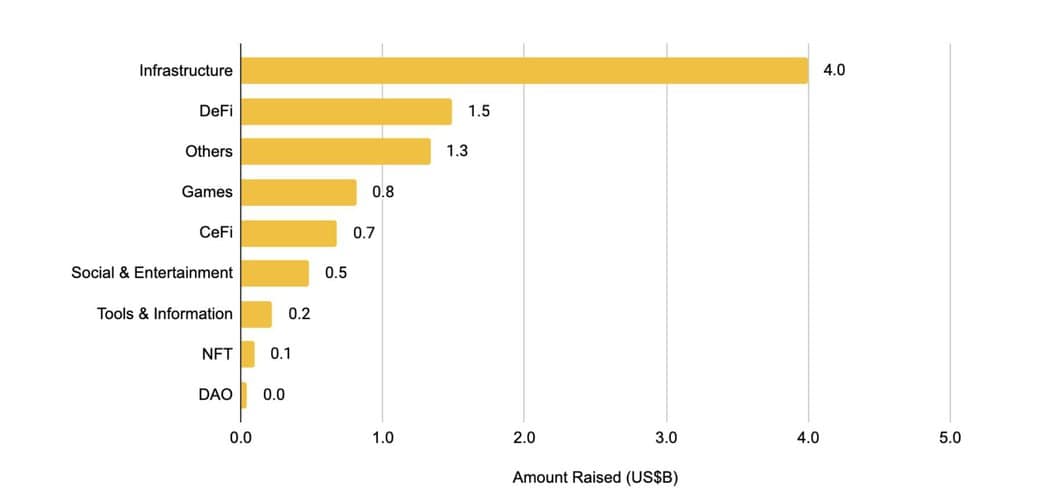
Analysis of investment patterns from some of the leading funds in the space reveals a similar trend.
Figure 113: No. of projects funded in 2024 by VCs

As evident above, VCs funds invested in a total of 424 projects over the course of 2024. These investments were predominantly focused on Infrastructure, DeFi, and NFTs, which comprised 38%, 27%, and 11% of the total deals, respectively. The median crypto-VC fund size continued to decline, with 2024 seeing the lowest median (US$40M) and average (US$67M) new fund size since 2017.
The total number of deals increased by 71% year-on-year, even as total capital raised remained relatively unchanged, highlighting a shift of VC attention toward smaller check sizes or earlier-stage Web3 companies. The average amount raised in 2024 (US$9.2M) represents a 7.7% decline compared to 2023, underscoring this trend.
Institutional Adoption
In 2024, the cryptocurrency market achieved a milestone in adoption, marked by significant involvement from major Web2 companies and TradFi. This shift was further catalyzed by Donald Trump’s victory in the 2024 U.S. Presidential Election, which could potentially pave the way for positive change in the regulatory framework around cryptocurrencies. The resignation of SEC Chair Gary Gensler and the appointment of prominent entrepreneur David Sacks as the ‘AI & Crypto Czar’ in the latter half of the year solidified the growing momentum. Below we highlight some key examples of these collaborations and explore two key milestones of the year: the pivotal legislative reforms surrounding cryptocurrency adoption and the rapid rise of stablecoin assets.
Growing Presence
In the past year, the crypto industry has seen a paramount increase in visibility, captivating public attention.
The Most Interesting Use Cases in 2024
Several pioneering companies have taken the initiative, actively embracing blockchain technology:
In late 2023, Parmigiano-Reggiano (the official Parmesan cheese) began embedding microchips equipped with blockchain-backed tracking to implement real-time inventory control. These tiny micro-transponders, no larger than a grain of sand, are integrated into the cheese’s food-safe casein label, providing a powerful defense against fraud.
In January 2024, HAQQ, an ethics-first blockchain ecosystem, partnered with GoMeat, a digital marketplace for specialty (halal/kosher) meat, to enhance halal meat distribution in the USA.
In March 2024, Covantis, a blockchain-powered agribusiness platform, entered European, Australian, and South African grain and oilseeds markets, as well as the global vegetable oils market, aiming to reduce inefficiencies in global trade. In November, the platform’s upcoming electronic Bill of Lading (eBL) received approval from the International Group of P&I Clubs, marking a significant step toward the digitization of trade documents.
In September 2024, the Australian New-Zealand (ANZ) bank joined the Monetary Authority of Singapore’s Project Guardian to enhance asset tokenisation. ANZ is exploring the use of blockchain technology to tokenize assets like commercial papers, enabling more efficient and secure transactions.
In December 2024, the release of the Australian Tertiary Admissions Rank (ATAR), Australia’s prestigious final high school examination for Year 12 students, showcased its continued reliance on verification powered by the Ethereum blockchain. ATAR results are released using a time-sensitive smart contract, ensuring that they are accessible only after a predetermined release date. Each result document includes a QR code that links to the Ethereum blockchain, enabling instant verification of authenticity.
Adoption by TradFi institutions
We also saw TradFi institutions and government entities actively investing and adopting blockchain technologies:
J.P. Morgan’s blockchain-based platform, Kinexys, has recently processed over US$1.5T in transactions since its inception, averaging more than US$2B in daily transaction volume.
SWIFT has integrated Chainlink’s technology to bridge decentralized and centralized financial systems, enabling secure data transfers between traditional financial networks and blockchain platforms. This collaboration aims to streamline cross-border payments and improve the efficiency of financial transactions.
BlackRock launched the USD Institutional Digital Liquidity Fund ($BUIDL), a tokenized money market fund on Ethereum. This on-chain fund enables investors to access liquidity in a digital format, leveraging blockchain technology for enhanced transparency and efficiency.
Franklin Templeton introduced the Onchain US Government Money Fund ($FOBXX), another tokenized money market fund. This fund utilizes blockchain to offer investors a secure and efficient means of investing in U.S. government securities.
Mastercard’s Multi-Token Network (MTN) connected to J.P. Morgan’s Kinexys Digital Payments to streamline cross-border B2B transactions. This integration facilitates faster and more secure international payments between businesses.
Blockchain From An International And Legislative Perspective
In 2024, blockchain legislation advanced with unprecedented momentum. Countries acquired cryptocurrency-based assets, analyzed the feasibility of Central Bank Digital Currencies (CBDCs), and refined regulatory frameworks. By March 2024, over 130 nations had initiated CBDC research, three launched CBDCs, and 36 implemented pilot programs. This surge marks a pivotal moment for cryptocurrencies, a clear inflection point in the evolution of the inefficient global payments system. The exploration of CBDCs confirms the anticipated product-market fit of blockchain technology on a globally regulated scale, transforming cross-border value exchange with greater efficiency, security, and inclusivity.
The Power Of A CBDC — Unified Digital Currency Systems
A Central Bank Digital Currency (CBDC) is a digital version of a nation’s fiat currency. Instead of printing physical money, the central bank issues electronic coins or accounts, fully backed by the government’s trust and credit.
A CBDC, thus, can offer several specific benefits. They can enhance financial inclusion by providing a government-backed digital payment option accessible to those without traditional bank accounts. CBDCs reduce transaction costs by eliminating intermediaries, making payments more affordable while improving efficiency with real-time domestic and cross-border transactions. Their digital nature increases transparency and security, aiding in the prevention of illicit activities and safeguarding the financial system.
Additionally, CBDCs can enhance real-time payments (payments that settle instantaneously) for both national and international financial systems.
Global Progress in CBDC Research and Development
The United States of America is experimenting with two projects:
‘Project Cedar’ is a wholesale cross-border CBDC initiative led by the Federal Reserve Bank of New York and the Monetary Authority of Singapore, exploring how distributed ledger technology (DLT) can improve multi-currency payments’ interoperability and speed, with a focus on 30-second atomic settlement.
‘Project Hamilton’ is a collaboration between the Federal Reserve Bank of Boston and MIT’s Digital Currency Initiative, focusing on developing a digital dollar prototype capable of processing up to 1.7 million transactions per second, aiming for fast and efficient payments.
First piloted in 2019, China’s digital yuan (e-CNY), has rapidly expanded, with over 260 million wallet users and 7 trillion yuan (US$982B) in transactions by June 2024. It is being tested across various sectors, including retail, healthcare, and tourism. Furthermore it was integrated with Hong Kong’s Faster Payments System for cross-border use. The People’s Bank of China (PBoC) has also initiated the mBridge project, collaborating with central banks in the UAE, Thailand, and Hong Kong to facilitate cross-border digital payments.
Australia’s Reserve Bank launched a CBDC pilot (eAUD) in 2023 to test use cases such as cross-border payments, offline payments, and corporate bond settlements. In November 2024, the Reserve Bank of Australia (RBA) and the Digital Finance Cooperative Research Centre (DFCRC) launched Project Acacia to explore how digital currencies and related infrastructure can support wholesale tokenised asset markets in Australia.
Nigeria launched the e-Naira in 2021 as Africa’s first digital currency, with the aim of enhancing financial inclusion, improving accountability in the informal sector, and facilitating remittances. The central bank has minted 3B e-Naira, with 2.1B issued to financial institutions. As of March 2024, efforts to boost adoption are ongoing, including a partnership with blockchain firm Gluwa to improve the technology.
Jamaica launched its retail CBDC, JAM-DEX, in July 2022 after a successful trial in 2021. Developed with eCurrency Mint, it is available via the Lynk app. The Bank of Jamaica incentivized usage through programs for merchants and wallet holders, and plans to upgrade 10,000 POS systems by 2024. JAM-DEX aims to reduce cash handling costs, potentially saving US$7M annually.
Global Progress in Blockchain Regulation And International Acceptance
G20 Countries: In 12 G20 nations (57% of global GDP), cryptocurrencies are fully regulated. This means that all activities related to cryptocurrencies — such as buying, selling, trading, and using them for payments — are permitted under the law without significant restrictions, if licensed or registered. Furthermore, all G20 countries are considering regulatory frameworks for crypto. Adoption rates are weakly correlated with regulatory restrictiveness.
2024 as a Critical Year: Countries like Australia, the UK, Brazil, and South Korea are set to release new crypto regulations, with 70% of countries studied making significant regulatory changes.
Comprehensive Regulation: Only 19 of 60 countries have regulations covering taxation, anti-money laundering, counter-terrorist financing, consumer protection, and licensing. Among emerging-market countries, only 13% have comprehensive regulations.
CBDC Development: Over 90% of the countries analyzed are actively pursuing Central Bank Digital Currency (CBDC) projects while also updating cryptocurrency regulations.
Figure 114: Number of countries and currency unions exploring CBDCs
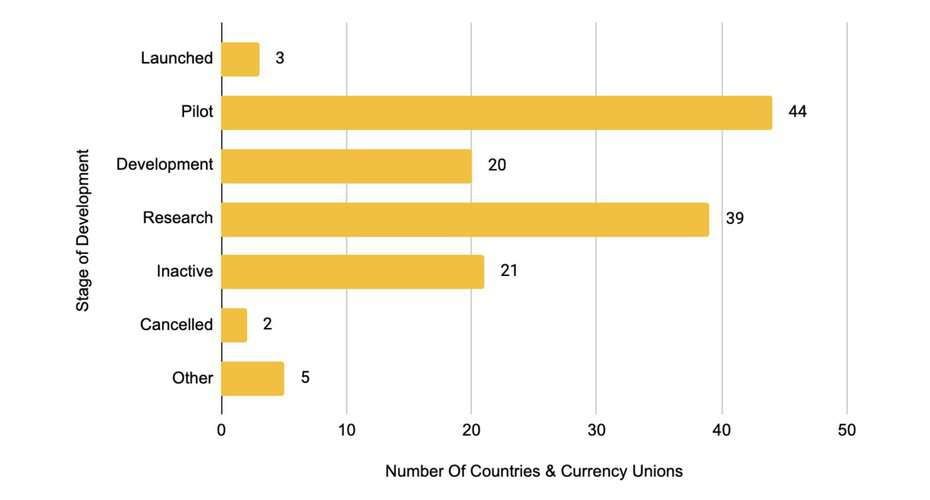
The Proliferation of Payments & Stablecoins
Stablecoins — digital currencies pegged to stable assets like the U.S. dollar — have experienced remarkable growth, with their market capitalization soaring from single-digit billions in 2020 to over US$204.5B today. This surge reflects their expanding role in the global financial ecosystem. On average, more than US$54B are lost each year due to international transaction fees, with nearly 6.4% of each transaction going toward fees charged by Automated Clearing House (ACH) partner banks.
Notable Events In The Landscape Of Stablecoins
Stripe’s Acquisition of Bridge: In October 2024, Stripe announced the acquisition of stablecoin infrastructure startup Bridge for US$1.1B. This strategic move aims to enhance Stripe’s capabilities in processing stablecoin payments, integrating Bridge’s technology into Stripe’s existing payment platforms.
Ripple’s Launch of RLUSD Stablecoin: Ripple introduced RLUSD, a stablecoin fully backed by U.S. dollar deposits, government bonds, and cash equivalents. This launch positions Ripple to offer a stable and reliable digital asset, with plans to make RLUSD available on global exchanges such as Uphold, Bitso, MoonPay, Archax, and CoinMENA.
PayPal’s First Commercial Payment with PYUSD: In September 2024, PayPal conducted its first commercial transaction using its stablecoin, PYUSD, by sending a payment to Ernst & Young via SAP’s digital currency platform. This transaction underscores PayPal’s commitment to integrating stablecoins into its payment systems, aiming to provide faster and more reliable cross-border transactions.
Increased Stablecoin Transactions in Western Europe: Data from Chainalysis indicates that stablecoins dominated crypto transactions in Western Europe, averaging a 52.36% share of transactions between July 2022 and June 2024. This trend highlights the growing preference for stablecoins in the region, reflecting their role in facilitating stable and efficient digital transactions.
Latin America’s Adoption of Stablecoins: Latin America emerged as the second-fastest region in crypto adoption, with a year-over-year growth rate of approximately 42.5%. Countries like Argentina, Brazil, and Venezuela have seen significant stablecoin usage, driven by factors such as inflation and economic instability, leading individuals and businesses to seek more stable digital assets.
Stablecoins From A Regulatory Perspective
European Union (EU): The EU’s Markets in Crypto-Assets (MiCA) regulation covers all crypto-assets except NFTs and fully decentralized services. Stablecoin issuers must be registered entities within the EU to gain authorization. Reserves must be segregated in credit institutions, and redemptions must occur in a timely manner.
United States (US): The proposed Lummis-Gillibrand Payment Stablecoin Act focuses on fiat-linked payment stablecoins. Issuers must be registered with the Federal Reserve or be depository institutions with authorization to issue stablecoins. Payment stablecoins must maintain 100% reserves, and redemptions must occur within a set period.
United Kingdom (UK): The UK’s Financial Conduct Authority (FCA) plans to regulate fiat-backed stablecoins under its Payment Services Regulations. Issuers will need FCA authorization to issue stablecoins in or from the UK. Reserves must be liquid, stable, and sufficient to ensure prompt redemption.
United Arab Emirates (UAE): The UAE’s Payment Token Services Regulation applies to fiat-linked payment tokens and requires issuers to be incorporated within the UAE. Reserves must be held in escrow accounts in the same currency as the token, with segregation requirements. Redemption must occur within five business days.
Japan: Japan’s Payment Services Act regulates fiat-linked stablecoins, allowing issuance only by banks, fund transfer service providers, and trust companies. Stablecoin reserves must be managed as demand deposits. Redemptions must be completed in a timely manner without a specific window.
Singapore: Singapore’s Monetary Authority (MAS) has a regulatory framework for stablecoins linked to the Singapore dollar or G10 currencies. Issuers must hold reserves in escrow accounts with Singapore-licensed banks and maintain sufficient backing assets. Redemptions must be initiated by the next business day unless extended by the Central Bank.
Themes for 2025
Looking ahead, we are delighted to see the market’s remarkable performance in the past year and are optimistic about the following themes for 2025:
1. Spot ETF Boom: Driven by increased inflows and the potential introduction of new ETF products, we expect a banner year for crypto ETFs in 2025. As crypto prices reach new highs and gain further mainstream attention, ETF flows are expected to surge. In 2024, BTC and ETH ETFs saw inflows of US$35.2B and US$2.7B, respectively, and these figures have the potential to rise even higher.
Additionally, more institutional investors, including wealth managers, companies, and family offices, are likely to explore exposure to cryptocurrencies through ETF vehicles. We also expect the approval of a broader range of ETFs with exposure to various crypto assets, as evidenced by recent applications for XRP and SOL ETFs. This trend will further solidify the role of ETFs in providing accessible and diversified investment opportunities in the crypto market.
2. Shifting Token Value Models: With a more crypto-friendly U.S. administration and the prospect of greater regulatory clarity, the scope of value sharing by on-chain applications is expected to expand significantly. This shift is likely to usher in a ‘dividend era’, where more projects distribute value to token holders through treasury funds or revenue-sharing models, increasing the attractiveness of native tokens.
This trend is already evident in DeFi, with leading dApps like Ethena and Aave initiating discussions or passing proposals to implement fee switches – mechanisms that allow protocols to share revenue directly with users. Even previously resistant protocols, such as Uniswap and Lido, may reconsider their stance as regulatory clarity improves and competitive pressures for value accrual of tokens increase. If these developments continue, they could reshape token demand in sectors like DeFi, where protocol revenue has historically not been shared with token holders.
The shift toward improved value accrual is also beginning to impact AI-related tokens, which have traditionally lacked robust mechanisms for aligning value with token holders. Signs of change are emerging, with an increasing number of projects exploring token burns and revenue-sharing models in 2025. These mechanisms create a direct feedback loop between the product, token, and its holders. Additionally, many projects are expected to deepen the integration of their tokens within their ecosystems, enhancing utility and driving sustainable demand.
3. BTCFi to Push Ahead: Despite being the largest crypto asset by market cap, Bitcoin remains largely underutilized within DeFi, leaving significant room for growth. The BTCFi narrative has started gaining traction this cycle, fueled by Bitcoin’s strong market performance and increasing institutional interest through spot BTC ETFs. These factors have led to the accumulation of idle BTC holdings, creating opportunities to convert them from capital-inefficient to capital-efficient assets. While the current focus is on staking derivatives and lending, this trend is expected to extend into other DeFi use cases. With Bitcoin DeFi TVL growing by over 2,000% from US$0.3B to over US$6.5B in 2024, the wheels have already started turning. Any upcoming traction on Bitcoin covenants and Bitcoin Improvement Proposals (BIPs) will also be an important determinant.
4. Yield-Bearing Stablecoins Gain Steam: Stablecoins are expected to experience significant growth, driven by increased adoption from Web2 companies and greater regulatory clarity. This favorable environment will likely benefit most stablecoins, as a rising tide lifts all boats. Among these, yield-bearing stablecoins are anticipated to gain particular prominence, as evidenced by the rapid rise of Ethena’s USDe. The demand for yield remains strong, and yield-bearing stablecoins offer a straightforward way for holders to earn returns on their stablecoin holdings without requiring active management or complex strategies.
However, the success of yield-bearing stablecoins will not solely depend on their ability to generate yield. For these stablecoins to thrive, they must also ensure widespread availability across various platforms, provide easy on and off-ramp methods, and maintain deep liquidity.
5. AI x Crypto Is Key To Watch: AI and crypto are two of the key technological movements of this generation and the recent AI agent boom has sparked a fresh level of cross-pollination and collaboration within the “AI x crypto” sector. The growth of the AI agent sub-sector has exceeded expectations thus far and significant levels of development is expected in the next few months, including the entry of web2 giants like OpenAI. In addition, there are many top crypto AI teams working on projects outside of the AI agent space, with fresh traction being seen for a variety of these. The technologies of crypto and AI are undoubtedly on a collision course and we expect 2025 to be a meaningful year in this journey.
6. Rising Importance of Layer 2 Abstraction: The post-Dencun surge in Layer 2 (L2) solutions has contributed to the growth of L2s. There are now over 120 L2s in various development stages. As the L2 space matures, it is crucial for L2 chain abstraction to become commonplace, simplifying the user experience as the proliferation of appchains and specialized L2s continues.
We expect competition to continue to intensify within the L2 ecosystem, especially amongst rollup-as-a-service providers and L2 aggregators emerging as major brands, vying to create the most widely-used and diverse cross-chain ecosystems.
7. Tokenization Sees Growing Interest from TradFi Players: Major asset managers like BlackRock and Franklin Templeton have already tokenized their money market funds, while Goldman Sachs plans to launch a crypto trading platform focused on tokenization within the next 12-18 months. The Monetary Authority of Singapore’s “Project Guardian” is also pushing forward, with financial institutions like JP Morgan, HSBC, and Deutsche Bank working to expand asset tokenization into capital markets.
A survey by SBI Digital Assets Holdings of over 50 financial institutions in Asia found that lower issuance costs, shorter settlement periods, and the potential to access new or global capital were key influencing factors in investing in tokenized securities. Real estate emerged as the most preferred asset for tokenization, followed by funds, physical infrastructure, and bonds (118) . This growing interest highlights the potential for tokenization to revolutionize asset management and drive further institutional adoption.
8. More Token Launches by NFT Projects But Not All Will Succeed: Pudgy Penguin’s issuance of its PENGU token drove NFT trading volumes to new highs, showcasing the power of token launches to capture market attention. This success has also sparked speculative demand across other prominent NFT collections, as traders anticipate further token launches that could similarly boost activity and interest.
Successful token launches have the potential to attract new participants and serve as a positive catalyst for the NFT market, which has been relatively stagnant. However, sustaining long-term interest and prices remains a significant challenge. Projects must continuously develop their ecosystem and enhance token value accrual to maintain momentum.

